Nick Garbutt Wildlife Worldwide Photography Tours
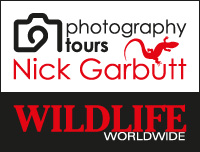 I run an exclusive programme of wildlife photography tours and workshops in partnership with top UK operator Wildlife Worldwide.
I run an exclusive programme of wildlife photography tours and workshops in partnership with top UK operator Wildlife Worldwide.
Our aim is to offer unmatched experiences that maximize opportunities to photograph and watch wildlife in the finest locations. And to help participants improve their techniques and achieve the best results from their photography, irrespective of their level of experience.
Itineraries are carefully designed, with locations chosen to offer the best photographic opportunities, with time to get the most from each location.
![]() The binocular icon denotes a tour that is also suitable for those more interested in watching and enjoying wildlife, rather than concentrating principally on photography.
The binocular icon denotes a tour that is also suitable for those more interested in watching and enjoying wildlife, rather than concentrating principally on photography.
Current Tour Availability
- YELLOWSTONE: Wild West Winter Wonderland, January 2025, 3 places remain: please enquire
- INDIA, LADAKH: Searching for Snow leopards, February 2025, 2 places remain: please enquire
- SOUTHERN SERENGETI: The Great Migration, March 2025, 1 single place remains: please enquire
- AUSTRIA: Close-up on Alpine Nature, June 2025, places remains: please enquire
- PATAGONIA: Pumas, Condors and Landscapes in Winter, July 2025, 1 single place remains: please enquire
- PERU: Amazon's Secrets, Magnificant Manu, Rainforest Workshop, Sept 2025, 6 places remain: please enquire
Photography Tours Schedule
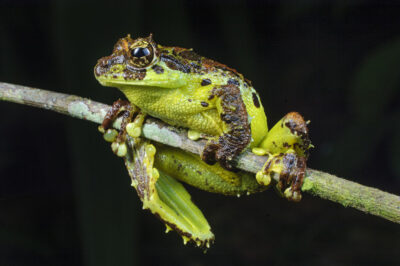
The mossy bush frog is a montane forest specialist, sometime found on night walks in Kinabalu Park © Nick Garbutt
Dates: 15th September - 3rd October 2024
Price: £11,995 (Twin-share: Flights inclusive)
Price: £10,995 (Twin-share: Land Only)
Single Supplement: £1960
Maximum Group 12
Current Availability: FULL
LEADERS: Nick Garbutt & Alex Hyde
 GRADING: Moderate. A variety of conditions from hot, humid lowland rainforest (Danum Valley), to cooler montane forests (Mt Kinabalu). Walks are generally short to medium length (1-3km), but hills can be moderate to steep with uneven under foot conditions in both lowland and montane forest areas. Both early morning and late evenings as there are night walk options.
GRADING: Moderate. A variety of conditions from hot, humid lowland rainforest (Danum Valley), to cooler montane forests (Mt Kinabalu). Walks are generally short to medium length (1-3km), but hills can be moderate to steep with uneven under foot conditions in both lowland and montane forest areas. Both early morning and late evenings as there are night walk options.
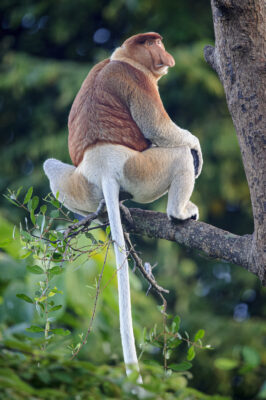
Groups of proboscis monkeys are one of the highlights along the Kinabatangan River © Nick Garbutt
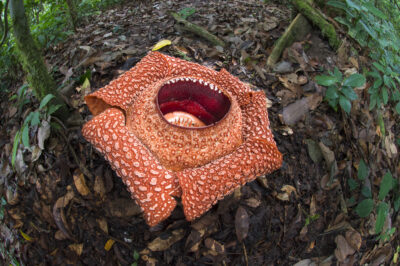
The giant Rafflesia can sometimes be seen on the lower slopes of Mount Kinabalu © Nick Garbutt
Few places conjure more evocative images of mystery than Borneo. Its varied rain forests are amongst the most diverse on the planet and are home to some of the most charismatic and well-known ‘jungle’ species. Perhaps most renowned are two extraordinary primates; the fabled orang-utan, literally "Man of the Forest", and the improbable proboscis monkey. There are also a host of other primates too, like cheeky long-tailed macaques and elegant leaf monkeys. Add to these, pygmy elephants (the world’s smallest), spectacular rhinoceros hornbills, several species of pitta - exquisite jewel-like birds, a myriad of tree frogs and some of this natural wealth becomes apparent.
Focusing on three of the most diverse locations, Mount Kinabalu, the Kinabatangan River and Danum Valley, we will explore in considerable depth these enchanting cloud forests and rain forests and have an excellent chance to see and photograph many of the island's iconic species.
Rising like a citadel, Mt Kinabalu, the highest peak on the island, is a montane 'oasis' that supports a wealth of high elevation specialists. In these forests grow a profusion of pitcher plants and Rafflesia, the world's largest flower. The upland cloud forests are a macro photographers paradise, with a myriad of unusual invertebrates, frogs and reptiles.

The Kinabatangan River is one of the finest wildlife areas on Borneo © Nick Garbutt
The Kinabatangan River is one of the most important wildlife sites in SE Asia. It is a mosaic of natural riverine forest, mangrove and nipah palm habitat, that supports an extraordinary diversity of wildlife. It is perhaps the best place to see and photograph proboscis monkeys and is also very good for orange-utans, other primates and pygmy elephants. Birds, frogs and reptiles also abound. We will stay at two different lodges that each offer different and varied photographic potential.
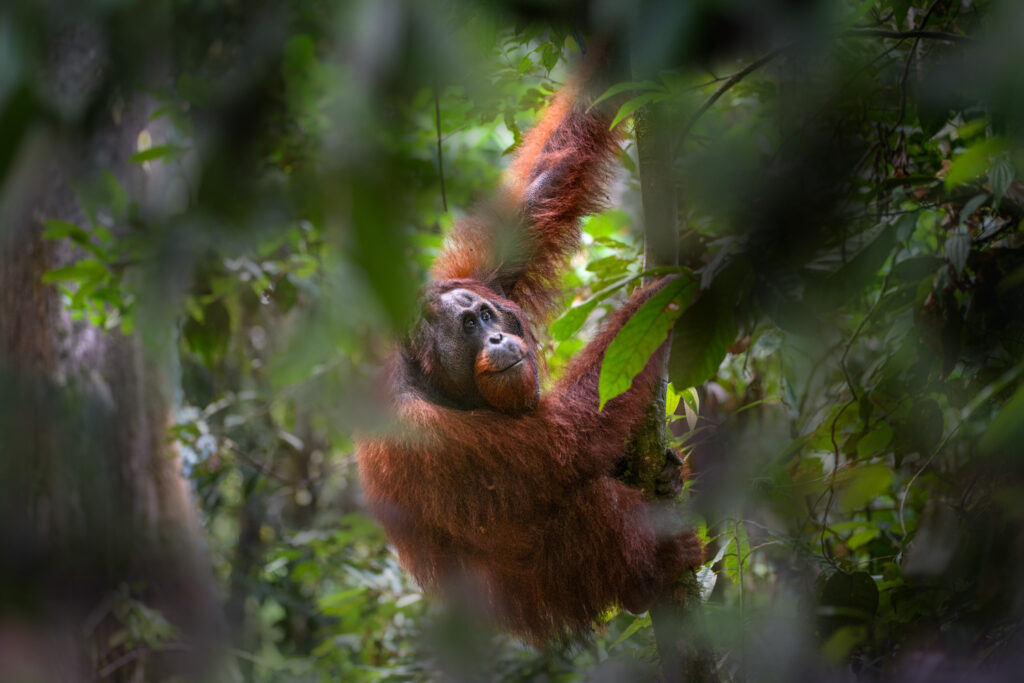
A magnificent dominant flanged male Orang-utan in Danum Valley © Nick Garbutt
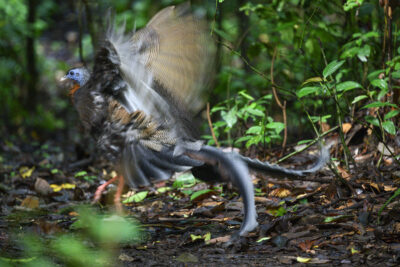
With luck, the spectacular Great Argus Pheasant can be seen in Danum Valley © Nick Garbutt
Many regard Danum Valley as Borneo’s premier wildlife location. The combination of untouched primary rainforest brimming with wildlife and a wonderful lodge in an exceptional setting is remarkable. So many of the major sought-after species, like orang-utans and red leaf monkeys are seen in the forests immediately around the lodge. The extensive and well maintained trail network allows access to all forest areas, where so many varied exciting animal encounters and photographic opportunities occur.
There is also scope for numerous exciting night walks in all locations, with Danum Valley being particularly good for this. At night a completely different cast of characters become visible; there are numerous frogs, lizards and reptiles, bizarre invertebrates and if fortune favours, endearing primates like the western tarsier and slow loris and other mammals such as, mouse deer, colugo and different species of giant flying squirrel.
In combination the locations we visit offer a window in to the natural splendour of Borneo and provide a wide range of opportunities to experience and photograph the island's incomparable wildlife.
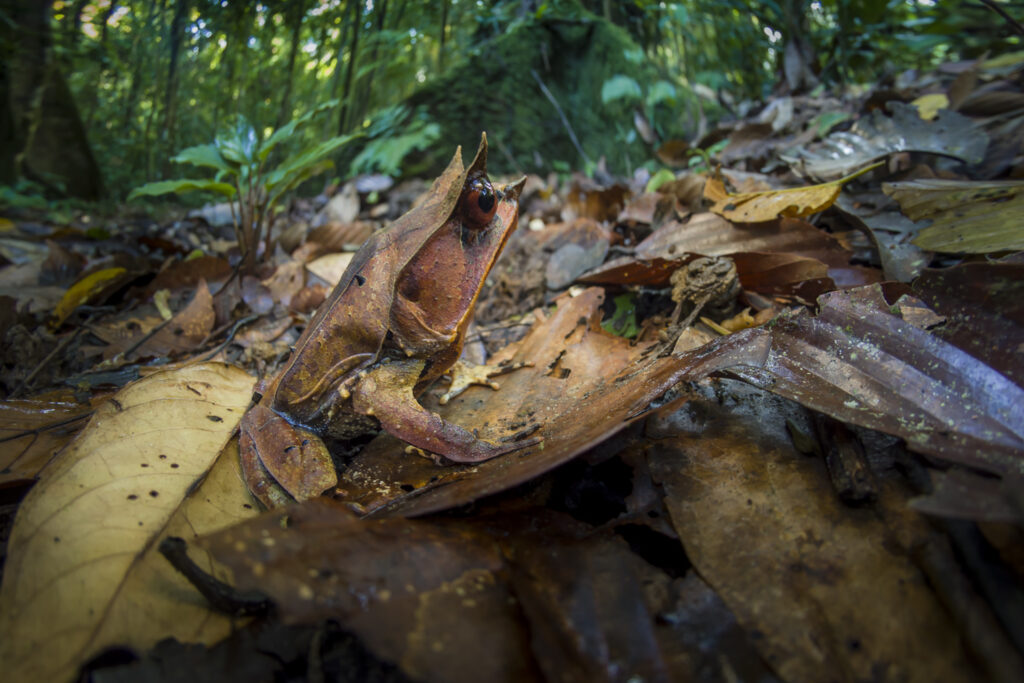
The magnificently camouflaged Bornean horned frog is a potential highlight in Danum Valley @ Nick Garbutt
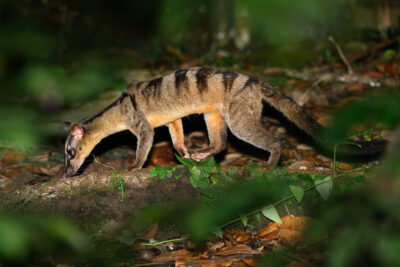
A banded civet at night, Danum Valley © Nick Garbutt
Why a Workshop?
Tropical rain forests are the greatest expressions of life on the planet and offer a wonderful array of species, but they are also amongst the most challenging places to take photos successfully.
For this workshop tour, hosted by two leaders with a wealth of rain forest photography experience, we have chosen extended stays in Borneo's two premier wildlife locations to maximise the photographic potential and teaching opportunities, so that participants gain as much insight as possible.
Rain forests in Borneo can be particularly hot and humid, so we have chosen lodges that best cater for comfort in our chosen locations, but that also offer excellent immediate access to the forest and create a convivial atmosphere.
 Photography Equipment
Photography Equipment
A variety of equipment is useful, from close focus wideangle e.g. 16-35mm, to macro e.g. 105mm, to telephoto, e.g. telephoto zoom 100-400mm to cover most situations with invertebrates, frogs, reptiles and primates. Flash equipment very useful. A longer telephoto e.g. 500mm or 600mm is good for birds and sometimes primates. Waterproof protection for camera gear is recommended. A tripod is advisable.
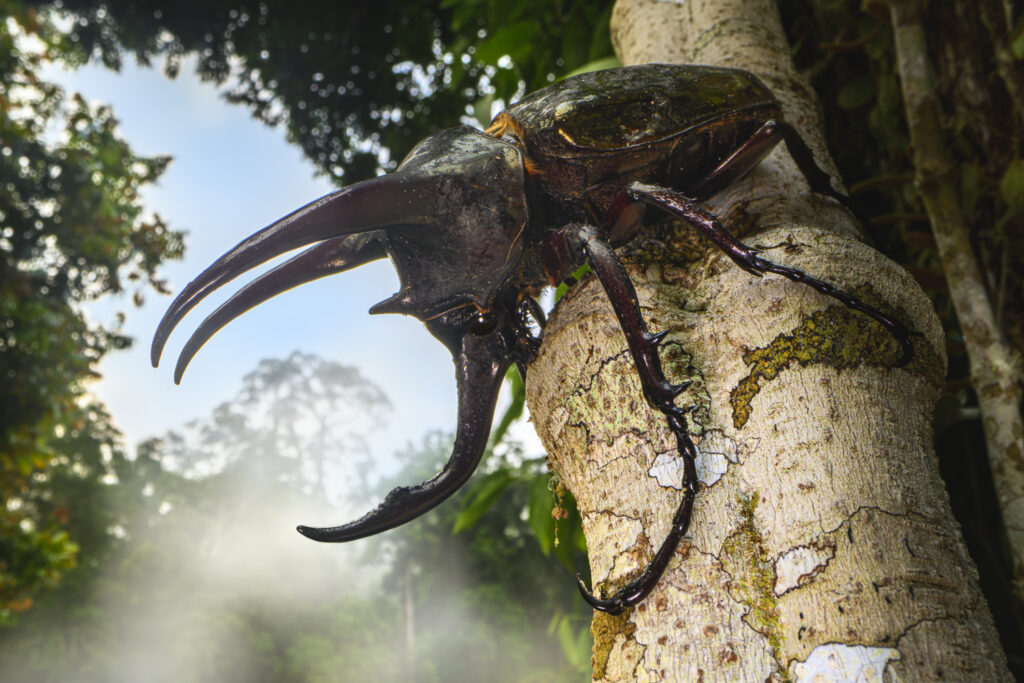
Macro subjects like this atlas three-horned rhinoceros beetle are an important component of any rainforest workshop © Nick Garbutt
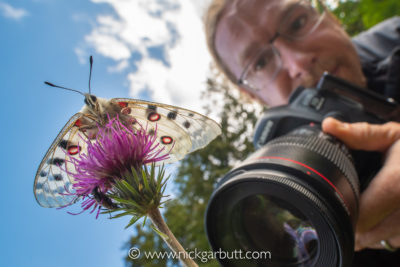
Alex Hyde is arguably the UK's best macro photographer
Alex Hyde
I am delighted to be joined by good friend Alex Hyde on this trip. Alex is one of the UK's finest exponents of macro photography, combining the best of art and science into his exquisite images. He is a master of the technical aspects of digital photography and in the field or indoor workshop environment has the enviable skill of being able to convey challenging topics and ideas, concisely, simply and in a way that makes them understandable. To see more of Alex's stunning work click here
Click: contact Wildlife Worldwide to book this tour
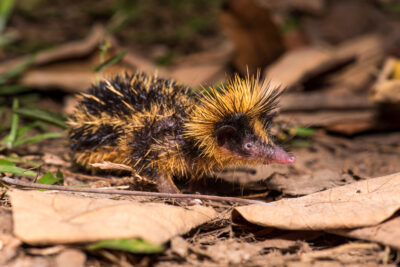
After dark Madagascar's forests are alive with unusual species like this lowland streaked tenrec © Nick Garbutt
 Dates: 15th October - 4th November 2024
Dates: 15th October - 4th November 2024
Price: £12,995 (Twin-share: Flights inclusive)
Price: £12,095 (Twin-share: Land Only)
Single Supplement: £ please enquire
Maximum Group 6
Current Availability: FULL
Click for further details
 GRADING:
GRADING:
Varied conditions from hot (sometimes very hot, over 38°C), dry forest (north, west and south), to cooler mid-elevation rainforests (east). Remote locations are basic. All wildlife watching and photography on foot. Walks generally short to medium length (1-3km), but occasionally longer, inclines can be steep with uneven footing, especially in rainforest regions. Early mornings (before 5am) and late evenings as there are night walk options. Lots of internal travel by road and air. Roads often very poor.
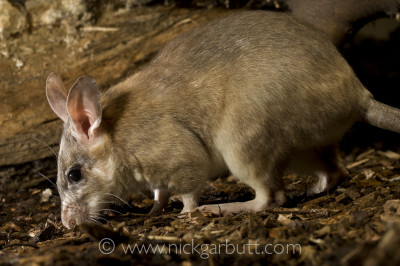
Giant Jumping Rat
A new itinerary to Madagascar featuring a number of less frequently visited and more remote protected areas, as well as some well-known locations. This tour will offer the chance to focus on and see a selection of the island’s most weird and wonderful mammals, as well as a broad cross-section of the more familiar lemurs.
The tour will encompass the three major habitat types on the island - eastern rainforest, western deciduous forest and southern spiny forest - all of which are home to their own array of bizarre endemic species. Of course lemurs, the island’s ‘flagship’ mammals, will feature strongly at all times, but we also hope to see some of Madagascar’s enigmatic carnivores, unusual rodents and peculiar tenrecs.
Perhaps more than any other habitat, the spiny forests encapsulates the ‘other worldly’ feel of Madagascar. Here, the extreme aridity has helped fashion trees with tentacle-like branches sporting vicious spines and others that develop grotesquely swollen and convoluted trunks. Here live extremely familiar species like the ring-tailed lemur and Verreaux's sifaka, but also rare oddities like Grandidier’s vontsira (a small carnivore).
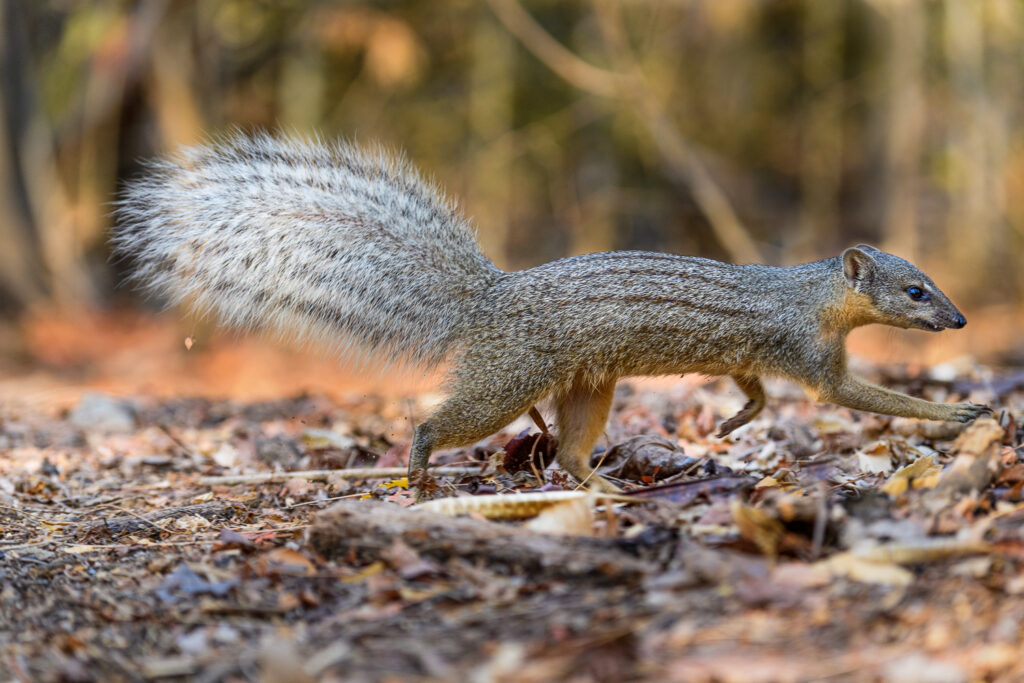
The narrow-striped boky is one of the island's endearing small carnivores and is restricted to a small area in the west © Nick Garbutt
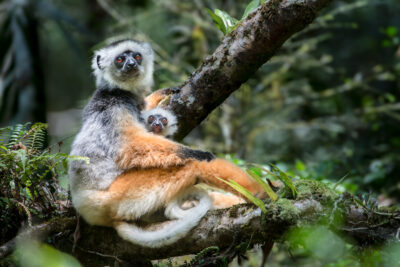
The diademed sifaka is arguably the most beautiful of all lemurs. Seen here in Andasibe-Mantadia National Park © Nick Garbutt
The deciduous forests on the west side of the island are different again and support a more varied but equally unusual cast of characters. These forests are the best place to look for the fosa, Madagascar’s largest carnivore that combines feline traits with those of civets and mongooses. More dainty is the boky-boky or narrow-striped vontsira, another endearing and rare small carnivore. There is also the nocturnal giant jumping rat, in appearance less a rodent and more like a rabbit crossed with a miniature kangaroo.
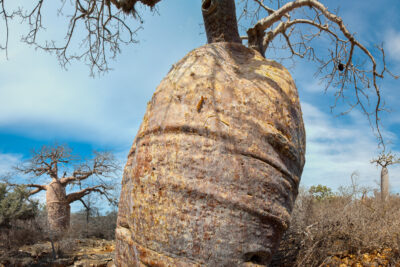
Bizarre bottle baobabs in Lac Tsimanampetsotse National Park © Nick Garbutt
The forests of the west are also sometimes dominated by baobabs: on mainland Africa there is just one species, but on Madagascar there are six species, some tall, statuesque and imposing, others squat and rotund. In some areas deciduous forests grow around outcrops of limestone that have been sculpted over the millennia into fortresses of razor-sharp pinnacles, known as 'tsingy' in Madagascar. Here sifakas, and other lemurs, are able to move effortlessly over the rocks traversing between forest patches.
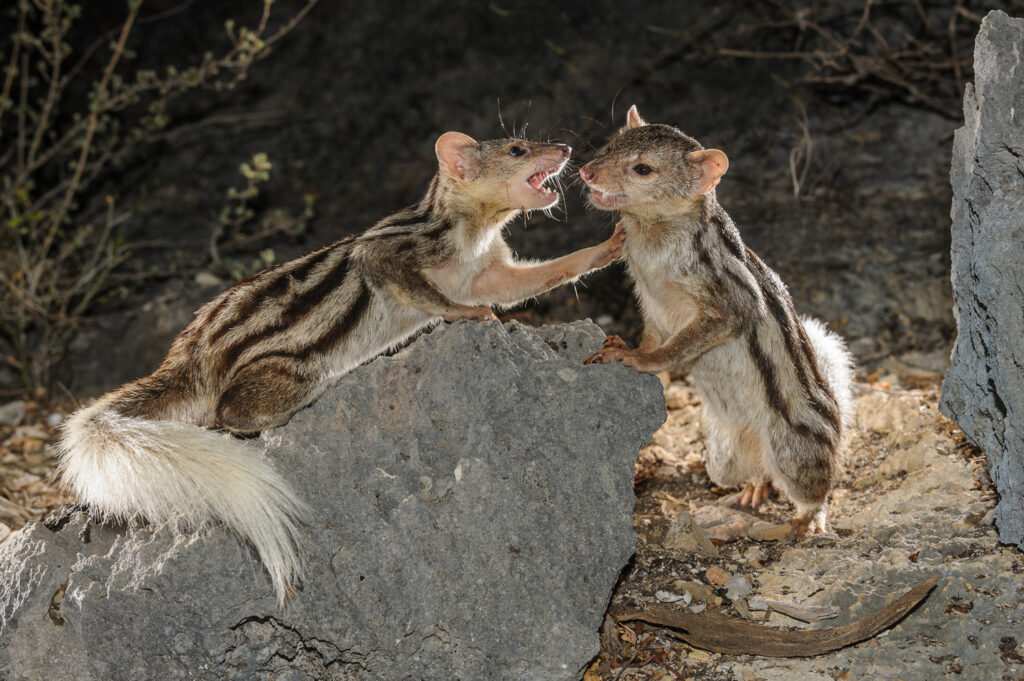
In the 'other-worldly' habitats of Tsimanampetsotse National Park lives the very rare Grandidier's vontsira © Nick Garbutt
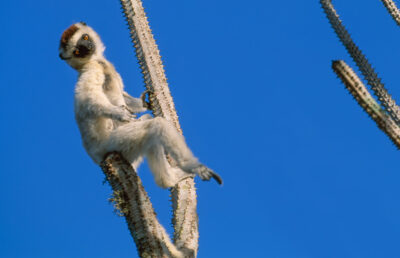
A Verreaux's sifaka in spiny forest © Nick Garbutt
Wherever they occur, tropical rainforests are the most profuse expressions of life. This is certainly true in Madagascar, where the rainforests of the east are home to a vast array of endemic species. Here lives the stunning beautiful diademed sifaka and the charismatic teddy-bear-like indri, famous for its haunting song. After dark, there is a different night shift, when woolly lemurs, mouse lemurs and dwarf lemurs become active. On narrow branches it is sometimes possible to find nimble tufted-tailed rats, while in the leaf-litter hedgehog-like tenrecs may be found bumbling around looking for worms and other invertebrates.
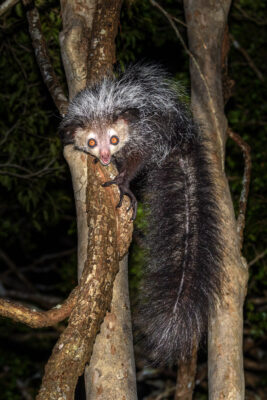
There is a reasonably good chance of seeing the incredible aye-aye in the forests near Daraina © Nick Garbutt
And there is so much else to see besides. In all locations there is always an array of endemic birds to look out for like vangas, ground rollers and couas, as well as numerous different brightly coloured and superbly camouflaged chameleons, which always delight.
With the emphasis very much on weird and endearing mammals, the itinerary for this very special tour will definitely offer a very different cross-section of experiences to more 'regular' tours to Madagascar.
 Photography Equipment
Photography Equipment
A variety of equipment is useful, from close focus wideangle e.g. 16-35mm for forest scenes, to macro e.g. 105mm for chameleons, frogs and insects, to telephoto, e.g. 100-400mm for lemurs and birds. Flash equipment very useful. A tripod is advisable.
Click: contact Wildlife Worldwide to book this tour

Who is looking at who? Nick with a female fosa
Nick and Madagascar
Nick is well-known as a leading authority on the wildlife of Madagascar. He first visited the island in 1991: with £200 in his pocket and 60 rolls of film, he spent a month back-packing and exploring four of the parks and reserves. Over the past 30 years, he has returned most years and in doing so has travelled the length and breadth of the island many times, visited all the major national parks and reserves and has seen 80% of the island's lemurs (now more than 100 species) and a very high proportion of the other native mammals and endemic fauna in the wild.
He has written several books on the island's wildlife, including the new and massively expanded Handbook of Mammals of Madagascar (Bloomsbury / Princeton UP 2023), plus Madagascar Wildlife: A Visitor's Guide (5th edition, 2023) and Chameleons. His enthusiasm for the country and its natural history remains undiminished and infectious.
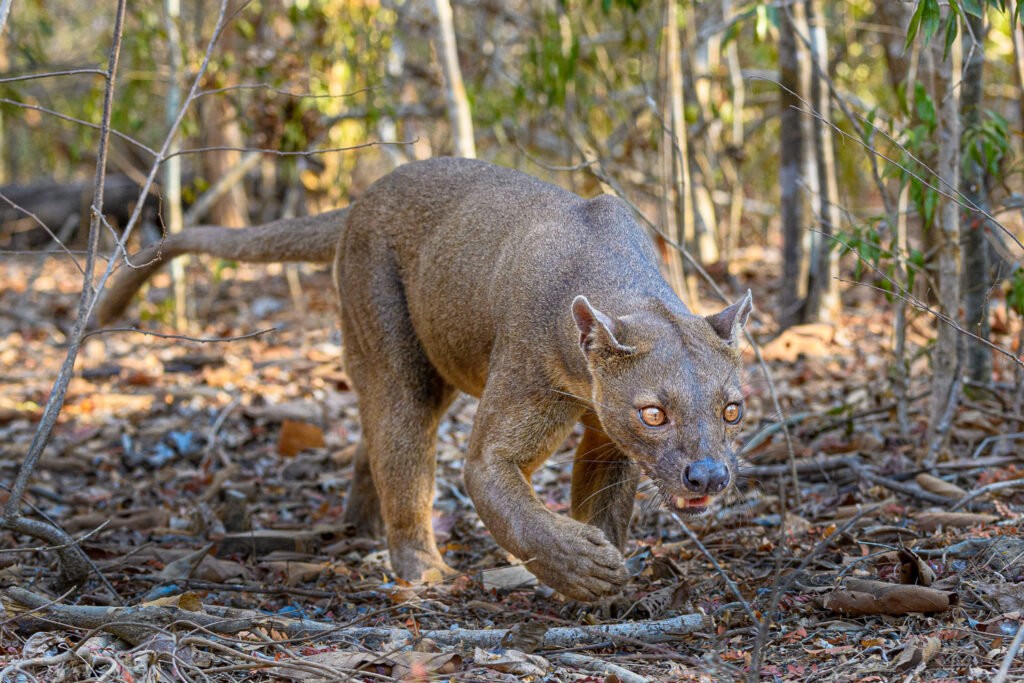
The fosa is Madagascar's largest carnivore © Nick Garbutt
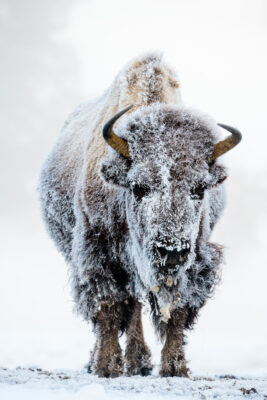
A frost covered bison stands in in temperatures around -25˚C near Midway Geyser Basin © Nick Garbutt
 Dates: 9th - 25th January 2025
Dates: 9th - 25th January 2025
Price: £15,795 (Twin-share: Flights inclusive)
Price: £15,095 (Twin-share: Land Only)
Single Supplement: Please enquire
Maximum Group 10
Current Availability: 3 places, please enquire
Click for further details
Read tour report 2016
Read tour report 2018
 Grading: Easy to Moderate
Grading: Easy to Moderate
Cold to very cold, expect temperatures between 0˚C and - 10˚C, and occasionally below - 20˚C. Primarily vehicle based, but all photography from outside vehicle. Some short walks. Underfoot snow and ice.
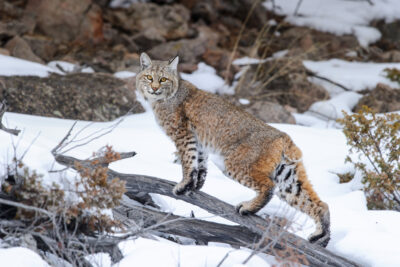
Sightings of bobcats happen from time to time, especially along the Madison River Valley © Nick Garbutt
Yellowstone was the world's first national park (established in 1872) and remains as breathtaking as ever. It is North America's playground, especially in the summer (around 1.5 million visitors per year). Its grandeur is unquestionable at any time, but in the depths of winter the landscape takes on an ethereal harsh beauty. And there are far fewer people - a tiny fraction of the great summer throng.
The juxtaposition of fairytale frosts, ice and snow with swirling mists and rising steam from countless hot springs and geysers (the park contains half of the world's geothermal features) creates a landscape laden with atmosphere, mystique and photographic inspiration and opportunity.
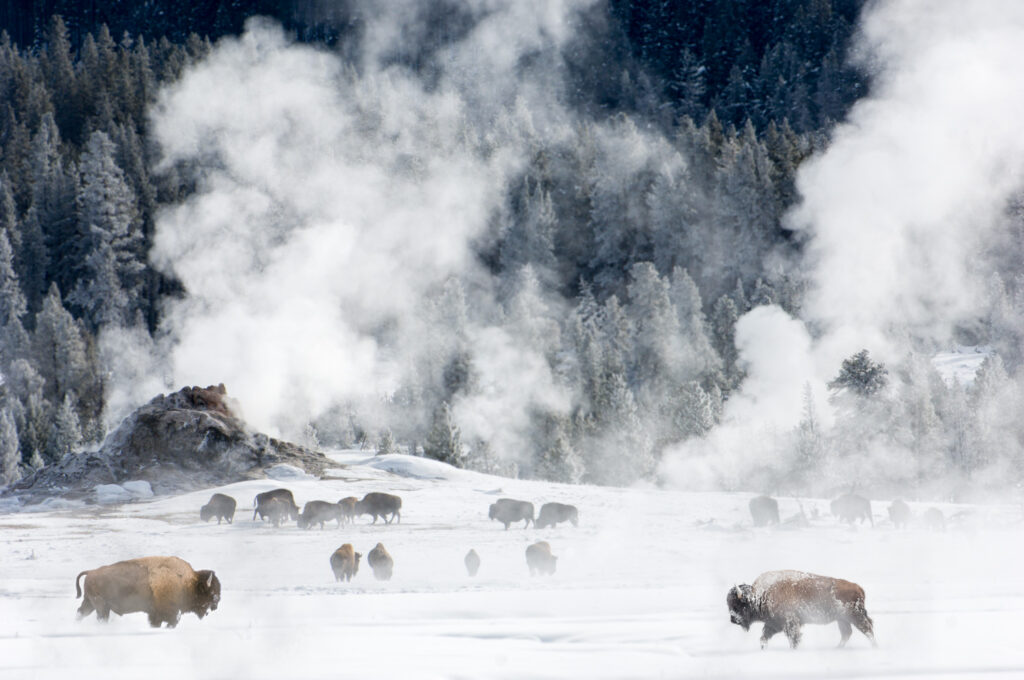
A herd of bison around geo-thermal features in the Firehole River Valley © Nick Garbutt
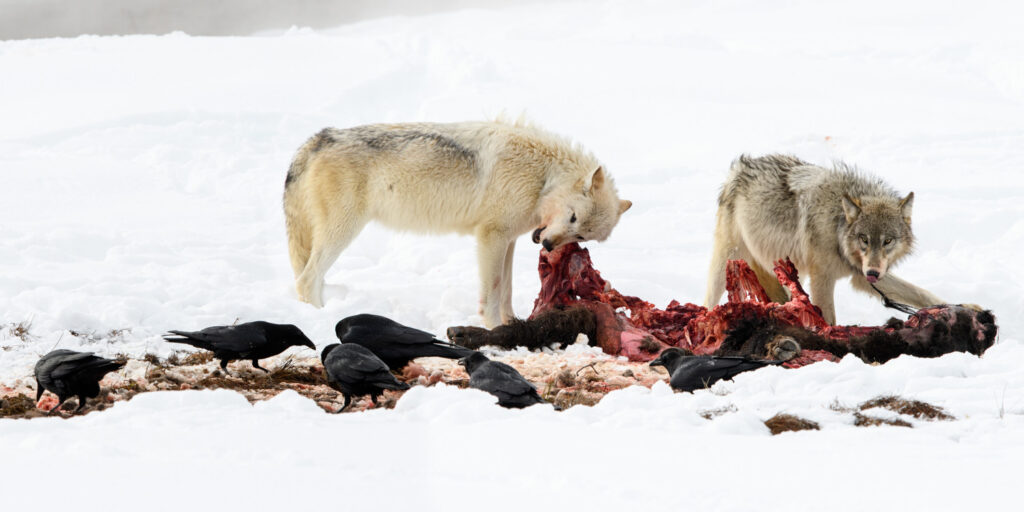
A pack of wolves feeding on a bison carcass: close sightings like this are rare and obviously thrilling © Nick Garbutt
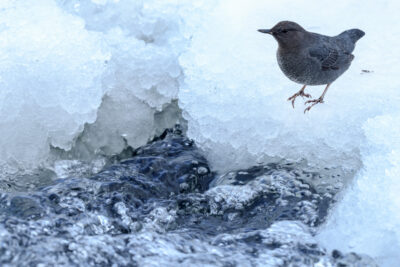
An American dipper on the edge of the frozen Upper Yellowstone River © Nick Garbutt
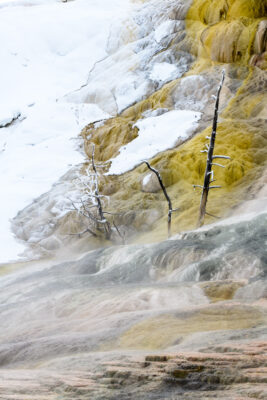
A group of petrified trees at Mammoth Hot Springs © Nick Garbutt
The Greater Yellowstone ecosystem is widely considered to be the finest wildlife area and habitat in the lower 48 States. In the grip of winter large numbers of bison can be seen grazing in open area, on the edge of woodlands and around hot springs and in the sheltered valleys it is possible to encounter coyotes, red fox, elk, and pronghorn antelope. In the more exposed areas bighorn sheep are often seen and way up high on precipitous cliffs, mountain goats might be seen.
This tour initially concentrates in the north western corner of Yellowstone, including Mammoth Hot Springs and the Lamar Valley, before moving to the spectacular Firehole River Valley, where there is the greatest concentration of geothermal features, and herds of frost-covered bison stand by steaming springs and numerous geysers, like 'Old Faithful', 'Castle Geyser' and 'Lone Star Geyser' erupt with predictable regularity. We explore these areas using over-snow vehicles and on foot> The photographic opportunities are almost endless.
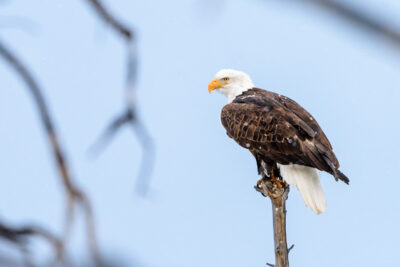
A bald eagle perched on the banks of the Upper Yellowstone River © Nick Garbutt
The Lamar Valley and adjacent areas, in the north east corner of the park, are amongst the best places to see wolves. A number of packs that frequent the vicinity, although their movements vary considerably from year to year with changes in pack dynamics. Research teams are out daily to track wolf whereabouts and if good sightings are possible they are always happy to help. Along the Madison River valley bison and bald eagles are regularly encountered and bobcats are sometimes seen hunting waterfowl along the river margins.
Arguably the tour highlight is the final four days where we stay in the center of the park near the Grand Canyon of the Yellowstone, based at a Yurt Camp. This is the only permanent winter accommodation within the vicinity and allows us unprecedented and sole access to some of the most scenically spectacular and wildlife-rich areas in the park. Using over-snow vehicles we will visit the most dramatic locations like the Canyon itself, the stunning beautiful Hayden Valley, and Yellowstone Lake.

A pair of North American river otters on the edge of the Upper Yellowstone River © Nick Garbutt
Along the Upper Yellowstone River, it is possible to see river otters, beavers and several species of waterfowl, while the Hayden Valley is especially rewarding for herds of bison, coyotes and red foxes hunting for rodents.
The cosy Yurt Camp provides a comfortable homely base and offers the opportunity to explore the areas close at hand, by snow-shoe and for those who wish on cross-country skis, including trails around the rim of the Grand Canyon of the Yellowstone.
 Photography Equipment
Photography Equipment
For wildlife, mainly telephoto: a lens of at least 400mm, ideally 500mm + is recommended. Short telephoto, eg. 70-200mm and wideangle lenses, e.g. 24-120mm for wildlife in habitat shots, geo-thermal features and landscapes.
Click: contact Wildlife Worldwide to book this tour
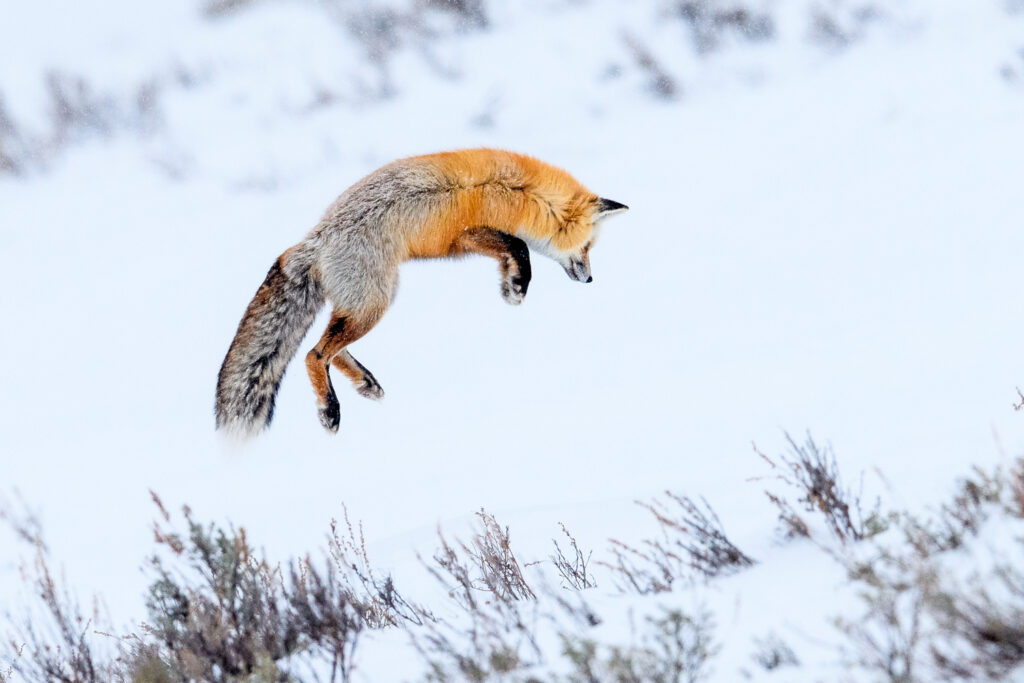
A red fox 'snow diving' for rodents in the Hayden Valley © Nick Garbutt
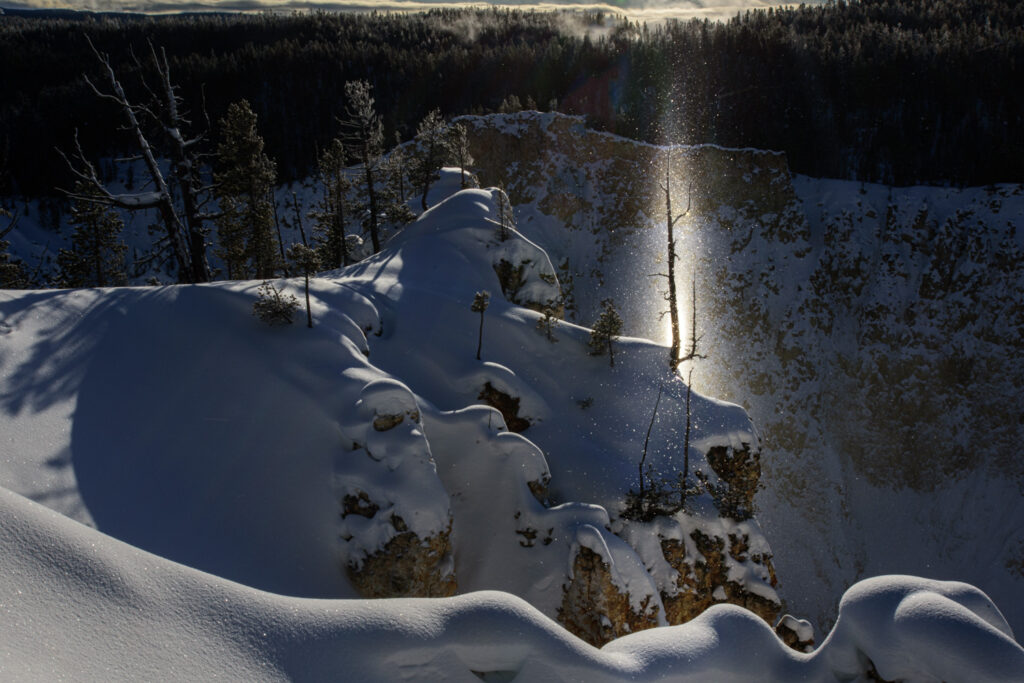
A rare sun pillar at dawn over the Grand Canyon of the Yellowstone © Nick Garbutt
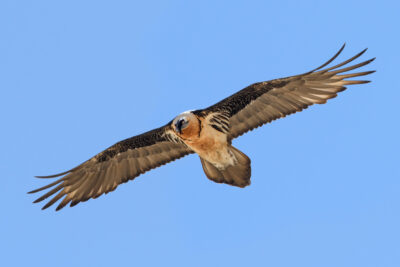
Adult lammergeier or bearded vulture soars on mountain thermals © Nick Garbutt
Dates: 20th February - 9th March 2025
Price: £9995 (Twin-share: Flights inclusive)
Single Supplement: Please enquire
Maximum Group 8
Current Availability: 2 places, please enquire
Click for further details
Read tour report 2017
Read tour report 2018
Read Panthera Blog 2019
 GRADING: Moderate to Challenging. Most cat sightings are from close to the road or near the lodge, long walks are unnecessary, but optional at times. High altitude and cold the main challenges. The lodge is at 3900m asl., and it is easy to become breathless. Daytime temperatures between 0˚C and - 5˚C, at night -10˚C to - 20˚C.
GRADING: Moderate to Challenging. Most cat sightings are from close to the road or near the lodge, long walks are unnecessary, but optional at times. High altitude and cold the main challenges. The lodge is at 3900m asl., and it is easy to become breathless. Daytime temperatures between 0˚C and - 5˚C, at night -10˚C to - 20˚C.
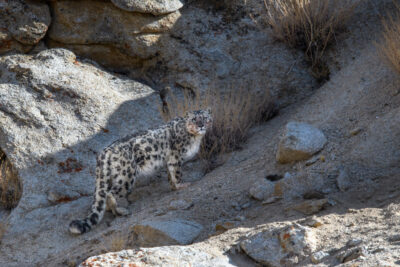
The prize: a wild snow leopard © Nick Garbutt
If ever an animal epitomised remote, rugged wilderness it is the snow leopard: for so long regarded as a mythical ghost of the mountains, a creature that lived unseen amongst the snow-capped peaks of the Himalayas and Central Asia.
Until now that is. Over the past decade significant conservation efforts have changed local attitudes and locations in the Himalayas have emerged that reveal regular and reliable sightings and offer the opportunity to see what must be one of the most mysterious and beautiful animals on earth.
Some of these locations, for example Rumbak Valley in Hemis National Park, can get very busy and offer only basic living conditions with rudimentary sanitation. Hence, the overall experience can be rather compromised which undermines the enjoyment and potential success of a trip.
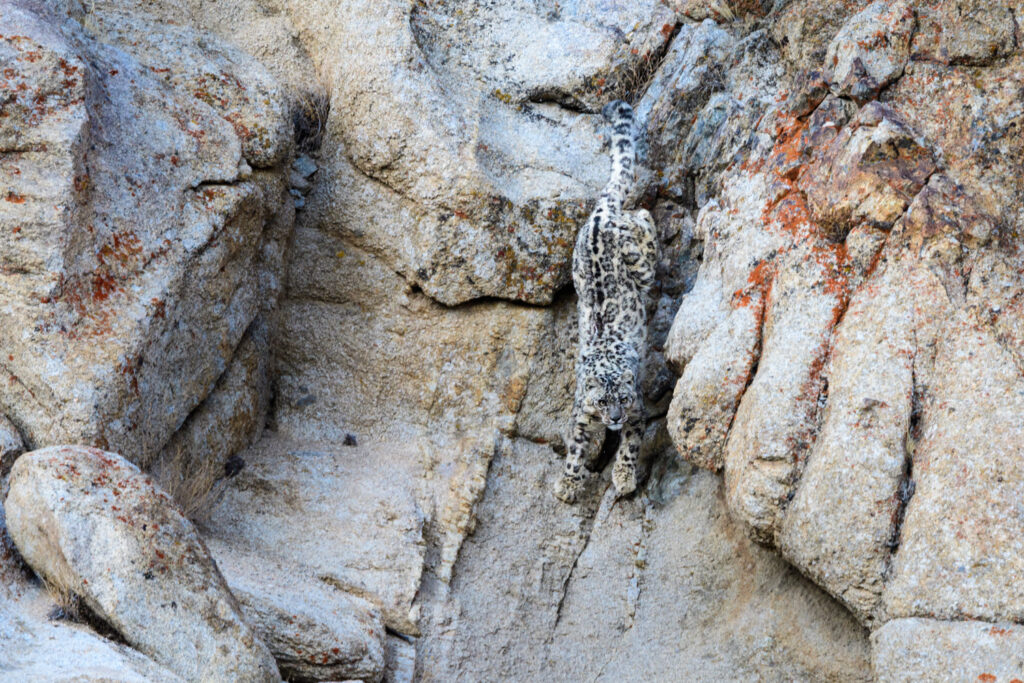
A female snow leopard bounds down steep rock face © Nick Garbutt

A female snow leopard moves along a high ridge © Nick Garbutt
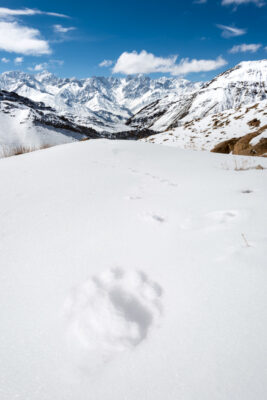
Fresh pug-marks of a snow leopard with the Zanskar ranges in the background © Nick Garbutt
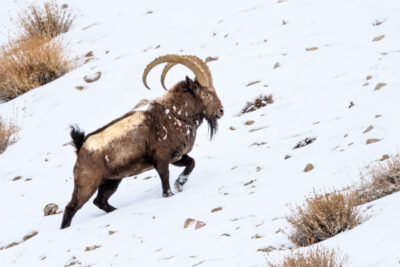
Siberian ibex are the main prey of snow leopards: this male has just escaped and attack , the scarring and wounds on flank are clearly visible © Nick Garbutt
Instead we have developed what we regard as a superior option with an expert local operator. This trip is based in the Zanskar / Himalayan ranges, some three hours from Leh, with the focus on three adjacent valleys that lie to the north of the River Indus and support a healthy population of snow leopards and other species.
While the expert local trackers search for the cats, we watch from accessible vantage points or follow in comfortable vehicles, which allows us to move easily between locations and also get as close a possible to potential sightings before setting out on foot, although sightings also happen from road side locations, and even occur reasonably often from viewing areas close to the lodge.

The snow covered Himalayan peaks provide a breathtaking backdrop. This is the view down the valley we stay in © Nick Garbutt
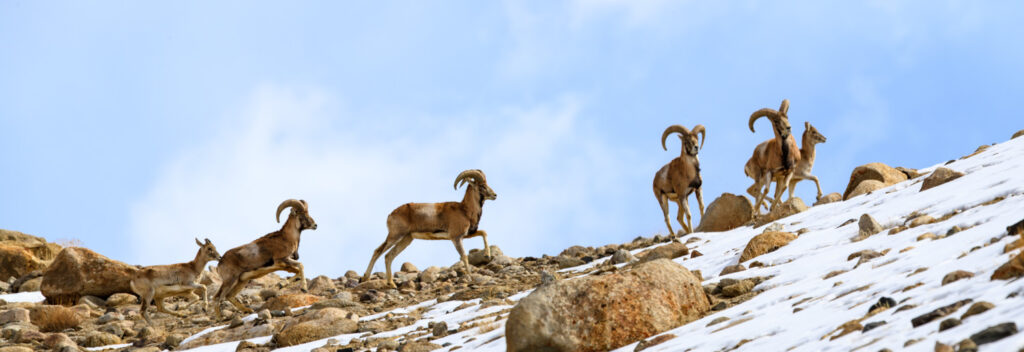
Urial are a wild sheep of the region and another prey species for snow leopards © Nick Garbutt
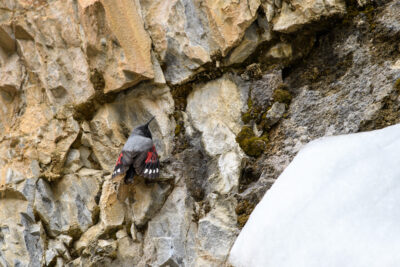
A male wallcreeper in breeding plummage © Nick Garbutt
Snow leopards are clearly the main focus and looking for them occupies the majority of our time, however, there is plenty of other Himalayan wildlife to see and enjoy in the area. The valleys in which we concentrate our efforts are also excellent for Siberian ibex, wolf, red fox and urial or shapo (wild sheep), as well as birds such as golden eagle, lammergeyer, red-billed chough, Alpine chough and wallcreeper.
Accommodation is a comfortable homestay with wood-stove heated bedrooms and shared bathroom facilities with hot water and western-style toilets. We will spend ten days in the snow leopard areas, with at least three days of acclimatisation to altitude in Leh beforehand (there are day excursions from Leh).
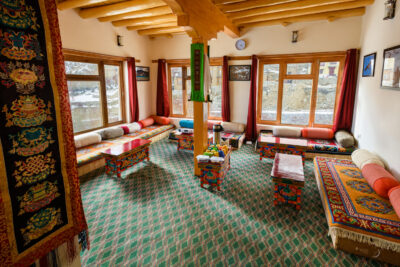
Our comfortable homestay lodge high in the mountains © Nick Garbutt
A Note on the Photography
The principle goal of this tour is to see snow leopards and the chance of success are very good indeed. However, it should be noted that getting meaningful images is more challenging. Most sightings of cats are at some distance (500m+), so photos tend to be of snow leopards very small in the frame: what you might term ‘record shots’. However, from time to time, much closer encounters do occur (100m-400m) and it is possible to get something more meaningful where the cat fills a significant area of the image. Obviously having a long telephoto lens is key.
 Photography Equipment
Photography Equipment
As an absolute minimum a lens of 500mm is required and ideally a lens of 600-800mm. A good alternative is to use a telescope and attach a camera or even mobile phone. For landscape and scenery shots, lenses like 70-200mm or 24-120mm. A tripod is advisable.
Click: contact Wildlife Worldwide to book this tour
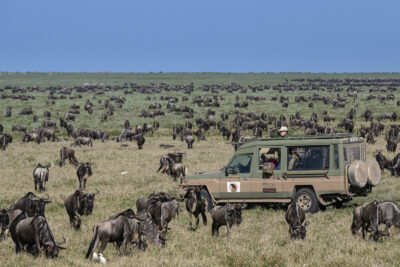
The short grass plains swarming with wildebeest © Nick Garbutt
Dates: 20th March - 4th April 2025
Price: £12,500 (Twin-share: Flights inclusive)
Price: £11,700 (Twin-share: Land Only)
Single Supplement: please enquire
Maximum Group 8
Current Availability: 1 place (single), please enquire
Click for further details
GRADING: Easy. Entirely vehicle-based. Only walking around lodges. Early mornings, approx. 5.30am starts and some long days, 10+ hours in the field.
The annual migration of wildebeest, zebra, gazelles and other ungulates around the Serengeti-Masai Mara ecosystem is one of the world's greatest wildlife wonders and one that provides endless excitement and photographic opportunities. Involving over 3 million animals, the spectacle is an ongoing event with the herds constantly on the move in search of the best pasture and grazing.
Herd movements are governed by the cycle of rains, which dictate that the animals follow a reasonably predictable annual circuit around the vast ecosystem. Between January and April the rains bring the herds, in their hundreds of thousands, to the fertile, calcium-rich short grass plains of the southern Serengeti. Here, around a million female wildebeest give birth to their calves, with around 90% being born in February.
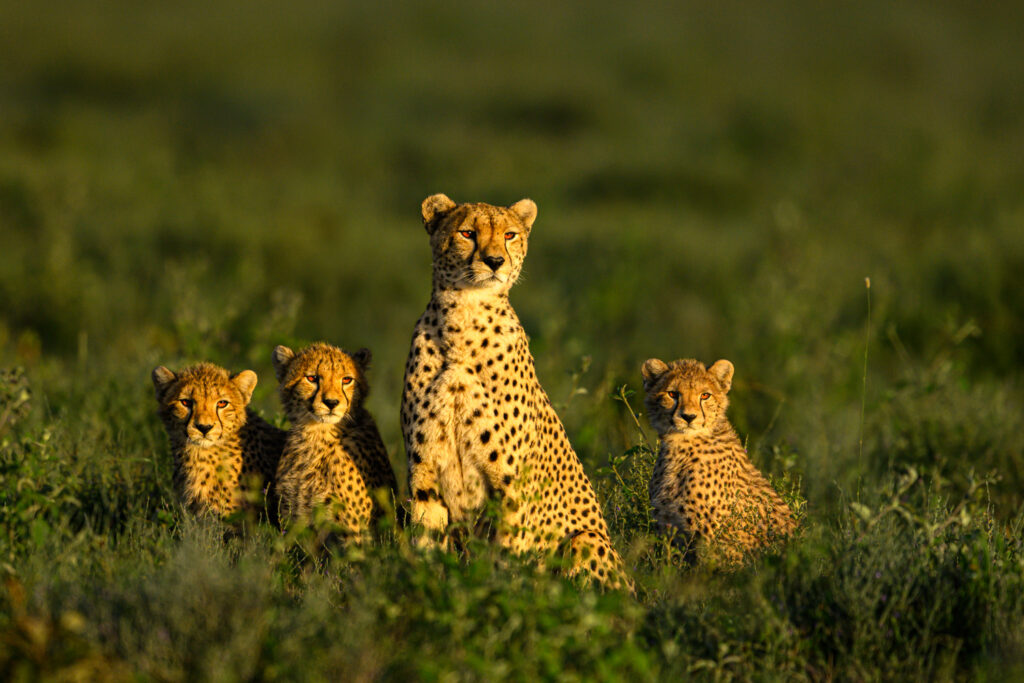
A female cheetah with three cubs around five months old. The Southern Serengeti region is one of the best places to see this elegant cat © Nick Garbutt
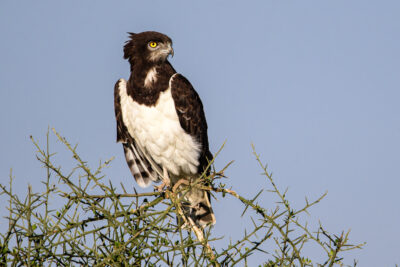
Adult black-chested snake eagle © Nick Garbutt
Witnessing this is one of the "must see" events of the natural world: it is a spectacle that never fails to captivate and set the pulse racing. Sightings and photographic opportunities on each trip are very different - with considerable year-by-year variation - but there are always many special encounters and sightings and the events witnessed that live long in the memory.
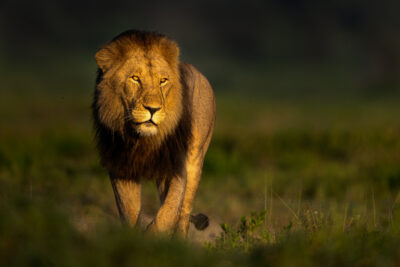
A magnificent male lion at first light, border of the NCA and southern Serengeti © Nick Garbutt
For photographers the Ndutu area near the boundary of the Serengeti National Park and Ngorongoro Conservation Area consistently provides a stream of unrivaled opportunities for creating memorable images. Here the open plains are broken by extensive areas of acacia woodland with lakes and marshes that form focal points for the gathering herds and attendant carnivores. This area is especially renowned for cats: it is arguably one of the very best places to see cheetahs hunting, there are several prides of lions resident in the area, and leopards are often seen too. The smaller cats - serval, caracal and African wild cat - are also encountered, and it is quite possible to see all six East African felines on a trip.
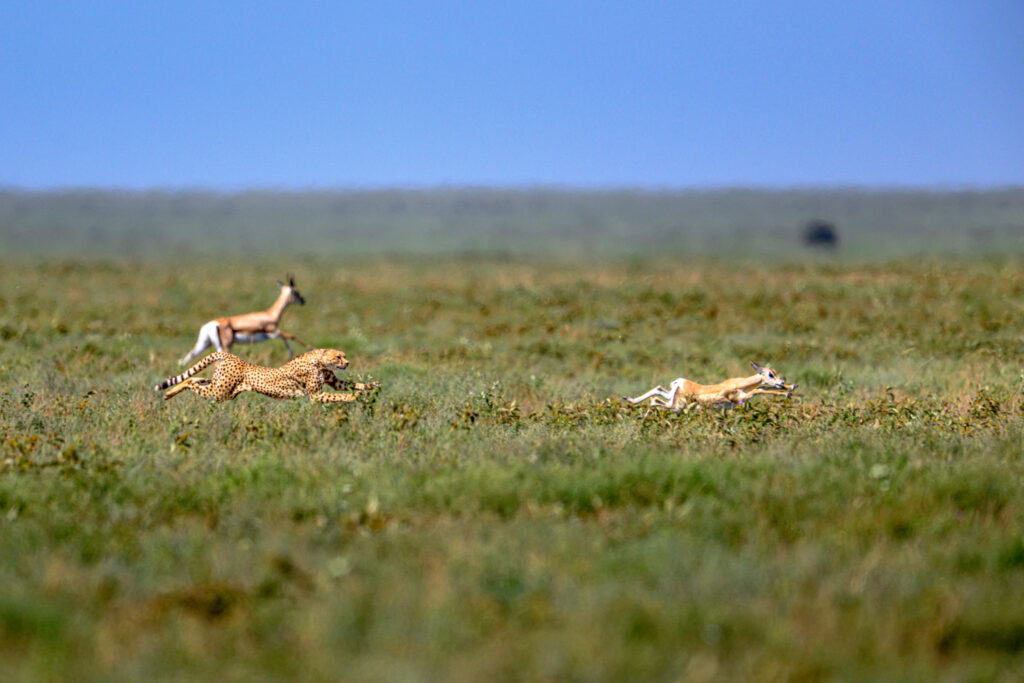
The thrill of a cheetah hunt: here a female chases down a young Grant's gazelle © Nick Garbutt
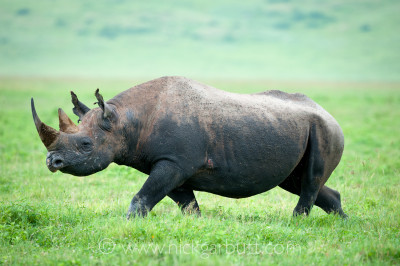
The Ngorongoro Crater is one of the best places to see black rhino © Nick Garbutt
This tour makes the most of this very special place with an extended stay and the capability to drive off-road in this area is a crucial factor in making it so productive for photography. Through a combination of morning, afternoon and sometimes full-day game drives, there will be ample time to explore the vicinity and go further a field to follow the shifting herds and look for the cats and other predators.
In addition, the tour begins by visiting the Ngorongoro Crater: no trip to northern Tanzania would be complete without visiting this natural wonder. It is East Africa in microcosm: an exceptional place where tolerant and varied wildlife can be viewed in close proximity.
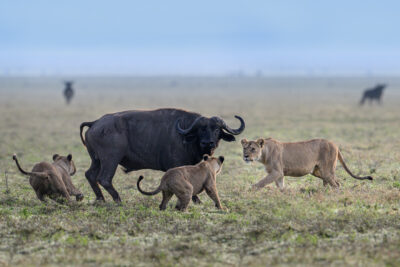
Lions take on an old male buffalo in the Ngorongoro Crater © Nick Garbutt
The Crater is one of the best location to see majestic bull elephants, many still sporting impressive large tusks. In addition it is home to over 30 black rhinos, and this time of year (the green season) is one of the best times to see them as they emerge from dense cover and can be seen more often browsing in open areas. There are also several prides of lions that provide a constantly changing dynamic with the chance of witnessing interesting behaviours and interactions.
As always our photographic efforts concentrate around the early morning and late afternoon when the light and cloudscapes surrounding the Crater are often dramatic, where subjects can be set in context against an awe-inspiring backdrop of the steep Crater walls creating scenes of compelling grandeur.
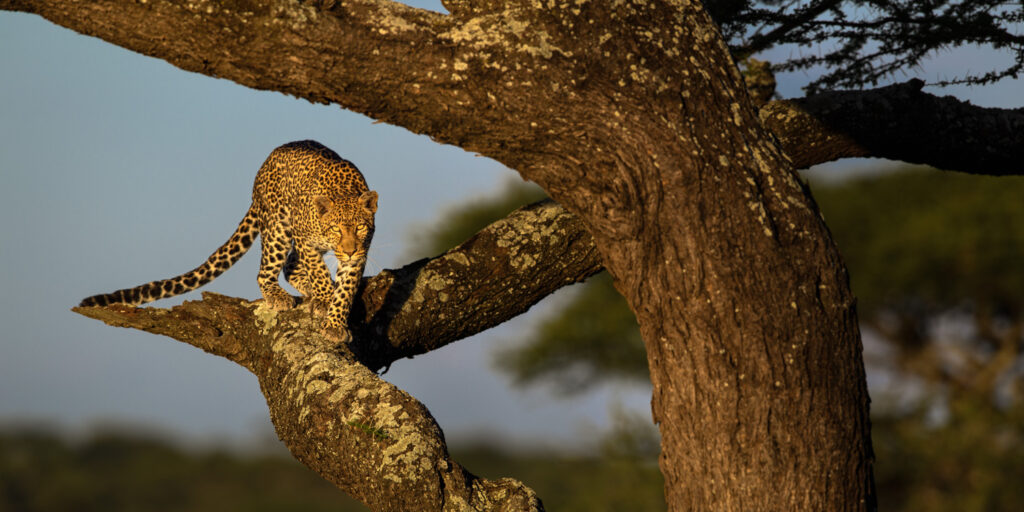
A leopard sighting like this is very special. This female is in woodland close to Lake Ndutu © Nick Garbutt
Photography on Tour
This itinerary involves a long stay at Ndutu, which those not familiar with the area may question: 'why do you spend so long in one place and not visit other areas,' is a question I am often asked. The answer is simple: Ndutu is by far the best location to to serve up repeated and diverse top quality photographic situations. Not only because the wildlife is so good, but also because you are able to drive freely off-road and explore the vast area and largely be alone.
With this in mind, I would suggest this tour is better suited to those who have already been to East Africa at least once previously, and who now want to concentrate on the quality of their photography, rather than quantity.
 Photography Equipment
Photography Equipment
Mainly telephoto: a telephoto zoom e.g. 100-400mm or 100-500mm will serve for many situations, but longer lenses 500-600mm can come into their own. A shorter telephoto / wideangle lenses e.g. 70-200mm and / or 24-120mm are good for animals in context and wider landscapes. Bean bags are useful.
Click: contact Wildlife Worldwide to book this tour
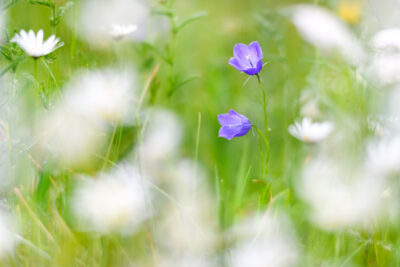
A bellflower (Campanula sp.) surrounded by out of focus ox-eye daisies © Nick Garbutt
Dates: 14th - 21st June 2025
Price: £2995 (Twin-share: Flight inclusive)
Price: £2795 (Twin-share: Land Only)
Maximum Group 12
Current Availability: places, please enquire
Dates: June 2026: TBC
Click for further details
LEADERS: Alex Hyde & Nick Garbutt
 GRADING: Easy to Moderate. Very early morning starts (5am) most days. Mostly short walks, but some longer walks 2-3km (including modest uphill) carrying your photography equipment.
GRADING: Easy to Moderate. Very early morning starts (5am) most days. Mostly short walks, but some longer walks 2-3km (including modest uphill) carrying your photography equipment.
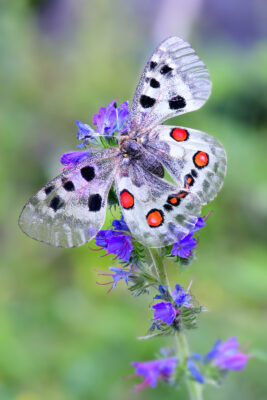
A roosting apollo butterfly: this is a focus stack © Nick Garbutt
June sees the alpine meadows of the Austrian Tyrol in their full glory. They are flushed with a spectacular show of wild flowers, and an equally stunning array of butterflies and other insects. This is the perfect time to visit for our macro photography tour.
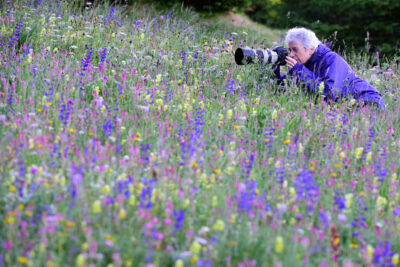
Captivated by the floral splendour of an Alpine meadow - -one of our clients enjoying her photography © Nick Garbutt
We will explore the many and varied meadows and discover a rich flora and along the way encounter many exciting and beautiful insects that flourish on these alpine slopes. In the locations we visit there is a good chance of finding the iconic apollo butterfly. Moving higher up the slopes, the colourful meadows give way to swathes of vibrant alpenrose and high alpine species such as dwarf snowbell and trumpet gentian.
The tour has been designed to maximise macro opportunities. Along with a renowned local guide, we will take you through all you need to know to photograph the region’s fascinating plants and wildlife. There will be an emphasis on macro techniques, as well as general and landscape elements. We will also photograph other attractions such as marmots, mountaintops at sunrise and dramatic glacial valleys. Whether a beginner or a seasoned photographer, you will benefit from the tutors’ guidance and experience. We will be looking at all aspects of macro photography from the basics through to advanced techniques like focus stacking.
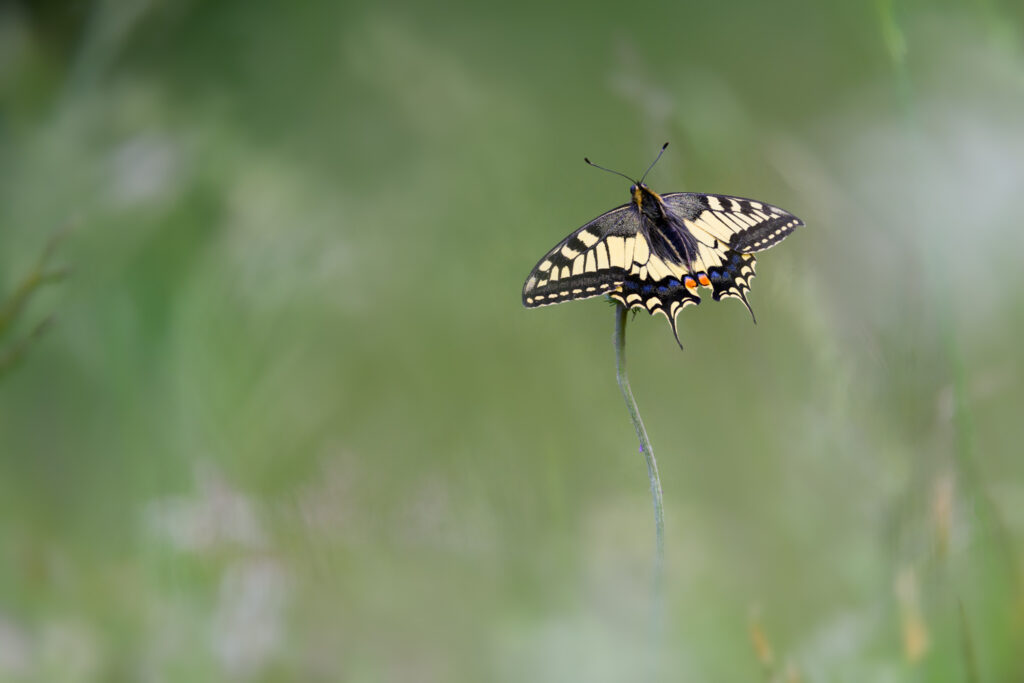
Common swallowtail butterfly: using a long telephoto lens and wide aperture helps create maximum blur to the background © Nick Garbutt
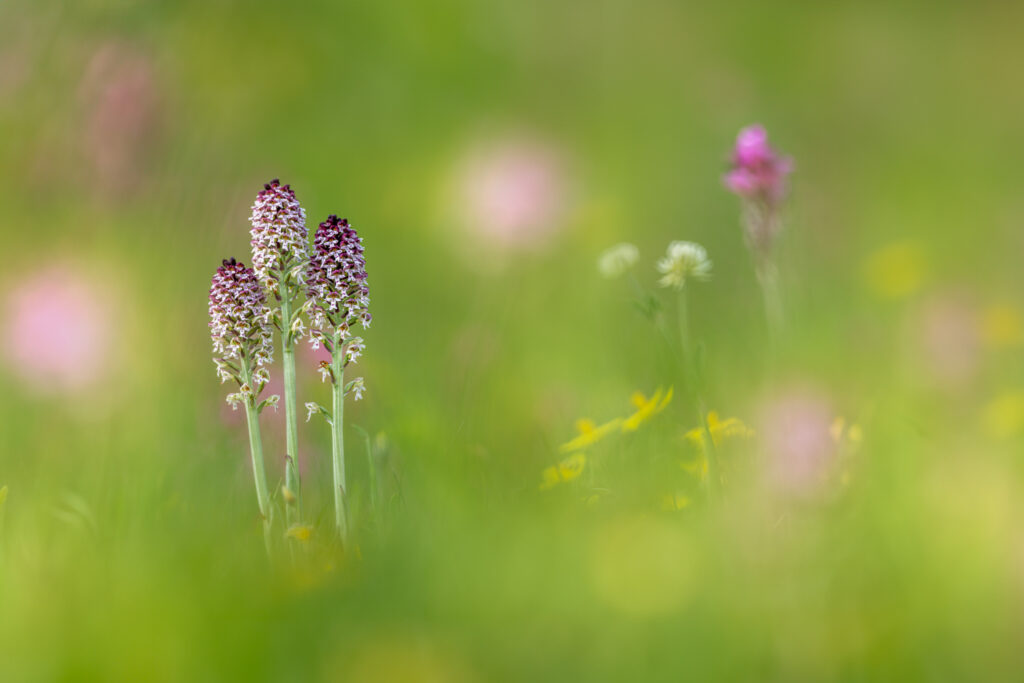
A group of burnt-tip orchids photographed with a telephoto lens through a veil of flowers and foliage © Nick Garbutt
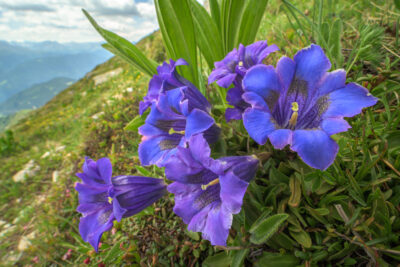
A cluster of trumpet gentians growing in the high Alpine zone © Nick Garbutt
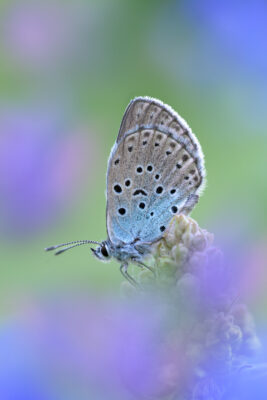
Early morning is the best time to find roosting butterflies in the meadows: a large blue amongst meadow clary and viper's bugloss © Nick Garbutt
In addition there will be indoor workshops on digital workflow. You will learn how Adobe Lightroom and Photoshop techniques can complement your field skills and let you get the most from your digital camera.
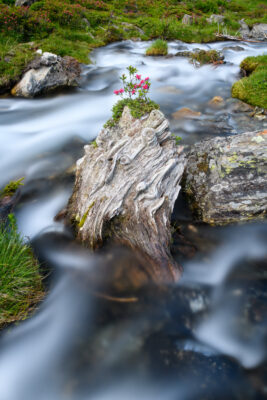
The Urgsee is a spectacular wild Alpine valley: here an alpenrose sapling is growing on ancient tree stump © Nick Garbutt
A friendly family-run hotel provides the perfect base for our week of photography and fresh mountain air. Flexible transport arrangements mean that we can make best use of the light. A short drive takes us to an extensive cable car network, making access to high mountain scenery and plants easy.
 Photography Equipment
Photography Equipment
Mainly macro and wideangle, with some telephoto. A standard macro lens e.g. 105mm and close-focus wideangle are key in flower meadows. Also a telephoto zoom e.g. 100-400mm for butterflies and some flowers. A tripod is essential.

Alex Hyde with an apollo butterfly © Nick Garbutt
Alex Hyde
I am delighted to be joined by good friend Alex Hyde on this trip. Alex is one of the UK's finest exponents of macro photography, combining the best of art and science into his exquisite images. He is a master of the technical aspects of digital photography and in the field or indoor workshop environment has the enviable skill of being able to convey challenging topics and ideas, concisely, simply and in a way that makes them understandable. To see more of Alex's stunning work click here
Click: contact Wildlife Worldwide to book this tour
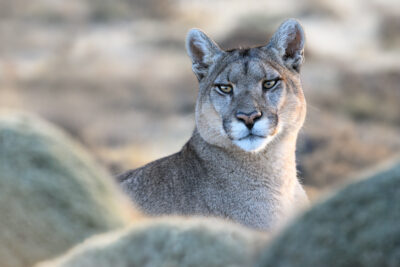
The elegant beauty of a female puma © Nick Garbutt
2nd - 16th July 2025
Price: £13,865 (Twin-share: Flights inclusive)
Price: £13,165 (Twin-share: Land Only)
Single Supplement: £795
Maximum Group 6
Current Availability: 1 place (single), please enquire
 Grading: Moderate to Challenging
Grading: Moderate to Challenging
A good level of fitness is required for this trip as there is the potential for some stiff walks. Some puma viewing is close to the roads or near the vehicles, however, there may be the necessity to walk 1-2km over uneven terrain with steep hills (carrying your camera gear). Days in the field are long, typically leaving the lodge around 8.00am and returning around 6.30pm.
Patagonia, at the southern tip of South America is imposing, windswept and beautiful. Here, the Andes juxtaposes with wide-open grasslands to epitomise the very notion of wilderness. Torres del Paine in southern Chile is a distinct rugged massif at the tip of the Andes and is often quoted as one of the most beautiful and majestic wild places on earth, especially in winter conditions, where breathtaking mountains meld with stark glaciers, blue melt-water lakes and free-flowing rivers.
This area is a refuge for a wealth of Andean wildlife and is a stronghold for the region's top predator, the puma. Torres del Paine is quite simply the best place in the world to see these magnificent cats.

A puma walks with her cubs through fresh snow © Nick Garbutt

Dramatic light with a rainbow at sunrise on the Towers and Central Massif of Torres del Paine © Nick Garbutt
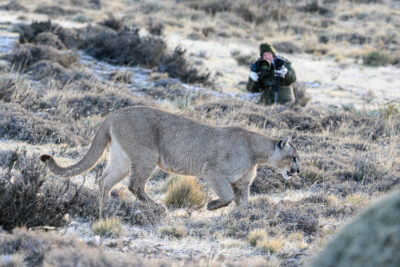
A client on a previous tour photographing a female puma © Nick Garbutt
This is a big cat experience like no other. Firstly, because you are on foot and track and follow the cats in their habitat and secondly, you may get relatively close - views from 30m or closer are not uncommon. The excitement and exhilaration of an eye-to-eye encounter, on the cat's terms is beyond words. And this of course yields potentially superb photographic opportunities.
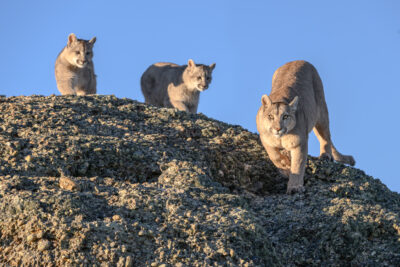
A female puma with her two cubs © Nick Garbutt
This tour concentrates for a prolonged period, on visiting the prime areas where seeing and photographing pumas is most likely. Certain parts of Torres del Paine, and adjacent private ranch land, are reminiscent of rolling moorlands and these areas support large populations of guanacos, the cats main prey. Pumas are often encountered hunting, especially around dawn and dusk, but can be seen at any time. The puma populations in these areas are considerable, and while some individuals are shy and skittish, many are tolerant and reasonably approachable. We engage specialist local guides and puma trackers to maximise our chances of finding and photographing these sublime felines.
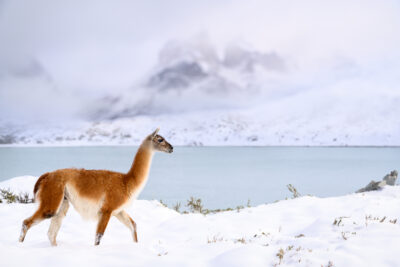
Guanacos are well adapted to cold winter conditions: here on the shores of Lago Pehoe © Nick Garbutt
Furthermore, the region also offers a chance of seeing and photographing other iconic species, like the Andean condor, together with other animals like inquisitive guanacos, Andean grey foxes and Patagonian hog-nosed skunk, that can be surprisingly relaxed and approachable.
The opportunities for stunning landscape photography also abound. The glowing light around dawn and dusk can be spectacular. This is also an area that is regularly very windy, which often results in the formation of numerous lenticular clouds that further augment these opportunities.
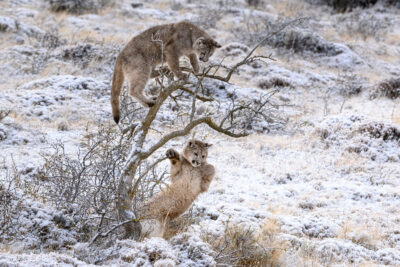
Puma cubs playing after fresh snow fall © Nick Garbutt
Lago (Lake) Grey is another highlight within the park, where icebergs lie stranded on the southern shore after a slow drift from the Grey Glacier front. Despite its rather austere name, the glacier is one of the most beautiful and colourful in Patagonia. The front is deeply crevassed and the solid glacial ice varies in colour from whitish to deep indigo. The glacier is flanked towards the east by impressive granite walls that are part of the Paine Massif, and towards the west by the eroded and low summits of the older Andes.
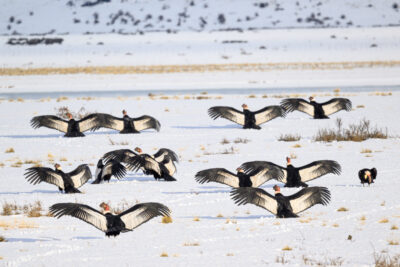
A group of Andean condors basking after feeding on a carcass © Nick Garbutt
Without question Torres del Paine is Patagonia's premier wildlife destinations and in combination with unsurpassable scenery and comfortable accommodation this makes for a perfect photography tour destination.
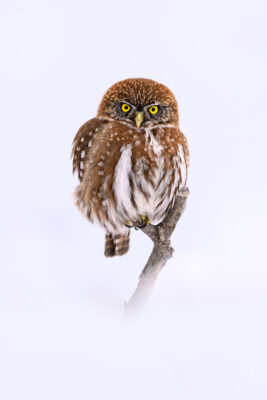
Austral pygmy owl © Nick Garbutt
Winter Conditions: It will likely be very cold with night time and early morning temperatures often falling below -10°C and sometimes even down to -20°C . Snowy conditions, however, are far from certain. When snow does fall, it often persists only for short periods, so getting the opportunity to photograph pumas and other wildlife in the snow requires good fortune.
 Photography Equipment
Photography Equipment
For pumas, mainly telephoto: a lens of at least 400mm e.g. 100-400mm is recommended, but longer lenses of 500mm or 600mm are useful, especially for birds. Some closer puma encounters are possible, where shorter lenses, e.g. 70-200mm are useful, especially to show subject in context. Short telephoto and wideangle lenses, e.g. 24-120mm for some landscapes and scenery.
Click: contact Wildlife Worldwide to book this tour
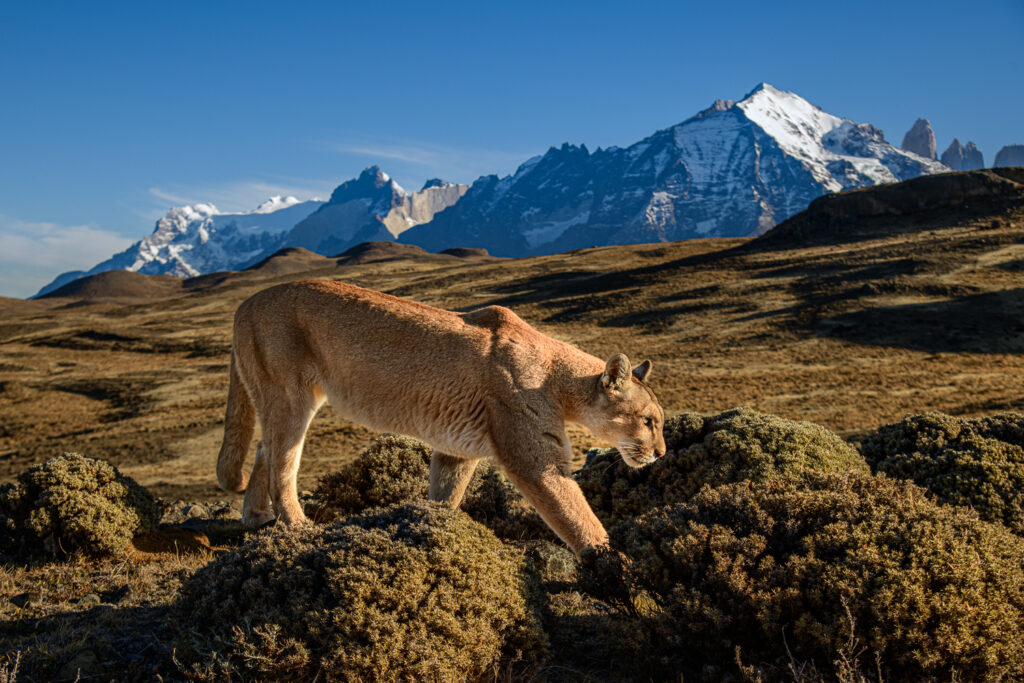
It is hard to overstate the dramatic beauty of the landscapes in Torres del Paine. However, even in the depths of winter, snowy conditions in the lowland areas, where the pumas live and hunt, are relatively infrequent. More often, the weather is clear, crisp and cold, with the sun low on the horizon and beautiful light persisting throughout much of the day © Nick Garbutt
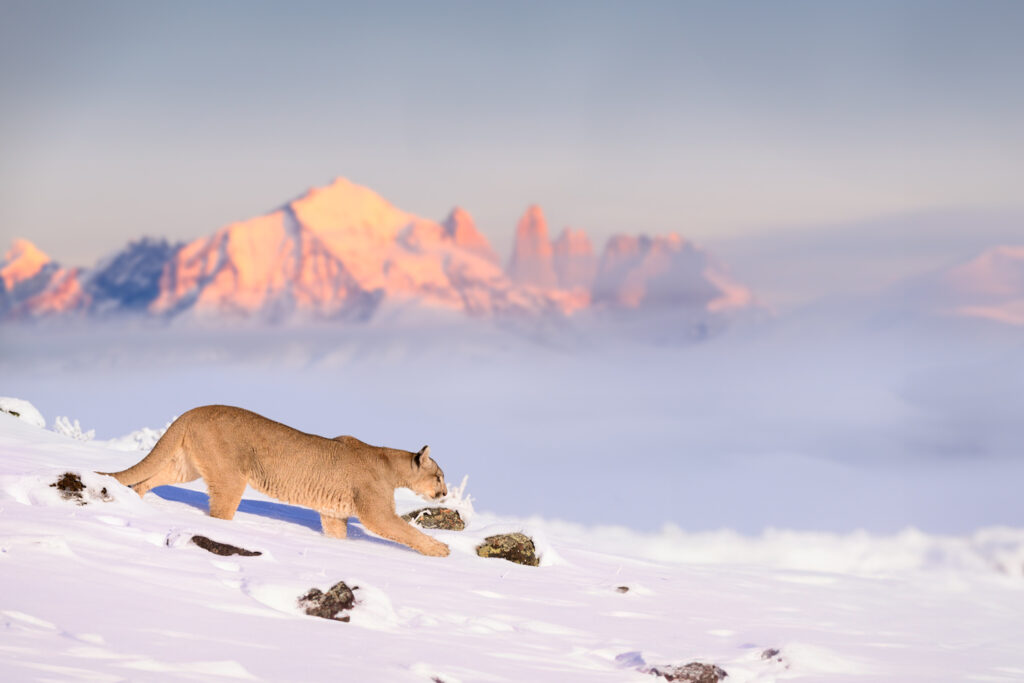
Early morning, a puma walks along snow covered ridge top near Torres del Paine National Park © Nick Garbutt
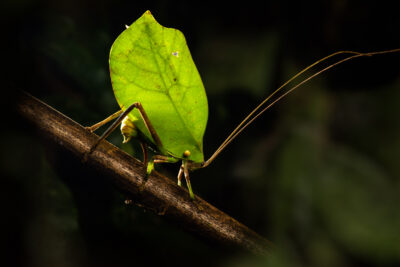
Female leaf-mimic bush cricket or katydid laying its eggs in a branch © Nick Garbutt
 Dates: 7th - 25th September 2025
Dates: 7th - 25th September 2025
Price: £12,995 (Twin-share: Flights inclusive)
Price: £11,995 (Twin-share: Land Only)
Single Supplement: £1495
Maximum Group 12
Current Availability: 6 places, please enquire
Extension Option: Tambopata Rainforest
Dates: 24th - 30th September
Price: £2095 (Twin share)
 GRADING: Moderate to Challenging. A variety of conditions from hot, humid lowland rainforest, to higher elevation cool montane cloud forests. Some remote locations are quite basic. Walks are generally short to medium length (1-2km), but inclines can be steep with uneven footing. Both early morning and late evenings as there are night walk options. Biting insects can be a nuisance. High altitude e.g. Cusco can cause head aches and breathlessness.
GRADING: Moderate to Challenging. A variety of conditions from hot, humid lowland rainforest, to higher elevation cool montane cloud forests. Some remote locations are quite basic. Walks are generally short to medium length (1-2km), but inclines can be steep with uneven footing. Both early morning and late evenings as there are night walk options. Biting insects can be a nuisance. High altitude e.g. Cusco can cause head aches and breathlessness.
Peru’s Manu Biosphere Reserve is one of the most biologically diverse places on earth. Tropical rainforests anywhere are extremely rich, but Manu is exceptional and has earned a reputation as the jewel of Amazon wildlife viewing experiences.
Consisting of several very different habitats and ecological and elevational zones, Manu is the perfect place for a multi-location rainforest photography tour, that visits the several principle areas of exceptional species richness. Our overland route takes us from highland Andean paramo, though high and mid-elevation cloud forest to various sites in lowland Amazonian rain forest.
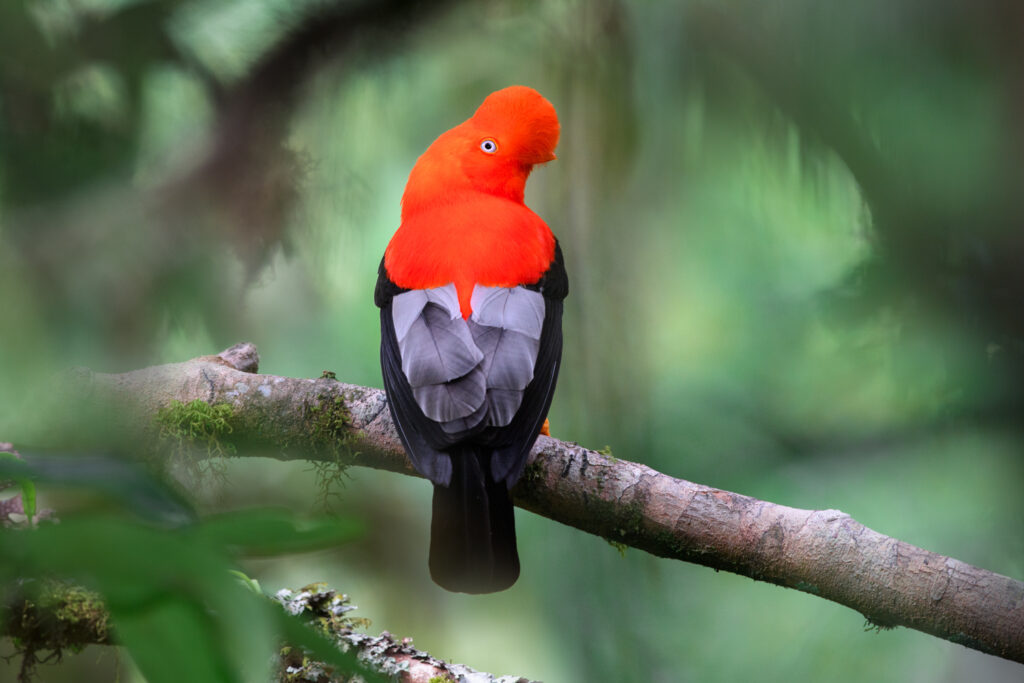
Male Andean cock-of-the-rock at a lek in mid-altitude montane rainforest. Manu Biosphere Reserve © Nick Garbutt
The cloud forests are rich in bird life including the iconic Andean cock-of-the-rock. We will make visits to a nearby well-known lek (a dancing ground where males display to females) that offers exceptional photography opportunities. Other area specialties include several species of hummingbirds, motmots, toucans and quetzals. There is a huge diversity of butterflies and moths and other invertebrates that provide endless photographic options as well as large numbers of frogs and reptiles that are sure to provide us with further inspiration.
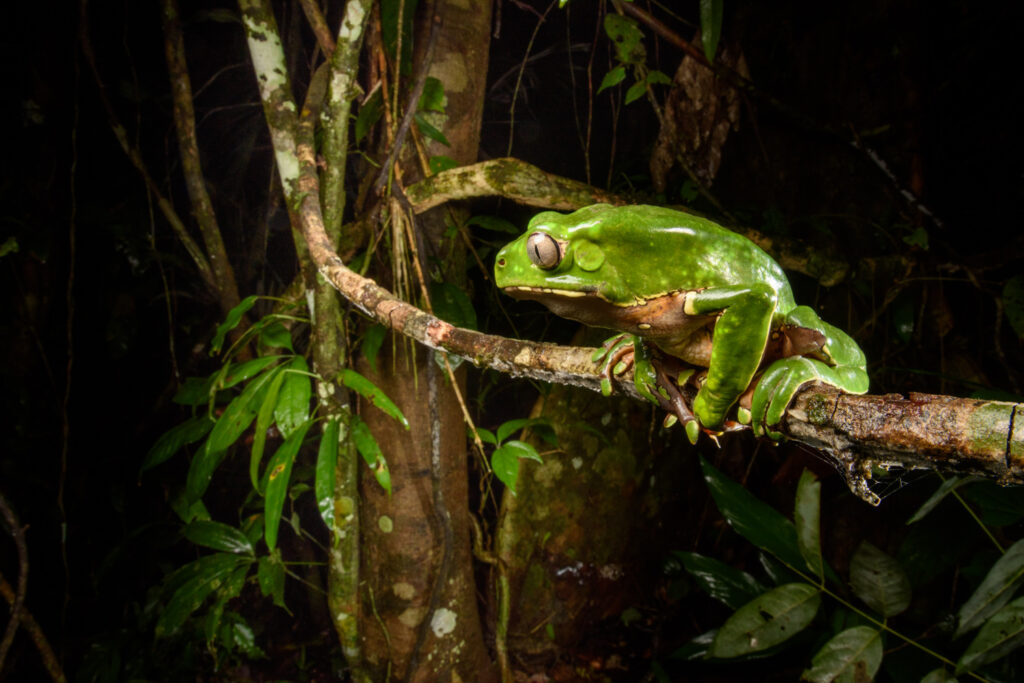
Giant waxy monkey frog or leaf frog climbing in rainforest understorey, Manu Biosphere Reserve © Nick Garbutt
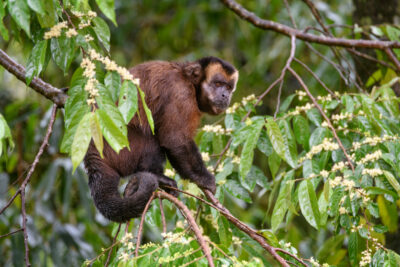
A male tufted or brown capuchin in mid-altitude montane forest, Manu Biosphere Reserve © Nick Garbutt
Once in the lowlands we venture deep into the Peruvian Amazon and stay at three different locations. The first allows us to work closely with scientists involved in active research that gives us unprecedented access to rare and difficult to photograph species.
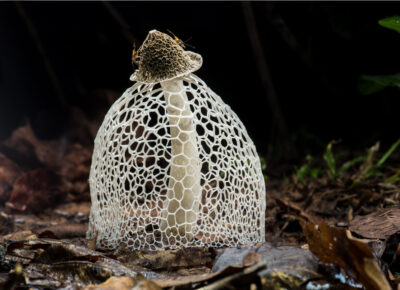
Fully formed maiden's veil or bridal veil fungus, Manu Biosphere Reserve © Nick Garbutt
The second location has two oxbow lakes close by, which are home to giant otters, while the surrounding forests support 13 species of monkeys and an abundance of bird life. Viewing from mobile lake platforms and canopy towers offers excellent photographic opportunities.
The final location off the main Manu River channel, is potentially the highlight of the tour. Here two separate clay licks offer excellent chances of photographing flocks of noisy red-and-green macaws and other parrot species (by day) and the South American tapir (at night). There is an extensive network of trails from the lodge giving us freedom of access into the forest, day or night. There is also a canopy tower for viewing many species that are inaccessible from ground level, especially birds.
Throughout the trip we will also explore areas after dark. Night walks are an idea way to look for frogs and some of the extraordinary invertebrate diversity for which Amazon rain forests are renowned and these will provide a wealth of photographic subjects.
 Photography Equipment
Photography Equipment
A wide variety of equipment is useful, from close focus wideangle e.g. 16-35mm, to macro e.g. 105mm, to telephoto, e.g. 100-400mm will cover most situations. Flash equipment very useful. A longer telephoto e.g. 500mm or 600mm is good for birds and primates. Waterproof protection for camera gear is recommended. A tripod is advisable.
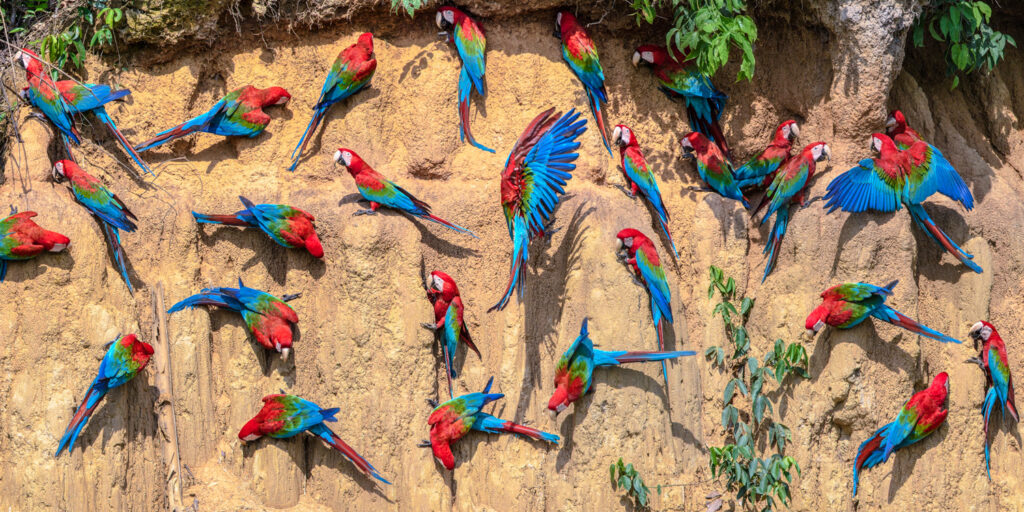
Red-and-Green Macaws feeding at Blanquillo clay lick, Manu Biosphere Reserve © Nick Garbutt
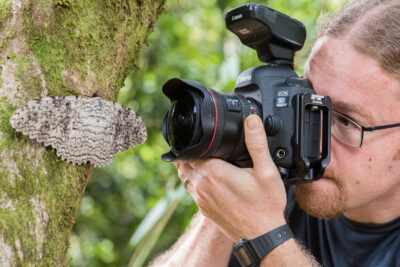
Alex Hyde photographing a White Witch moth, Manu Biosphere Reserve © Nick Garbutt
Alex Hyde
I am delighted to be joined by good friend Alex Hyde on this trip. Alex is one of the UK's finest exponents of macro photography, combining the best of art and science into his exquisite images. He is a master of the technical aspects of digital photography and in the field or indoor workshop environment has the enviable skill of being able to convey challenging topics and ideas, concisely, simply and in a way that makes them understandable. To see more of Alex's stunning work click here
Click: contact Wildlife Worldwide to book this tour
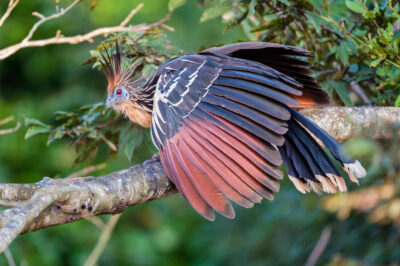
A hoatzin clambers in low vegetation around an ox-bow lake nar Heath River Lodge © Nick Garbutt
TAMBOPATA RAINFOREST EXTENSION
With Nick Garbutt
Dates: 24th - 30th September 2025
Price: £2095 (Twin-share)
Maximum Group 8
Current Availability: Please Enquire
Tambopata Reserve, is widely regarded as one of the top wildlife locations in South America. It harbours some of the wildest, least human-impacted habitats that remain anywhere in the world. Here pristine rain forests dominate in a land where rivers are the only means of accessing the remote areas.
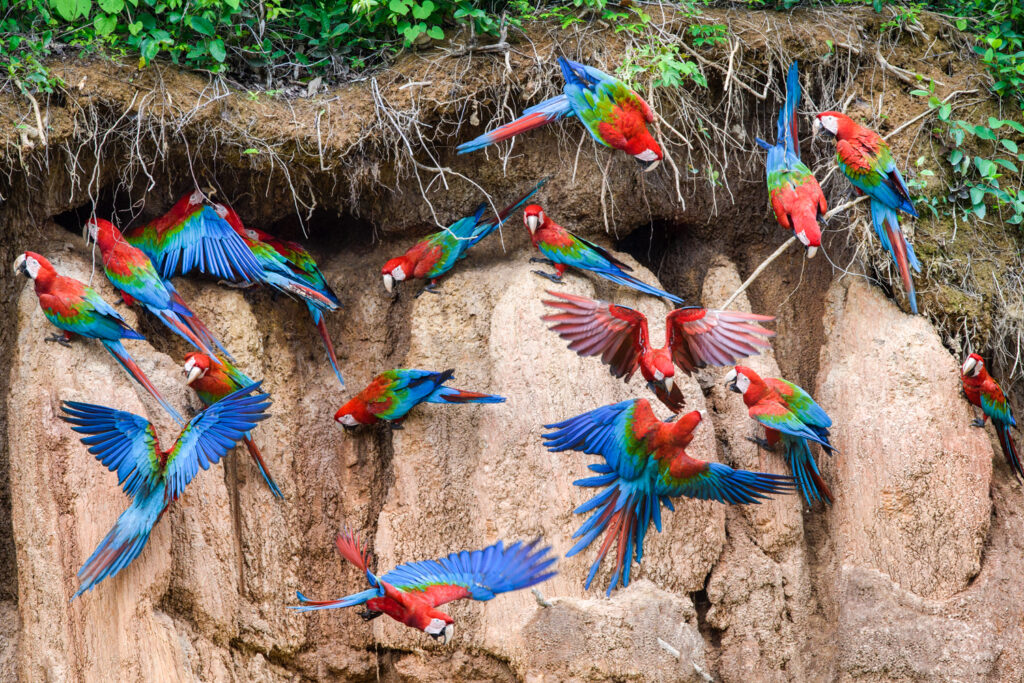
Red-and-Green Macaws at a clay lick, Heath River, Tambopata / Bahuaja-Sonene Reserves © Nick Garbutt
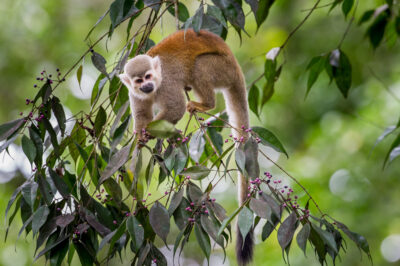
A squirrel monkey in the forests adjacent to Heath River Wildlife Centre © Nick Garbutt
The Heath River on the Peru-Bolivia border is one of the many rivers that drains the region and it passes through some of the largest tracts of undisturbed Upper Amazonian forests that is home to jaguars, giant otter, South American tapirs, several species of monkey, numerous species of macaws and other parrots, over 400 other bird species and a myriad of amphibians, reptiles and invertebrates.
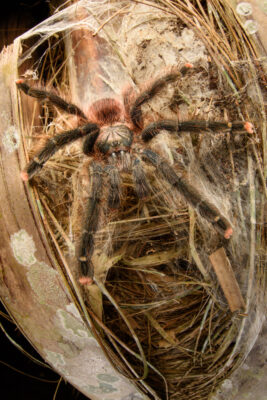
Female pink-toed tarantula waiting in ambush, Heath River, Tambopata / Bahuaja-Sonene Reserves © Nick Garbutt
The Heath River Wildlife Centre is the only lodge in the entire region, so offers exclusive access to the rain forests and some adjacent very unusual savannah areas. The lodge’s unquestionable highlight is one of the very best known macaw and parrot clay licks. On most days upwards of 100 spectacular red-and-green macaws gather, along with smaller numbers of chestnut-fronted macaws and mealy parrots and blue-headed parrots, just 40m in front of the hide. The photography opportunities are very special.
During quiet boat rides on a nearby ox-bow lake it is sometimes possible to see giant otters and hoatzins, while there are red howler, squirrel and titi monkeys in the surrounding forests. A variety of trails near the lodge offer convenient wildlife viewing and photography opportunities, with primates often seen and a wealth of bird life, insects and other invertebrates.
A longer trail through forest abruptly gives way to open rather incongruous grasslands, where blue-and-yellow macaws can be seen. There is also a watchtower to enjoy an elevated view of this area.
Click: contact Wildlife Worldwide to book this tour
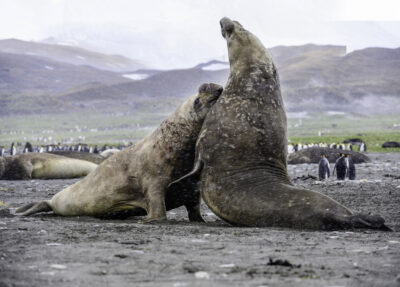
In October, many of the beaches are host to battling southern elephant seals.
 Dates: 13th - 31st October 2025
Dates: 13th - 31st October 2025
Prices from: £11,250
Maximum Group Size: 88 ship charter
Current Availability: places, please enquire
In this day and age, superlatives tend to be rather overused. Where South Georgia is concerned, however, no amount of superlatives can do it justice. It has rightly been referred to a, ‘the most staggering wildlife show on earth’.
South Georgia may be only 170km long, have no trees and be half covered in permanent snow and ice but this rugged, austere wintery landscape contrasts markedly with the immense profusion of life that gathers around the coastal areas. The shores are smothered with hundreds of thousands of king penguins, cliff tops are encrusted with breeding albatross, petrels and other sea birds and the beaches are peppered with elephant seals. This is without question one of the wildlife wonders of the world and provides unprecedented photographic opportunities.

Wandering albatross in flight over Prion Island in the Bay of Isles.
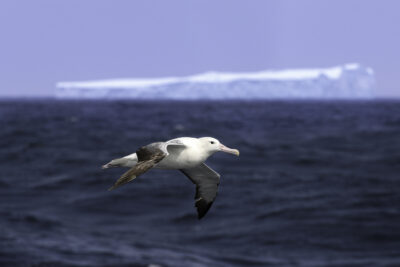
Wandering albatross flying close to a huge iceberg in the South Atlantic Ocean near South Georgia.
Timed to coincide with the start of spring on South Georgia, this charter voyage promises to be perhaps the most memorable incarnation of the Festival of Wildlife. Our route around South Georgia incorporates most of the major wildlife sites on the island where vast colonies of penguin and seals fill the beaches on this spectacular archipelago.
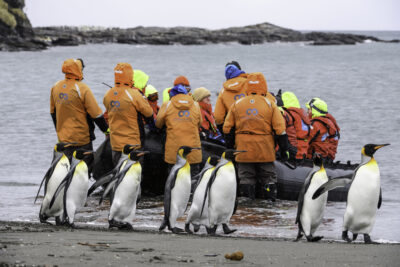
A group of king penguins walking along the beach in front of tourists landing at St Andrews Bay.
Our journey begins in Punta Arenas, where we board the Magellan Explorer and set sail to the Falkland Island. The Falklands are home to several species that are unlikely to be encountered elsewhere on the trip, so we spend our first couple of days on land exploring the archipelago, observing bustling colonies of rockhopper and gentoo penguins, and scanning the waters for Peale's and Commerson's dolphins.
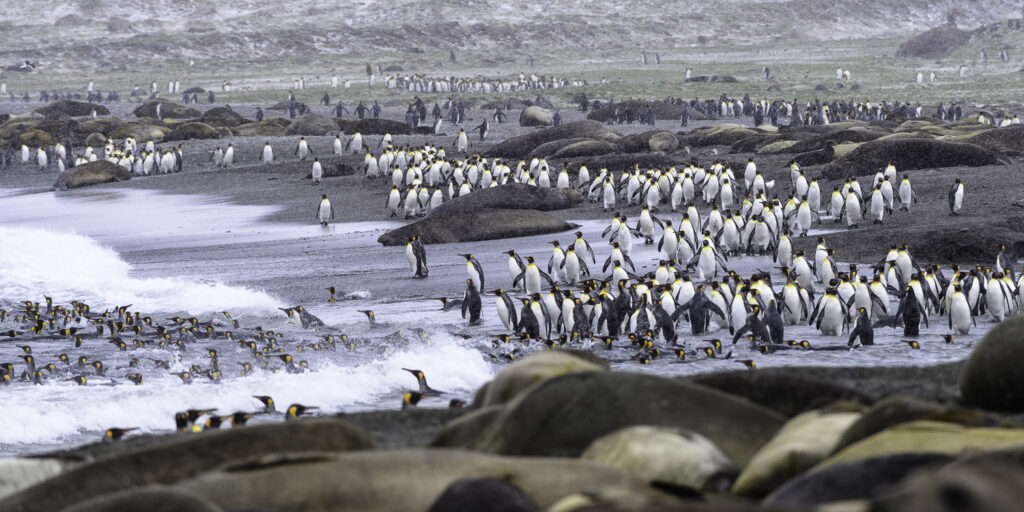
The awe-inspiring spectacle of St Andrews Bay - king penguins and southern elephant seals.
From the Falklands we voyage across the open ocean with black-browed albatross and a variety of petrels for company, scanning for icebergs that drift north from Antarctica. South Georgia is an untamed wilderness teeming with wildlife and as we navigate the archipelago we explore the numerous bays and fjords which characterise the islands.
Our itinerary incorporates the major wildlife sites and is timed to coincide with the beginning of the breeding season for many species. Both king penguin and black-browed albatross alike engage in intimate and beautiful courtship rituals, contrasting starkly with the raw brutality of battling bull elephant seals. Experiencing these behaviours makes for fascinating viewing but it is the sheer number of animals present that gives South Georgia its ‘wildlife spectacle' status.
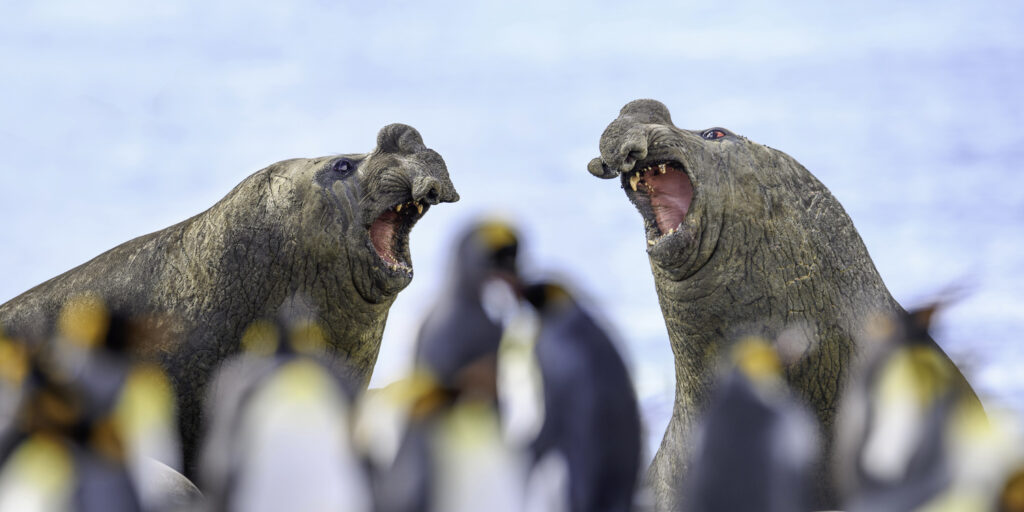
Male southern elephant seals at Gold Harbour.
In the company of expert guides - Chris Breen, Nick Garbutt, Mark Carwardine, Jonathan Truss, Nick Mackman, Sean Weekly & Dan Free, we witness a remarkable profusion of animals and learn about their behaviour, life cycles and the importance of this remarkable island. Two weeks aboard the Magellan Explorer enables us to enjoy these sub-Antarctic islands and their wildlife tenants in depth. Do join us on this fantastic celebration of Antarctic wildlife!
Click: contact Wildlife Worldwide to book this tour
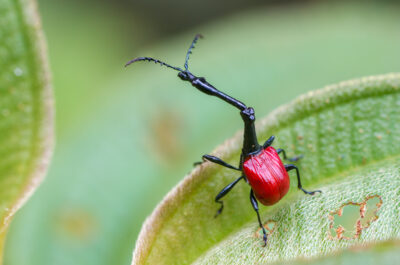
Male giraffe-necked weevel on leaves of favourite food plant © Nick Garbutt
 Dates: 5th - 25th November 2025
Dates: 5th - 25th November 2025
Price: £11,450 (Twin-share: Flights inclusive)
Price: £10,750 (Twin-share: Land Only)
Single Supplement: £1,070
Maximum Group 8
Current Availability: FULL
Click for further details
Read an account of the 2014 trip
 GRADING: Moderate, sometimes more Challenging. A variety of conditions from hot (over 35˚C), dry forest (north and west), to cooler mid-elevation rainforests (east). More remote locations are basic. All wildlife watching on foot. Walks are generally short to medium length (1-3km), but occasionally longer and inclines can be steep with uneven footing, especially in rainforest regions. Both early morning and late evenings as there are night walk options. Lots of internal travel by road and air. Roads often very poor.
GRADING: Moderate, sometimes more Challenging. A variety of conditions from hot (over 35˚C), dry forest (north and west), to cooler mid-elevation rainforests (east). More remote locations are basic. All wildlife watching on foot. Walks are generally short to medium length (1-3km), but occasionally longer and inclines can be steep with uneven footing, especially in rainforest regions. Both early morning and late evenings as there are night walk options. Lots of internal travel by road and air. Roads often very poor.
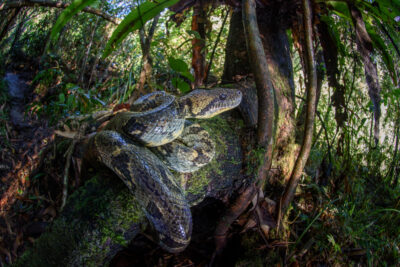
A Madagascar tree boa lies in ambush © Nick Garbutt
Madagascar is a island country like no other. Millions of years of isolation have led to the evolution of an array species found nowhere else on earth (some are so bizarre as to appear almost 'extraterrestrial'). Add to this an extraordinary range of habitats and the result is a destination brimming with, allure, intrigue and excitement.
The island's most famous inhabitants are its lemurs - charming and highly varied off-shoots of the primate family tree, whose ancestors probably arrived on the island over 50 million years ago, and have subsequently diversified spectacularly - today over 100 lemur species are known. Amongst the most endearing are the cuddly teddy-bear like indri and gorgeous diademed sifaka live in the lush eastern rain forests, while white Verreaux's sifakas bound through the dry forests of the west and south. Then after dark the island's 'Spirits of the Night' become active: miniscule mouse and dwarf lemurs scurry along branches, while hedgehog-like tenrecs bumble in the undergrowth. Strangest of all is the aye-aye, a primate that looks like a cartoon 'witches cat', with bat-like ears and buck teeth and is certainly one of the world's most peculiar mammals.
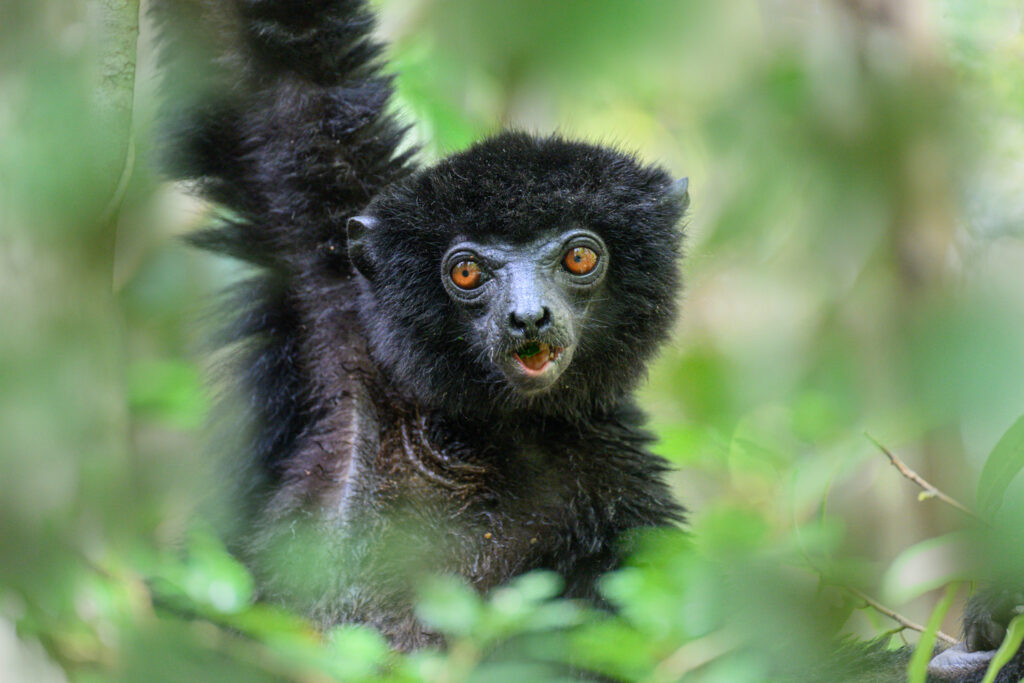
Perrier's black sifaka is one of the world's rarest primates and is restricted to a tiny enclave of humid dry forest in the far north © Nick Garbutt
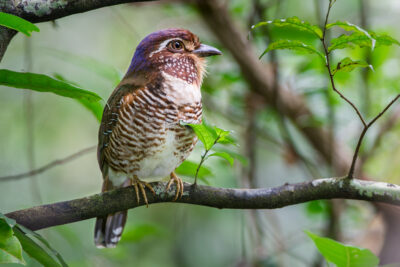
The endemic short-legged ground roller is one of numerous species keenly sought after by keen birdwatchers © Nick Garbutt
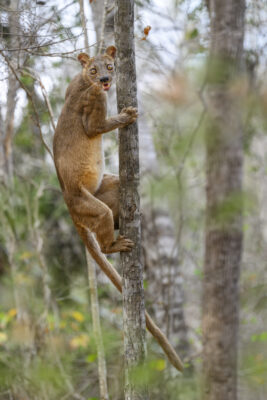
The fosa, is a skilled and agile climber, as this female in western dry forest clearly illustrates © Nick Garbutt
There are numerous birds unique to the island (over 65% are endemic), varied vangas with many beak shaped, noisy couas and colourful, skulking ground rollers. Reptiles too abound - over 60% of the world's chameleons live nowhere else, including the world's largest and smallest species, and amazing leaf-tailed geckos have near-perfect camouflage. Add to this a myriad of colourful and very vocal tree frogs and multitude of peculiar insects like the amazing giraffe-necked weevil and there is always something to grab your attention.
This trip will visit some of the island's prime sites like the rainforests of Andasibe-Mantadia, home of the indri and diademed sifaka, and the western deciduous forests of Kirindy, where the fosa, Madagascar's largest carnivore might be seen, as well as Verreaux's sifaka and at night Madame Berthe's mouse lemur, the world's smallest primate.
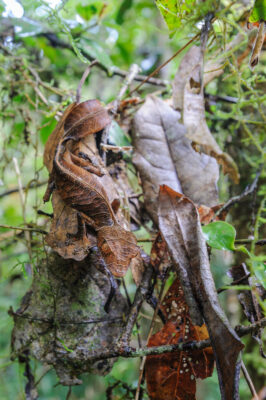
The remarkably camouflaged satanic leaf-tailed gecko © Nick Garbutt
We combine these sites with less well-known and far less frequently visited locations like Analamerana and Daraina, which are equally spectacular and offer the chance to see some unusual species and regularly conjure up surprises.
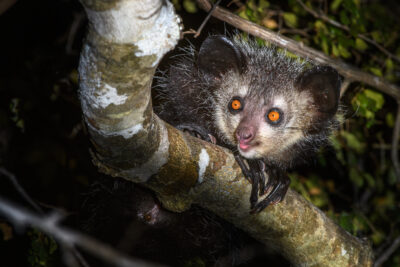
The aye-aye is perhaps the world's most peculiar primate and can sometimes be seen in Daraina © Nick Garbutt
At Daraina in the far north, fragments of remaining humid forest support the beautiful golden-crowned sifaka, while after dark there is a realistic chance of seeing an aye-aye.
Further north still, lies Analamerana, which offers the chance to explore another isolated patch of forest, where the incredibly rare Perrier's black sifaka can be seen, along with crowned lemurs and a diversity of birds and reptiles.
In summary, Madagascar is intoxicating - a strange and incongruous mixture of wildlife and culture combine to produce a country unlike any other. Memories of the friendly people, unique habitats and fascinating wildlife will linger and the overriding experience will be of an island lost in time.
 Photography Equipment
Photography Equipment
A variety of equipment is useful, from close focus wideangle e.g. 16-35mm for forest scenes, to macro e.g. 105mm for chameleons, frogs and insects, to telephoto, e.g. 100-400mm for lemurs and birds. Flash equipment very useful. A tripod is advisable.
Click: contact Wildlife Worldwide to book this tour
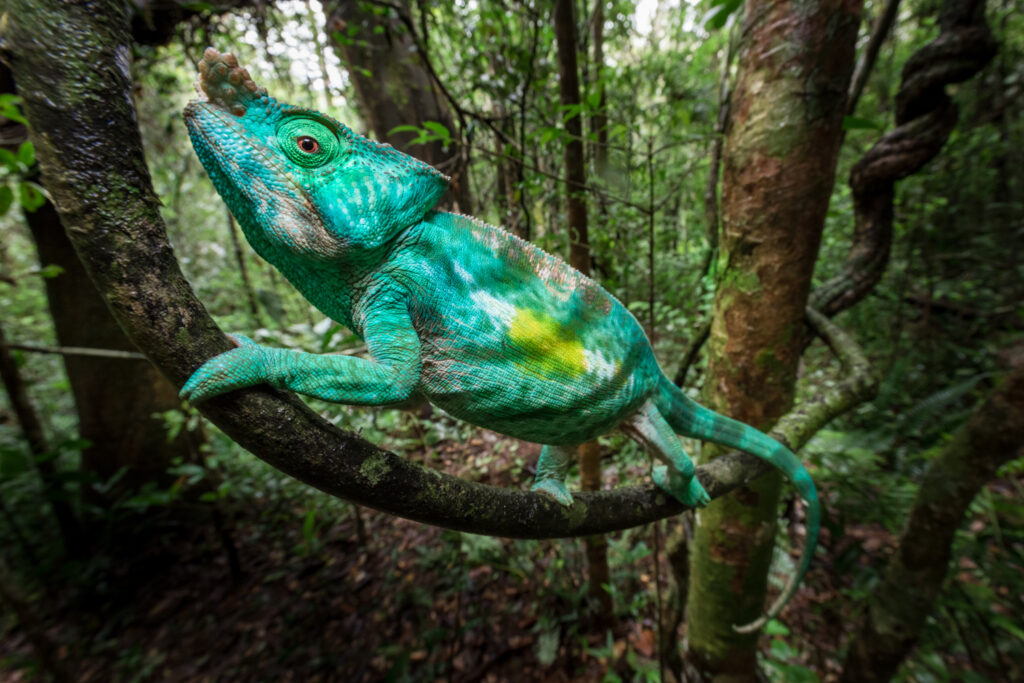
A male Parson's chameleon, one of the world's largest species, climbing in forest understorey in Andasibe-Mantadia National Park © Nick Garbutt
Nick and Madagascar

Who is looking at who? Nick with a female fosa
Nick is well-known as a leading authority on the wildlife of Madagascar. He first visited the island in 1991: with £200 in his pocket and 60 rolls of film, he spent a month back-packing and exploring four of the parks and reserves. Over the past 30 years, he has returned most years and in doing so has travelled the length and breadth of the island many times, visited all the major national parks and reserves and has seen 80% of the island's lemurs (now more than 100 species) and a very high proportion of the other native mammals and endemic fauna in the wild.
He has written several books on the island's wildlife, including the new and massively expanded Handbook of Mammals of Madagascar (Bloomsbury / Princeton UP 2023), plus Madagascar Wildlife: A Visitor's Guide (5th edition, 2023) and Chameleons. His enthusiasm for the country and its natural history remains undiminished and infectious.
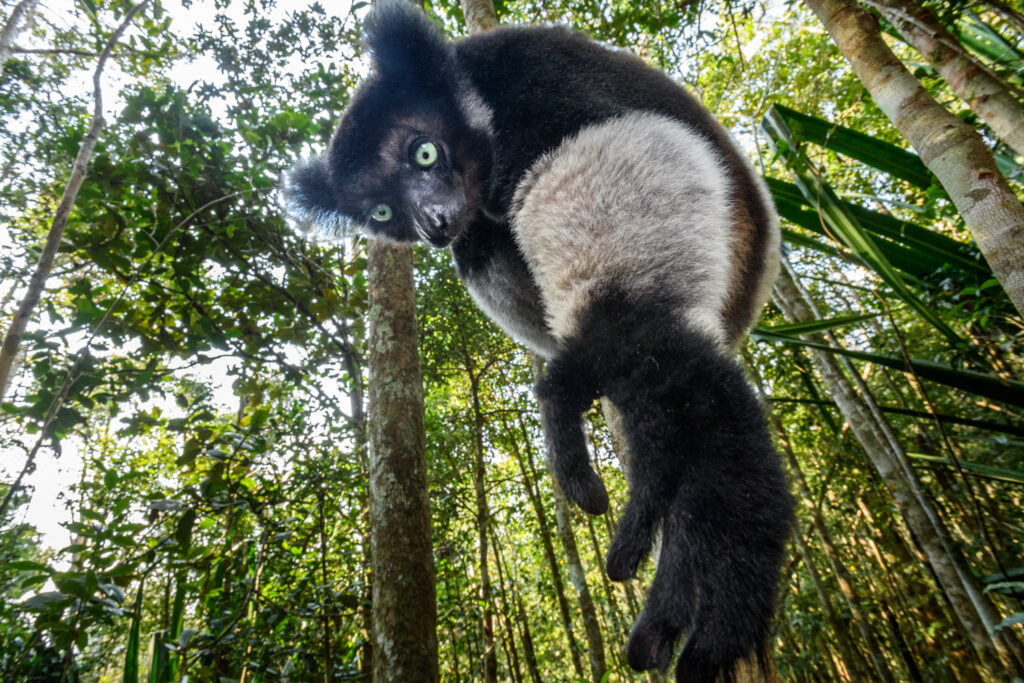
Male indri reaching for leaves in forest understorey. Mitsinjo Reserve, Andasibe-Mantadia National Park © Nick Garbutt
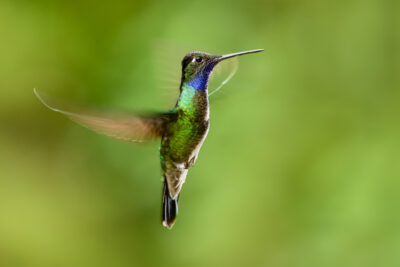
Male magnificent hummingbird in high montane forest © Nick Garbutt
Dates: 9th - 23rd May 2026
Price: £9,895 (Twin-share: Flights inclusive)
Price: £9,195 (Twin-share: Land Only)
Single Supplement: £1,695
Maximum Group 12
Current Availability: 3 places, please enquire
LEADERS: Nick Garbutt & Alex Hyde
Click for further details
 GRADING: Moderate. A variety of conditions from humid lowland rainforest, to higher elevation cooler cloud forests. Walks generally short, but sometimes medium length (1-2km). Mostly flat, but some hills can be moderate to steep with uneven under foot conditions (cloud forest areas). Early morning and late evenings as there are night walk options.
GRADING: Moderate. A variety of conditions from humid lowland rainforest, to higher elevation cooler cloud forests. Walks generally short, but sometimes medium length (1-2km). Mostly flat, but some hills can be moderate to steep with uneven under foot conditions (cloud forest areas). Early morning and late evenings as there are night walk options.
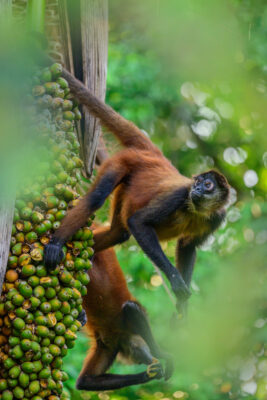
Adult Central American spider monkey feeding on palm fruits © Nick Garbutt

The Caribbean race of the iconic red-eyed tree frog has distinctive blue flanks © Nick Garbutt
Costa Rica has long been regarded as a Central American jewel, renowned for its remarkable biodiversity and extensive protected forest areas. The incredible array of wildlife results from its position connecting North and South America and its topography, as a central spine of mountains creates different habitats and forest types on the Pacific and Caribbean slopes.
On previous workshops we have included locations on both slopes, attempting to gain a full appreciation of the country’s incredible biodiversity. Whilst these have been successful, it’s meant a certain degree of compromise, as climatic variations dictate there is no time of the year when conditions are simultaneously ideal on both slopes.
Hence, we are now offering separate workshops, targeting prime locations on each slope at ideal times (the Pacific slope workshop is scheduled for September 2027).
On this workshop we visit locations on the Caribbean slope, beginning with Tortuguero on the coast, one of Costa Rica’s most famous national parks. It is renowned for turtle nesting, with four species using the park’s beaches to lay their eggs. Inland are forests and a labyrinth of waterways, where birds, primates (mantled howler monkey, Central American spider monkey) and reptiles like green basilisks are easily seen (jaguars and ocelots are very occasionally seen too!). This area is mainly explored by boat, but around our lodge and in other areas there will also be walks, including night walks, where spectacular frogs and a myriad of insects and other invertebrates will be our primary targets.

The yellow morph of the eyelash pit viper is sometimes called ‘oropel' © Nick Garbutt

The strawberry or blue jeans poison dart frog is active during the day and can often be seen of walks © Nick Garbutt
We then move onto the Sarapiqui region, one of the most biologically rich areas in Costa Rica. Situated at the base of the highland areas of Braulio Carrillo National Park, where the Sarapiqui River emerges into the lowlands, the region hosts a variety of accessible reserves and wildlife locations that we can explore. There will hopefully be opportunities to photograph iconic red-eyed tree frogs, strawberry and green-and-black poison dart frogs, glass frogs and various lizards and snakes, together with scarlet and great green macaws, and a wealth of insects including leaf-cutter ants.

Female Costa Rican orange-kneed tarantula in montane forest © Nick Garbutt
Our final locations is a private montane forest reserve high on the on the Caribbean slope. Here a variety of hummingbirds like violet sabrewing and magnificent hummingbird provide constant activity around the lodge and we will spend time working on various techniques to photograph them. The lodge grounds attract many other birds and mammals like agoutis, coatis and pacas (after dark). Trails through the forest and along the streams offer the chance of good photography opportunities especially for frogs after rain. The lodge has a moth trap which can attract a wondrous array of species at night and provide extensive macro photography options.

Colonies of leaf-cutter ants are a feature in most lowland areas © Nick Garbutt
Costa Rica is without question a fabulous wildlife destination. The combination of wonderful biodiversity, accessibility and good quality accommodation means it warrants a tour that offers both a breadth of experiences and extensive lengths of stay in each location to make the most of the excellent photographic possibilities.

The spectacular owl-eye butterfly, seen here shortly after emerging from its cocoon © Nick Garbutt
Why a Workshop?
Tropical rain forests are the greatest expressions of life on the planet and offer a wonderful array of species, but they are also amongst the most challenging places to take photos successfully. As such rain forest locations lend themselves ideally to workshop format tours, where fewer locations are visited but much longer is spent in the chosen locations than would be the case on a 'regular' tour.
In addition being hosted by two leaders, with a wealth of rain forest photography experience, means that the photographic potential and individual teaching opportunities for participants will be maximised, such that they gain as much insight as possible.
 Photography Equipment
Photography Equipment
A variety of equipment is useful, from a close-focus wideangle e.g. 16-35mm, to a dedicated macro lens e.g. 105mm, to a longer telephoto, e.g. telephoto zoom 100-400mm that will cover most situations. Flash equipment very useful. A longer telephoto e.g. 500mm or 600mm is better for birds. Waterproof protection for camera gear is recommended. A tripod is advisable.

Alex Hyde is undoubtedly one of the UK's leading macro photographers © Nick Garbutt
Alex Hyde
I am delighted to be joined by good friend Alex Hyde on this trip. Alex is one of the UK's finest exponents of macro photography, combining the best of art and science into his exquisite images. He is a master of the technical aspects of digital photography and in the field or indoor workshop environment has the enviable skill of being able to convey challenging topics and ideas, concisely, simply and in a way that makes them understandable. To see more of Alex's stunning work click here
Click: contact Wildlife Worldwide to book this tour
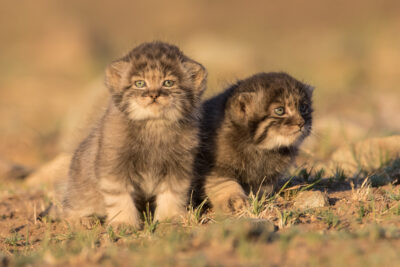
Pallas' cat kittens outside their den © Otgonbayar Baatargal
Dates: 18th - 31st July 2026 & 31st July - 13th August 2026
Price: £7995 (Twin-share: Flights inclusive)
Price: £7395 (Twin-share: Land Only)
Single Supplement: £750
Maximum Group 8
Current Availability: FULL
 GRADING: Moderate to Challenging. A reasonably good level of fitness is required to get the most out of this trip. Locations remote, and travel tiring. Accommodation in the field simple but comfortable. Days in the field will may be long and walks of 1-2km over uneven terrain may be necessary (carrying your camera gear).
GRADING: Moderate to Challenging. A reasonably good level of fitness is required to get the most out of this trip. Locations remote, and travel tiring. Accommodation in the field simple but comfortable. Days in the field will may be long and walks of 1-2km over uneven terrain may be necessary (carrying your camera gear).
Perhaps, more than any other country Mongolia epitomises the notion of wilderness: this region of Central Asia has captivated the psyche of explorers for centuries. Even today, when Western culture and lifestyle has infiltrated most corners of the globe, much of Mongolia remains steadfastly untouched, with a traditional nomadic and pastoral ways of life the norm outside the capital city Ulaanbataar. More specifically, these vast, virtually uninhabited lands, with seemingly endless landscapes, have captivated biologists and naturalists looking for something different.
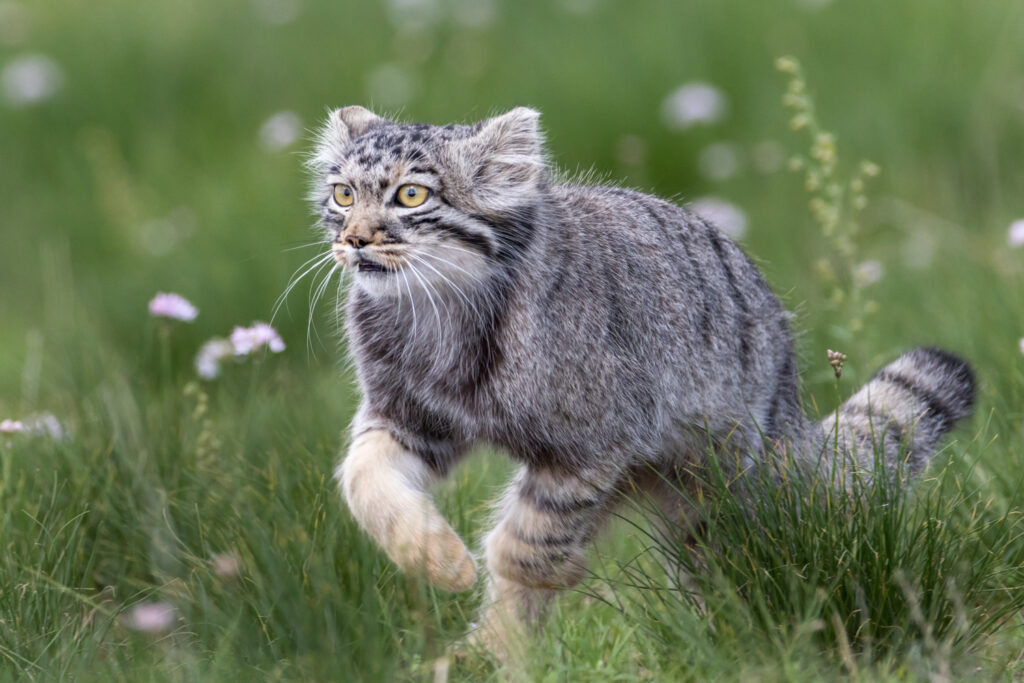
An adult Pallas's cat in summer grasslands © Otgonbayar Baatargal
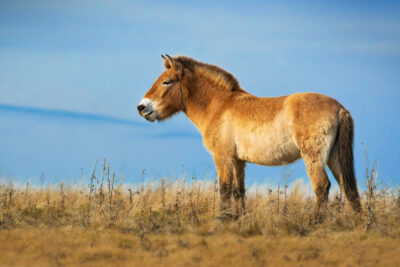
Przewalski's horse in Hustai National Park © Shutterstock
Mongolia encompasses a variety of contrasting biomes - along its southern border, the arid landscapes of the Gobi Desert, home to the last wild Bactrian camels; in the far west a stony semi-desert, stretching up into the imposing Altai Mountains, where snow leopards roam; in the north, straddling the border with Russia, there is the vast boreal forest or taiga (part of the largest forest on earth); and in the east, great rolling grasslands or steppes that are the focus of this tour and are home to many herds of ungulates, including Mongolian gazelle, as well being one of the strongholds of Pallas’s cat.
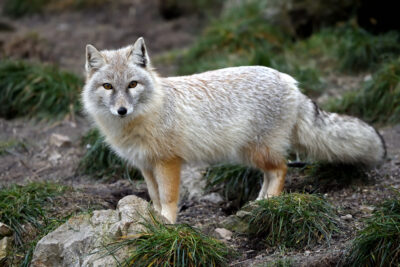
A corsac fox, another hardy inhabitant of the Mongolian steppe © Shutterstock
Although the range of Pallas’s cat covers a vast portion of Central Asia, from near the Caspian Sea in the west, to the Tibetan Plateau in the south, through China and into Mongolia and Russia, it is highly fragmented and they are nowhere common. Their populations primarily being limited by the distribution of their main prey species, pikas, voles and other rodents. Mongolia is home to the largest populations, with the Eastern Steppes a renowned stronghold, as they comprise grasslands with huge rodent numbers, interspersed with rocky outcrops that provide cover for the cats and ideal denning sites for rearing their young.
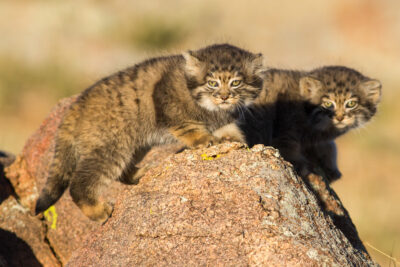
Pallas' cat kittens basking in evening sun © Otgonbayar Baatargal
Pallas’s cat have incredibly dense fur and are superbly camouflaged, so can be elusive. However, we will be working with local scientists and field guides (who also helped with filming the sequences for Planet Earth 3), at sites and locations where cat densities are relatively high, so we should hopefully have repeated rewarding encounters and sightings with this intriguing feline - because of its scowling expression, sometimes called the world's ‘grumpiest’ cat.
Mongolian summer days are long, with sunrise around 5.30am and sunset after 20.30pm. Given the hours around dawn and dusk are the times the cats are most active -especially when they are hunting - and we will be targeting these times to maximise our chances. However, when kittens require feeding, there can be hunting activity at any time their rodent prey is active, so consequently, some days in the field are likely to be long, but of course the potential rewards are high.
 Photography Equipment
Photography Equipment
Mainly telephoto: a lens of 500mm plus is recommended for Pallas’s cats and most other wildlife. Shorter lenses e.g. 70-200mm or 24-120mm for context, scenes and landscapes.
Click: contact Wildlife Worldwide to book this tour
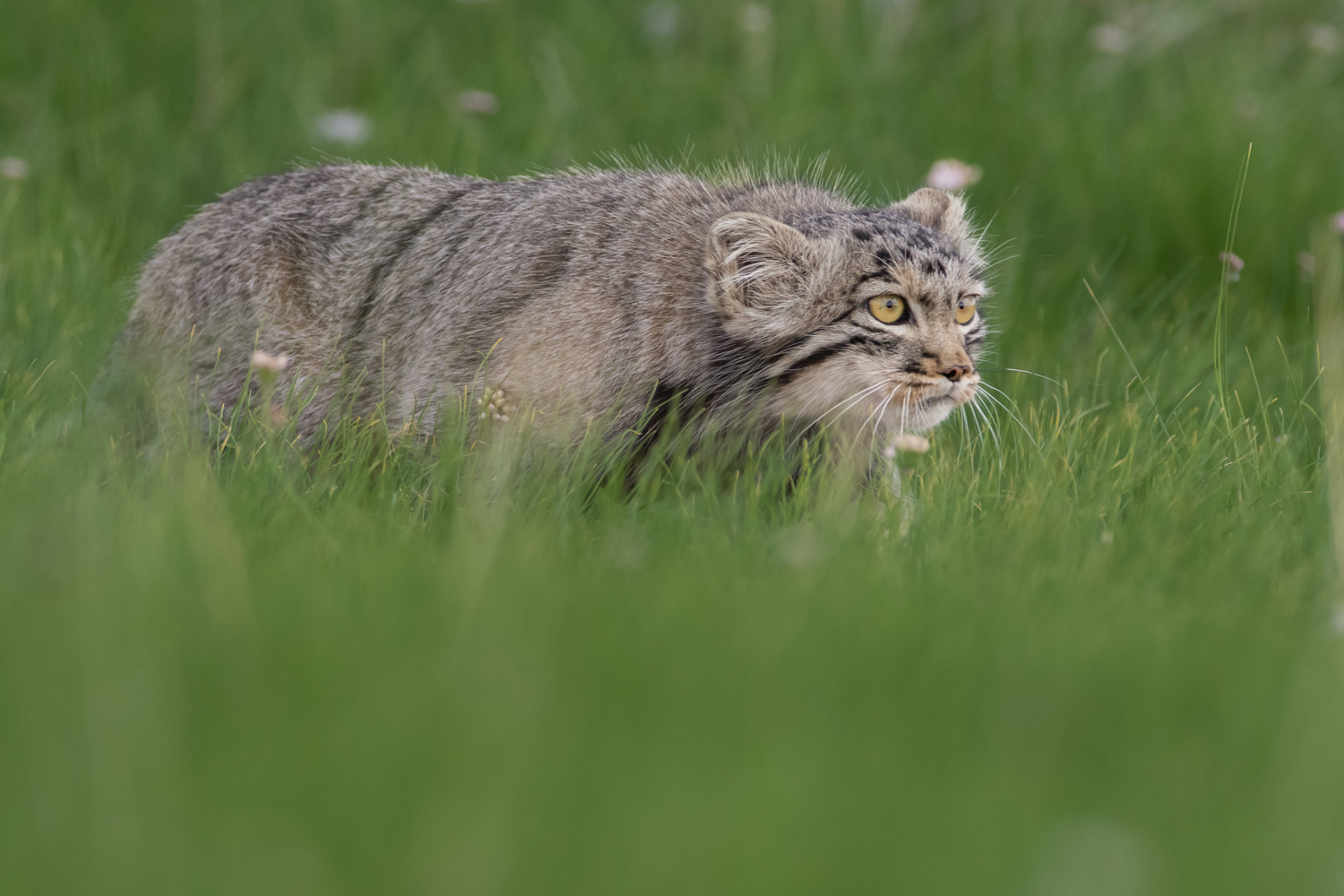
A Pallas' cat prowls through long grass looking for rodents © Otgonbayar Baatargal
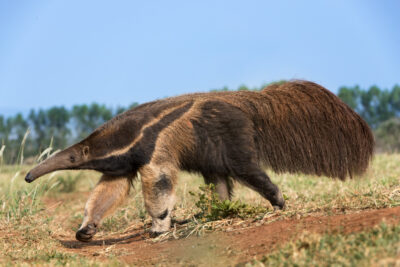
Southern areas of the Pantanal are excellent for seeing giant anteaters © Nick Garbutt
 Dates: 8th - 25th August 2026
Dates: 8th - 25th August 2026
Price: £14,995 (Twin-share: Flights inclusive)
Price: £13,995 (Twin-share: Land Only)
Single Supplement: please enquire
Maximum Group Size: 10
Current Availability: please enquire
Click for further details

Often shy, the toco toucan can readily be seen many locations in the Pantanal © Nick Garbutt
GRADING: Easy to Moderate. Hot, sometimes very hot, over 35˚C, but dry. Mainly vehicle-based, either open boats or open trucks. Short walk options over flat terrain at some lodges. Early mornings. Biting insects can be a nuisance around rivers.

A female southern tamandua carrying her offspring, northern Pantanal © Nick Garbutt
In the heart of South America, south of Amazonia and east of the Andes, lies an immense landlocked delta where seasonal floodwaters rise then recede providing an annual pulse of nutrients that results in one of the richest wildlife areas on earth - the Pantanal.
After rains in the surrounding uplands, more than 80% of the Pantanal becomes submerged (December-March) and wildlife is dispersed around the limited areas of dry land, but as these waters drain away and the land dries out, migratory birds return and other wildlife becomes more concentrated. These concentrations reach their peak in the dry season (July-October) when the remaining pools and flowing watercourses act like wildlife magnets.
The quantity of wildlife the area supports is breath taking, but it is more its accessibility that makes a trip to the Pantanal so memorable and rewarding photographically. Seeing iconic and rare animals frequently and at close quarters is a very real possibility.

A huge male jaguar emerges from cover on the river bank, Cuiaba River © Nick Garbutt

A female jaguar swimming across the Cuiaba River © Nick Garbutt
Of course, for most, jaguars top the wish list: there is no finer place in the world to see South America’s apex predator, and the chances of success are very realistic, especially along renowned rivers. Add to this, the likelihood of encounters with giant otter, Brazilian tapir, giant anteater, southern tamandua, hyacinth macaw, both howler and capuchin monkeys, jabirú storks, toco toucans, yellow anaconda and countless capybara and yacaré caiman, and it is easy to appreciate why the Pantanal is regarded as such a special place.
This huge area can conveniently be divided into North and South: each is different in character, with complimentary strengths and highlights. Hence, this trip has been designed to combine the best elements of both these regions and take in locations that offer a diversity of habitats, fauna and flora and of course photographic experiences.

The world’s largest rodent, a capybara hosting a pair of cattle tyrants © Nick Garbutt
In the northern Pantanal we begin the tour at a location along the famed Transpantaneira highway, where drying pools meld with open savanna areas and patches of woodland. There is a huge amount to see and photograph in and around the immediate vicinity of the lodge and we will explore the area on foot and more broadly by vehicle. There are also canopy towers, where birds and primate can be viewed.

A yellow anaconda catching fish at river edge © Nick Garbutt
Along the Cuiaba River, we will be based in a prime jaguar viewing location and will explore the main river and its tributaries by boat looking for the cats and other wildlife. The density of jaguars in this area is particularly high, and consequently, the frequency of sightings is normally very good.
Our final location is a remote private ranch in the southern Pantanal far away from other tourist facilities. Here we will concentrate on looking for iconic species like giant anteater and tapir, as well as a vast wealth of birds. The property also hosts conservation and research projects focusing on tapirs and the elusive giant armadillo.
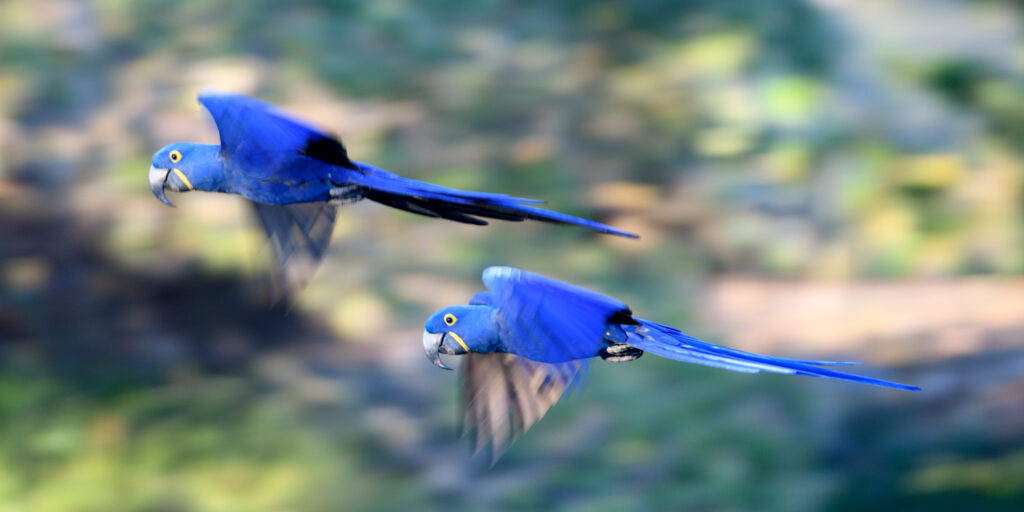
A pair of hyacinth macaws fly close to a lodge in the northern Pantanal © Nick Garbutt

A pair of red-and-green macaws at Buraco das Araras © Nick Garbutt
Extension: Buraco das Araras
In addition to the main tour, we are offering a two-night extension to the Jardim area, to visit Buraco das Araras, the incredible 'Sinkhole of the Macaws', where groups of spectacular red-and-green macaws can be photographed in flight and at close quarters against a stunning backdrop. There will also be opportunities to photograph many other birds and visit Rio do Prata to snorkel in its crystal-clear waters, where a wonderful array of fish can be seen. Further details are available on request.
 Photography Equipment
Photography Equipment
Mainly telephoto, e.g. 100-400mm or 100-500mm for jaguars, other mammals and birds. A longer telephoto e.g. 500mm or 600mm can be useful. Shorter lenses e.g. 70-200mm and 24-120mm good for habitats and landscapes. A tripod or monopod is useful from a boat.
Click: contact Wildlife Worldwide to book this tour

Buraco das Araras, the spectacular 'Sinkhole of the Macaws’ © Nick Garbutt

The spectacular oscillated turkey in Belize © Lucas Bustamente
Dates: 6th - 22nd September 2026
Price: £11,995 (Twin-share: Flights inclusive)
Price: £11,195 (Twin-share: Land Only)
Single Supplement: £1,295
Maximum Group 12
Current Availability: please enquire
LEADERS: Nick Garbutt & Alex Hyde
Click for further details
 GRADING: Moderate. A variety of conditions from humid lowland rainforest, to higher elevation cooler cloud forests. Walks generally short, but sometimes medium length (1-2km). Mostly flat, but some hills can be moderate to steep with uneven under foot conditions (cloud forest areas). Early morning and late evenings as there are night walk options.
GRADING: Moderate. A variety of conditions from humid lowland rainforest, to higher elevation cooler cloud forests. Walks generally short, but sometimes medium length (1-2km). Mostly flat, but some hills can be moderate to steep with uneven under foot conditions (cloud forest areas). Early morning and late evenings as there are night walk options.

A white-nosed coati climbing in forest understory © Nick Garbutt

The red-eyed tree frog is common in both Belize and Panama © Nick Garbutt
While Costa Rica attracts the plaudits, there are other countries in Central America that offer wonderful wildlife and photographic experiences, off the beaten track and away from the crowds. Two of these are Belize and Panama, that each still support vast tracts of tropical forest wilderness with corresponding impressive and accessible biodiversity.
We begin in Belize, a country with a relatively low human population and huge remaining areas of tropical forests. Both mammal and bird diversity is impressively high and around our established wilderness lodge, where species have become more tolerant, there is an excellent chance to encounter numerous species. Tapirs, jaguars and ocelots are often recorded on camera traps and are seen during daylight from time-to-time. More often seen are Central American spider monkeys and Yucatán black howler, while regularly seen birds include golden-hooded tanager, keel-billed toucan, oscillated turkey and perhaps even the elusive agami heron and ornate hawk-eagle.
While these species may be photographed opportunistically, we will also devote time and effort to finding and photographing a wealth of smaller creatures, notably various frogs including the iconic red-eyed tree frog, reptiles, including snakes and a myriad of insects and other invertebrates.

The islands of the Boca de Toro archipelago each support their own colour variant of the strawberry poison-dart frog. Perhaps this one should be renamed the ‘blueberry’ poison-dart frog? © Lucas Bustamente

Another colour variant of the strawberry poison dart frog © Lucas Bustamente
Lying at the narrowest part of the Central American isthmus, Panama occupies a globally important position, as constitutes a vital part of a biological corridor, connecting North and South America (Mesoamerican Biological Corridor), which facilitates a rich exchange of animal and plant species.

El Valle is a good place to look for glass frogs © Nick Garbutt
Our two primary locations provide great contrast. In the higher-elevation cloud forests of El Valle, we will explore a variety of trails and habitats and hope to encounter mammals like Geoffroy’s tamarin and Hoffmann’s two-toed sloth, as well as various tanagers, hummingbirds and toucans. Around the lodge and along the many trails, we also have a good chance to see a considerable diversity of frogs and reptiles that are sure to provide excellent photographic opportunities. These may include common basilisk, boquete rocket frog, brilliant forest frog, hourglass frogs and glass frogs.

A colony of common tent-making bats © Nick Garbutt
In contrast, Isla Bastimentos on the Caribbean coast offers fabulous opportunities for close encounters with capuchin monkeys, three-toed sloths and a variety of birds, reptiles and amphibians. There are several islands within the Boca de Toro archipelago, each of which support their own colour-variant of the strawberry poison-dart frog, some of which are not red and do not resemble strawberries! We hope to photograph a variety of these.
In combination, the varied locations we have chosen in Belize and Panama offer a wealth of wildlife and considerable photographic potential, making this tour an exciting addition to our established programme of rainforest workshop destinations.
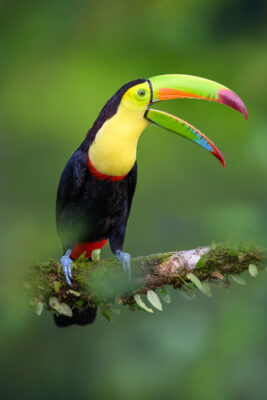
Adult keeled-billed toucan © Nick Garbutt
Why a Workshop?
Tropical rain forests are the greatest expressions of life on the planet and offer a wonderful array of species, but they are also amongst the most challenging places to take photos successfully. As such rain forest locations lend themselves ideally to workshop format tours, where fewer locations are visited but much longer is spent in the chosen locations than would be the case on a 'regular' tour.
In addition being hosted by two leaders, with a wealth of rain forest photography experience, means that the photographic potential and individual teaching opportunities for participants will be maximised, such that they gain as much insight as possible.
 Photography Equipment
Photography Equipment
A variety of equipment is useful, from close focus wideangle e.g. 16-35mm, to macro e.g. 105mm, to telephoto, e.g. telephoto zoom 100-400mm will cover most situations. Flash equipment very useful. A longer telephoto e.g. 500mm or 600mm is good for birds. Waterproof protection for camera gear is recommended. A tripod is advisable.

Alex Hyde is undoubtedly one of the UK's leading macro photographers © Nick Garbutt
Alex Hyde
I am delighted to be joined by good friend Alex Hyde on this trip. Alex is one of the UK's finest exponents of macro photography, combining the best of art and science into his exquisite images. He is a master of the technical aspects of digital photography and in the field or indoor workshop environment has the enviable skill of being able to convey challenging topics and ideas, concisely, simply and in a way that makes them understandable. To see more of Alex's stunning work click here
Click: contact Wildlife Worldwide to book this tour
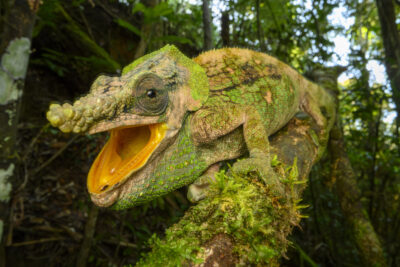
A malthe or 'green-eared' chameleon in Maromizaha Forest.
 Dates: 31st October - 11th November 2026
Dates: 31st October - 11th November 2026
Price: £9,995 (Twin-share: Flights inclusive)
Price: £8,995 (Twin-share: Land Only)
Single Supplement: please enquire
Maximum Group 35
Current Availability: please enquire
Extension Option: The Far North
Dates: 10th - 19th November
Price: £TBC (Twin-share)
Click for further details
 GRADING: Moderate. A variety of conditions from hot (over 35˚C), dry forest (north west, Anjajavy), to cooler mid-elevation rainforests (central east, Andasibe). All wildlife watching is on foot. Walks are generally short to medium length (1-3km), but occasionally may be longer and inclines can be steep with uneven footing, especially in rainforest locations. Both early morning and late evenings as there are night walk options in both locations.
GRADING: Moderate. A variety of conditions from hot (over 35˚C), dry forest (north west, Anjajavy), to cooler mid-elevation rainforests (central east, Andasibe). All wildlife watching is on foot. Walks are generally short to medium length (1-3km), but occasionally may be longer and inclines can be steep with uneven footing, especially in rainforest locations. Both early morning and late evenings as there are night walk options in both locations.
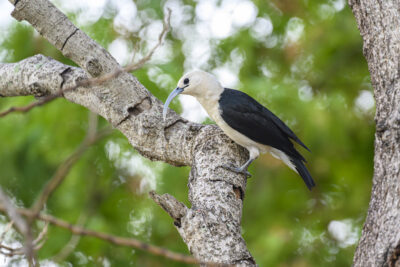
The striking sickle-billed vanga is readily seen at Anjajavy.
Madagascar is an island full of intrigue that is without equal and the destination for the 2026 Festival of Wildlife. We will visit two major wildlife-rich locations, the rainforests of Andasibe and the dry deciduous forests of Anjajavy, that in combination offer very different and complimentary highlights sure to generate an unforgetable wildlife experience.
The first location is Andasibe-Mantadia National Park, arguably Madagascar’s premier eastern rainforest reserve. Our exclusive base is Mantadia Lodge, which offers easy access to several different forest sites, where we should encounter indris, diademed sifakas, several other varieties of lemur, numerous chameleons, and a bewildering array of other endemic species, all at close quarters. Those with an interest in smaller creatures will be in their element with enigmatic creatures like giraffe-necked weevils, giant stick insects, colourful frogs and cryptically camouflaged leaf-tailed geckos to discover.
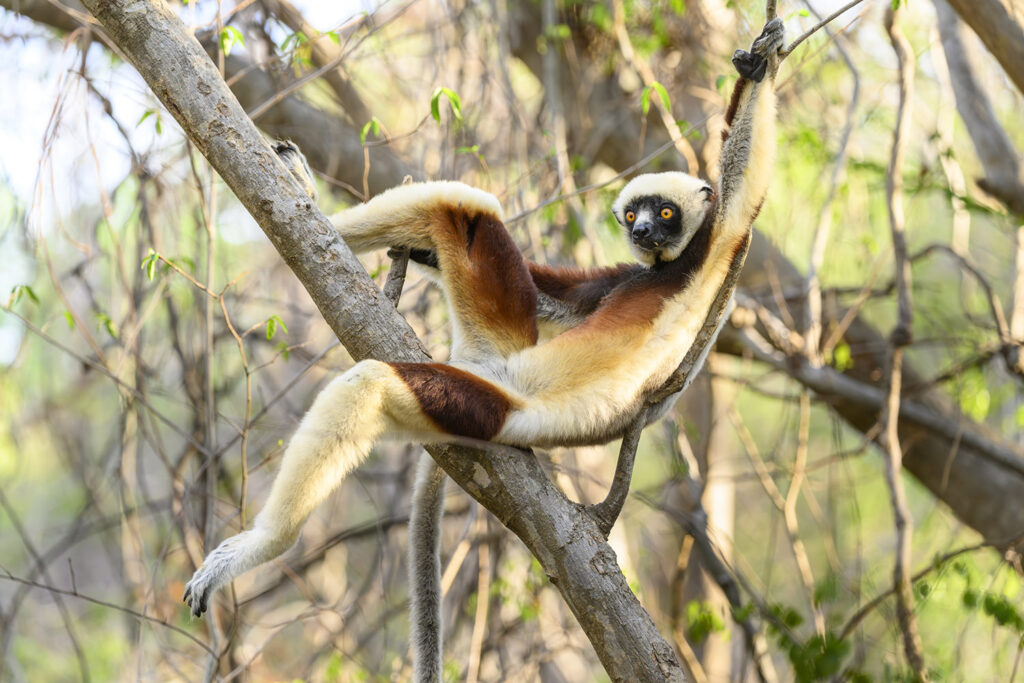
A lazy Coquerel's sifaka relaxes in the forests at Anjajavy.
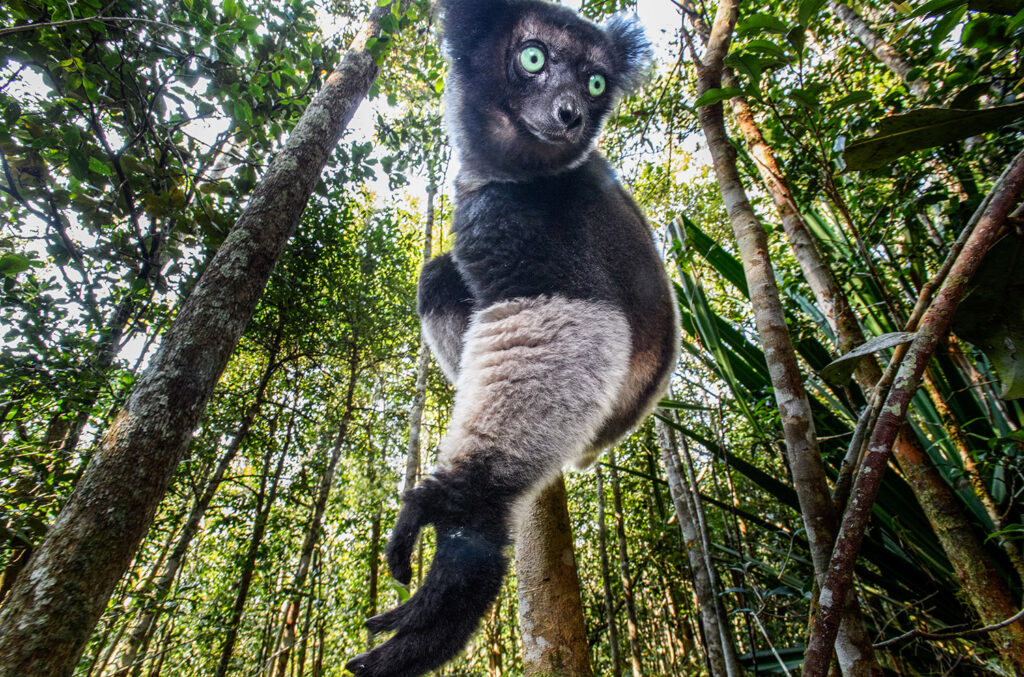
The largest of the extant lemurs, the indri in Andasibe-Mantadia National Park.
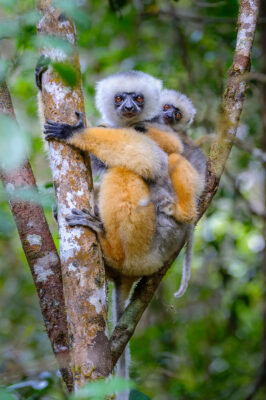
Female diademed siafaka with 3 months old infant.
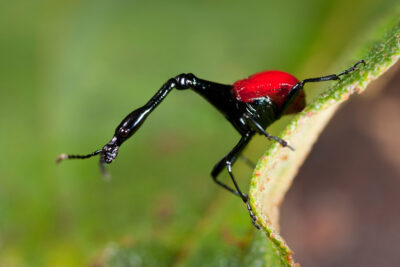
The bizarre male giraffe-necked weevil.
We then move onto the beautiful beach front Anjajavy l'Hôtel in the north-west, where we have a private reserve of dry deciduous forest and picturesque coastline on our doorstep. Within the grounds of our lodge and in adjacent forests, stunning Coquerel’s sifakas and brown lemurs leap between the trees and after dark diminutive mouse and sportive lemurs can be seen. There are also numerous chameleons and other reptiles to see, together with a large number of endemic birds such as crested coups, sickle-billed vangas and the extremely rare Madagascar fish-eagle.
At this time of year, we can enjoy maximum wildlife activity with baby lemurs clinging to their mothers, chameleons can be found lower in the trees, the endemic birds defend their breeding territories and the austral summer active species like tenrecs, frogs and dwarf lemurs all emerging from their winter torpor.

A Coquerel's sifaka bounds across open ground between forest patches at Anjajavy.
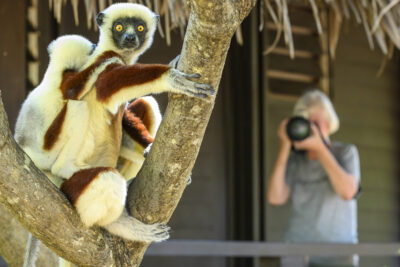
Beautiful Coquerel's sifakas are daily visitors to the grounds and forests immediately adjacent to the lodge at Anjajavy.
Accompanied by a team of expert guides, including Nick Garbutt, Mark Carwardine, Mike Dilger and Nick Mackman, we'll be treated to a unique wildlife extravaganza in a destination like no other.
 Photography Equipment
Photography Equipment
A variety of equipment is useful, from close focus wideangle e.g. 16-35mm for forest scenes, to macro e.g. 105mm for chameleons, frogs and insects, to telephoto, e.g. 100-400mm for lemurs and birds. Flash equipment very useful. A tripod is advisable.
Click: contact Wildlife Worldwide to book this tour
Nick and Madagascar

Who is looking at who? Nick with a female fosa
Nick is well-known as a leading authority on the wildlife of Madagascar. He first visited the island in 1991: with £200 in his pocket and 60 rolls of film, he spent a month back-packing and exploring four of the parks and reserves. Over the past 30 years, he has returned most years and in doing so has travelled the length and breadth of the island many times, visited all the major national parks and reserves and has seen 80% of the island's lemurs (now more than 100 species) and a very high proportion of the other native mammals and endemic fauna in the wild.
He has written several books on the island's wildlife, including the new and massively expanded Handbook of Mammals of Madagascar (Bloomsbury / Princeton UP 2023), plus Madagascar Wildlife: A Visitor's Guide (5th edition, 2023) and Chameleons. His enthusiasm for the country and its natural history remains undiminished and infectious.
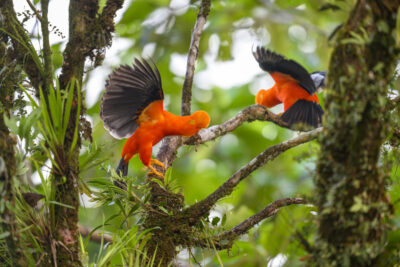
The Andean cock-of-the-rock can be seen a lek sites in cloud forests near Mindo and Sumaco © Nick Garbutt
Dates: 2027 TBC
Price: £TBC (Twin-share: Flights inclusive)
Price: £TBC (Twin-share: Land Only)
Extension Price: £TBC
Maximum Group 12
Current Availability: please enquire
LEADERS: Nick Garbutt & Alex Hyde
 GRADING: Moderate. A variety of conditions from hot, humid lowland rainforest, to higher elevation cool cloud forests. Walks generally short to medium length (1-2km), but hills can be moderate to steep and uneven under foot, particularly in cloud forest areas. Early morning and late evenings as there are night walk options. High altitude in some locations e.g. Quito can affect some people.
GRADING: Moderate. A variety of conditions from hot, humid lowland rainforest, to higher elevation cool cloud forests. Walks generally short to medium length (1-2km), but hills can be moderate to steep and uneven under foot, particularly in cloud forest areas. Early morning and late evenings as there are night walk options. High altitude in some locations e.g. Quito can affect some people.
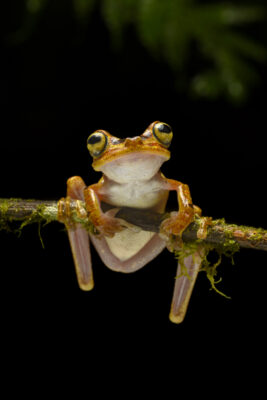
Frogs abound in the forest locations we visit: this is an Imbabura tree frog © Nick Garbutt
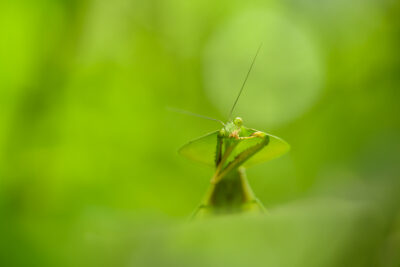
A shield mantis cleaning itself © Nick Garbutt
Ecuador is an amazingly rich, diverse and rewarding wildlife and photography destination. Lying on the equator, straddling both the east and west slopes of the Andes and encompassing the western extreme of the Amazon Basin, Ecuador supports 15% of the world's known bird species and in the Ecuadorian Amazon, live over 30% of all bird species in Amazonia.
But such staggering levels of diversity alone do not necessarily make for a prime photographic destination; the accessibility of the wildlife is also key. Here Ecuador also scores very highly. Locations chosen for this tour include some of the most astonishing hummingbird sites on earth, where literally dozens of species can be seen and photographed and two Amazonia locations that are each different in character, but in combination offer a range of excellent options and sites from quiet back waters, to parrot clay licks to rainforest canopy platforms.
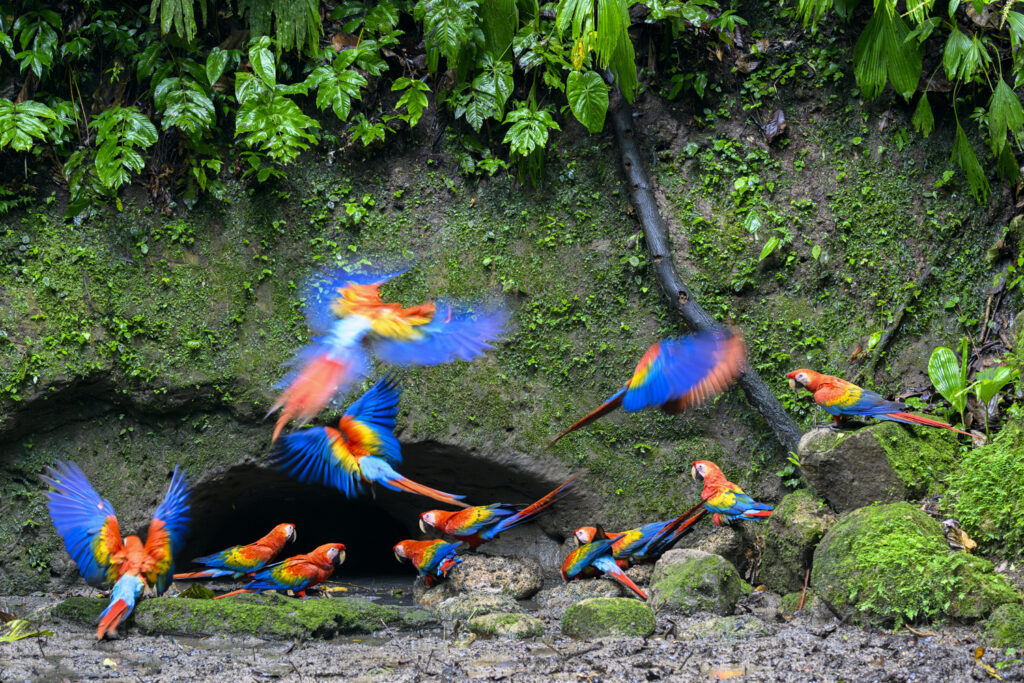
Spectacular scarlet macaws gather at a renowned clay-lick along the Napo River © Nick Garbutt
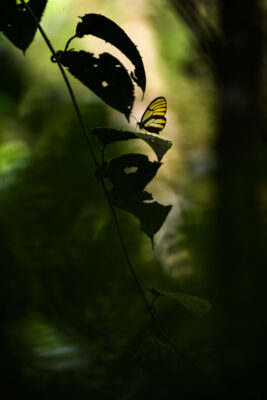
A long-winged or Heliconius butterfly rests in a pool of sunlight © Nick Garbutt
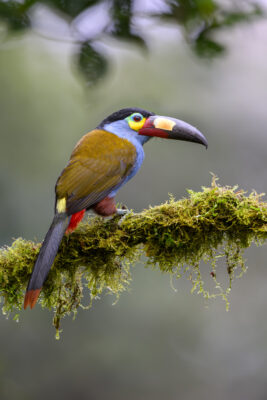
A plate-billed mountain toucan in the cloud forests near Mindo © Nick Garbutt
Beginning in the cloud forests on the western slopes of the Andes we are based in a secluded valley, where bird diversity in general and hummingbird diversity in particular is astounding. Within the lodge grounds over 30 species of hummingbird have been seen and up to 20 of these visit the lodge feeders on a daily basis. Diversity on the eastern slopes of the Andes is equally impressive, but the species composition is different and therefore offers a wealth of new and enthralling photographic opportunities. Our lodge is a prime place to see the amazing sword-billed hummingbird, which in relation to body size, has the longest beak of any bird.
From the Andes, we travel into the Amazon Basin and divide our time between two locations that again offer different experiences and photographic opportunities. Both are located along the Napo River, but on opposite banks, where species likely to be seen and photographed will vary. One location may give us the chance to observe one of the regions top carnivores, the endearing giant otter and there will also be an opportunity to visit a renowned parrot-lick on at least one occasion.
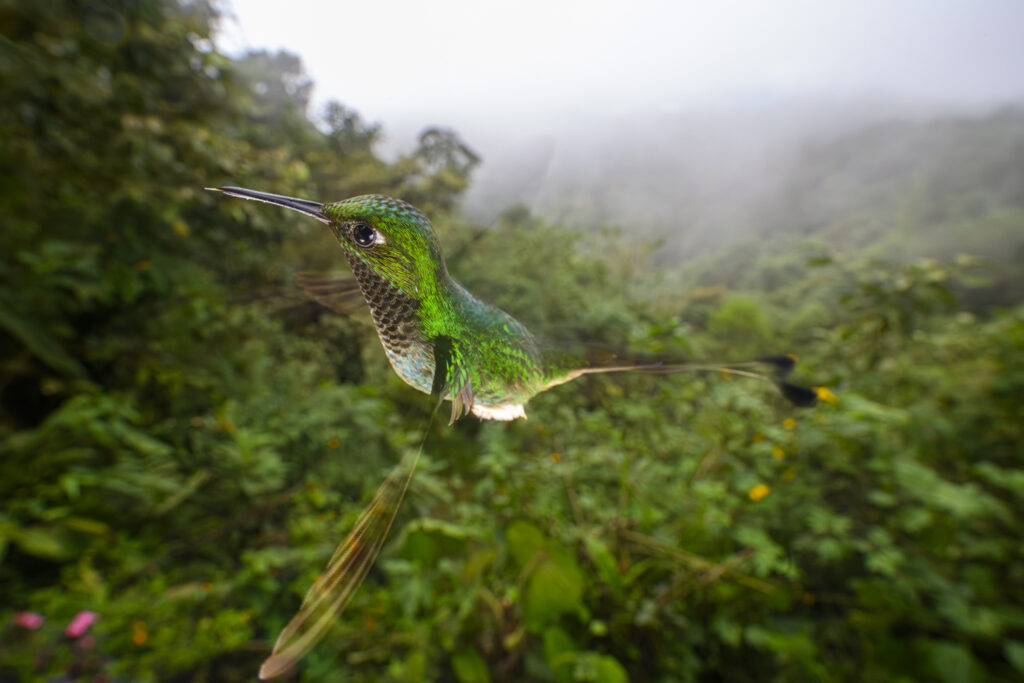
A male booted racket-tail hummingbird in cloud forest near Mindo © Nick Garbutt
The photographic opportunities on this tour will be broad. In all locations we will spend time looking for the more accessible wildlife like frogs, reptiles and insects which lend themselves to macro techniques. Bird and mammal photography will be more opportunistic, but is certainly rewarding, especially from canopy platforms. In the Andes there will also be time to get to grips with hummingbird photography, including various aspects of using flash.
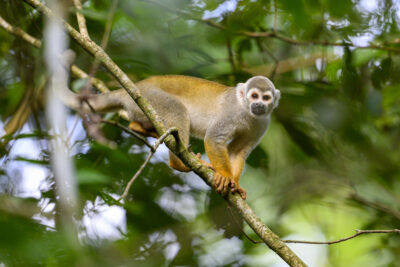
An inquisitive male squirrel monkey in the Amazon © Nick Garbutt
Why a Workshop?
Tropical rain forests are the greatest expressions of life on the planet and offer a wonderful array of species, but they are also amongst the most challenging places to take photos successfully. As such rain forest locations lend themselves ideally to workshop format tours, where fewer locations are visited but much longer is spent in the chosen locations than would be the case on a 'regular' tour.

Osborne’s lancehead pit-viper in the forest understorey © Nick Garbutt
In addition being hosted by two leaders, with a wealth of rain forest photography experience, means that the photographic potential and individual teaching opportunities for participants will be maximised, such that they gain as much insight as possible.


Alex Hyde photographing a White Witch moth, Manu Biosphere Reserve © Nick Garbutt
Photography Equipment
A variety of equipment is useful, from close focus wideangle e.g. 16-35mm, to macro e.g. 105mm, to telephoto, e.g. telephoto zoom 100-400mm will cover most situations with invertebrates, frogs and reptiles. Flash equipment very useful. A longer telephoto e.g. 500mm or 600mm is good for birds and mammals. Waterproof protection for camera gear is recommended. A tripod is advisable.
Alex Hyde
I am delighted to be joined by good friend Alex Hyde on this trip. Alex is one of the UK's finest exponents of macro photography, combining the best of art and science into his exquisite images. He is a master of the technical aspects of digital photography and in the field or indoor workshop environment has the enviable skill of being able to convey challenging topics and ideas, concisely, simply and in a way that makes them understandable. To see more of Alex's stunning work click here
Click: contact Wildlife Worldwide to book this tour

Macro enthusiasts will enjoy the challenge of photographing leaf-mimic bush crickets or katydids © Nick Garbutt
Dates: TBC: September 2027
Price: £TBC (Twin-share: Flights inclusive)
Price: £TBC (Twin-share: Land Only)
Single Supplement: £TBC
Maximum Group 12
Current Availability: please enquire
LEADERS: Nick Garbutt & Alex Hyde
Click for further details
GRADING: Moderate. A variety of conditions from humid lowland rainforest, to higher elevation cooler cloud forests. Walks generally short, but sometimes medium length (1-2km). Mostly flat, but some hills can be moderate to steep with uneven under foot conditions (cloud forest areas). Early morning and late evenings as there are night walk options.

The montane forests of Savegre are home to the emerald toucanet © Nick Garbutt
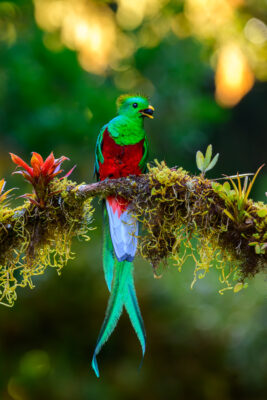
One of the world's most beautiful birds: a male resplendent quetzal in the forest understorey © Nick Garbutt
Costa Rica has long been regarded as a Central American jewel, renowned for its remarkable biodiversity and extensive protected forest areas. The incredible array of wildlife results from its position connecting North and South America and its topography, as a central spine of mountains creates different habitats and forest types on the Pacific and Caribbean slopes.
On previous workshops we have included locations on both slopes, attempting to gain a full appreciation of the country’s incredible biodiversity. Whilst these have been successful, it’s meant a certain degree of compromise, as climatic variations dictate there is no time of the year when conditions are simultaneously ideal on both slopes.
Hence, we are now offering separate workshops, targeting prime locations on each slope at ideal times (the Caribbean slope workshop is scheduled for May 2026).
On this workshop we visit locations on the Pacific slope, beginning in the high montage forests of the Savegre Valley. This is a renowned location for the resplendent quetzal, arguably Costa Rica’s most iconic bird, as well as other species like emerald toucanet and various hummingbirds. These upland forests are festooned with mosses and lichens and are also ideal places to search for interesting macro subjects like leaf mimic mantises and bush crickets (katydids).

The lowlands of Golfo Dulce and the Osa Peninsula are excellent places to look for red-eyed tree frogs © Nick Garbutt

High in the canopy on the Osa Peninsula rests a mantled howler monkey © Nick Garbutt
Leaving the cool of the highlands our next location is the lowland rainforest of the Golfo Dulce region. Our lodge has a sizable area of private forest bordering the Piedras Blancas National Park and is particularly rich in bird life, but also supports excellent populations of mammals including primates, coatis and tayra, together with amphibians including red-eyed tree frogs and glass frogs, and reptiles like iguanas and basaliks. Macro enthusiasts will also enjoy the opportunities to photograph a large variety of spectacular invertebrates, including leaf-cutter ants.

A fer-de-lance lies concealed in leaf litter on the rainforest floor © Nick Garbutt
Our final location is the Osa Peninsula, situated in the far south on the Pacific coast. Our lodge overlooks the ocean and the extensive private rainforest areas harbor a fabulous diversity of wildlife: capuchins, spider, howler and squirrel monkeys are generally seen, while coatis and agoutis live in and around the gardens. There are plenty of frogs (including poison dart frogs and red-eyed tree frogs), reptiles and invertebrates to find and photograph. The forest reserve also harbour pumas, ocelots and even jaguars that are captured on camera-traps and seen very occasionally.

A female tropical shield mantis waiting in ambush © Nick Garbutt
The bird life is diverse: yellow-throated toucans and fiery-billed aracaris are generally seen, while scarlet macaws visit on a daily basis and can provide excellent photography opportunities as they fly, often at near eye level, between roosting and feeding areas.
Costa Rica is without question a fabulous wildlife destination. The combination of wonderful biodiversity, accessibility and good quality accommodation means it warrants a tour that offers both a breadth of experiences and extensive lengths of stay in each location to make the most of the excellent photographic possibilities.

A female white-nosed coati and young, Osa Peninsula © Nick Garbutt
Why a Workshop?
Tropical rain forests are the greatest expressions of life on the planet and offer a wonderful array of species, but they are also amongst the most challenging places to take photos successfully. As such rain forest locations lend themselves ideally to workshop format tours, where fewer locations are visited but much longer is spent in the chosen locations than would be the case on a 'regular' tour.
In addition being hosted by two leaders, with a wealth of rain forest photography experience, means that the photographic potential and individual teaching opportunities for participants will be maximised, such that they gain as much insight as possible.
 Photography Equipment
Photography Equipment
A variety of equipment is useful, from a close-focus wideangle e.g. 16-35mm, to a dedicated macro lens e.g. 105mm, to a longer telephoto, e.g. telephoto zoom 100-400mm that will cover most situations. Flash equipment very useful. A longer telephoto e.g. 500mm or 600mm is better for birds. Waterproof protection for camera gear is recommended. A tripod is advisable.

Alex Hyde is undoubtedly one of the UK's leading macro photographers © Nick Garbutt
Alex Hyde
I am delighted to be joined by good friend Alex Hyde on this trip. Alex is one of the UK's finest exponents of macro photography, combining the best of art and science into his exquisite images. He is a master of the technical aspects of digital photography and in the field or indoor workshop environment has the enviable skill of being able to convey challenging topics and ideas, concisely, simply and in a way that makes them understandable. To see more of Alex's stunning work click here
Click: contact Wildlife Worldwide to book this tour
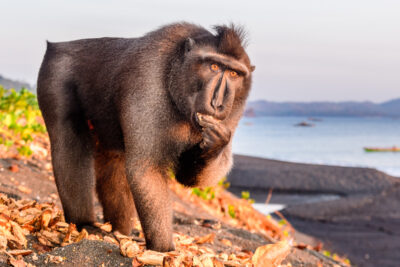
A male Sulawesi black crested macaque forages on an exposed beach at low tide © Nick Garbutt
Dates: October 2026: TBC
Price: £TBC
Single Supplement: Please Enquire
Maximum Group 10
Current Availability:
 GRADING: Moderate. Hot, sometimes very hot (over 35˚C): humid in Tangkoko, dry in Komodo. Walks in Tangkoko can be tiring - either along sandy beach or up to 3km through forest. Walks in Komodo mainly short. Very early mornings. Biting insects can be a nuisance.
GRADING: Moderate. Hot, sometimes very hot (over 35˚C): humid in Tangkoko, dry in Komodo. Walks in Tangkoko can be tiring - either along sandy beach or up to 3km through forest. Walks in Komodo mainly short. Very early mornings. Biting insects can be a nuisance.
Sulawesi, a curiously-shaped island lying off the east coast of Borneo, is a land of huge contrasts. The dramatic and varied landscapes - rugged mountains, pristine rain forest, highland lakes, idyllic beaches and rich coral reefs – are home to an amazing variety of flora and fauna, much of which is endemic.
Mammals such as crested black macaque, Sulawesi bear cuscus, spectral tarsier and babirusa are found nowhere else. In addition around 90 bird species are endemic too, as are a high percentage of the islands’ reptiles and amphibians.
The islands’ position and location relative to other islands also contributes to its unique nature. Sulawesi juxtaposes the biological influences of South East Asia and Australasia and sits in a zone of transition, where these two great contrasting biotas meet and meld. This zone is known as Wallacea, named after Alfred Russell Wallace, who first identified the phenomenon.
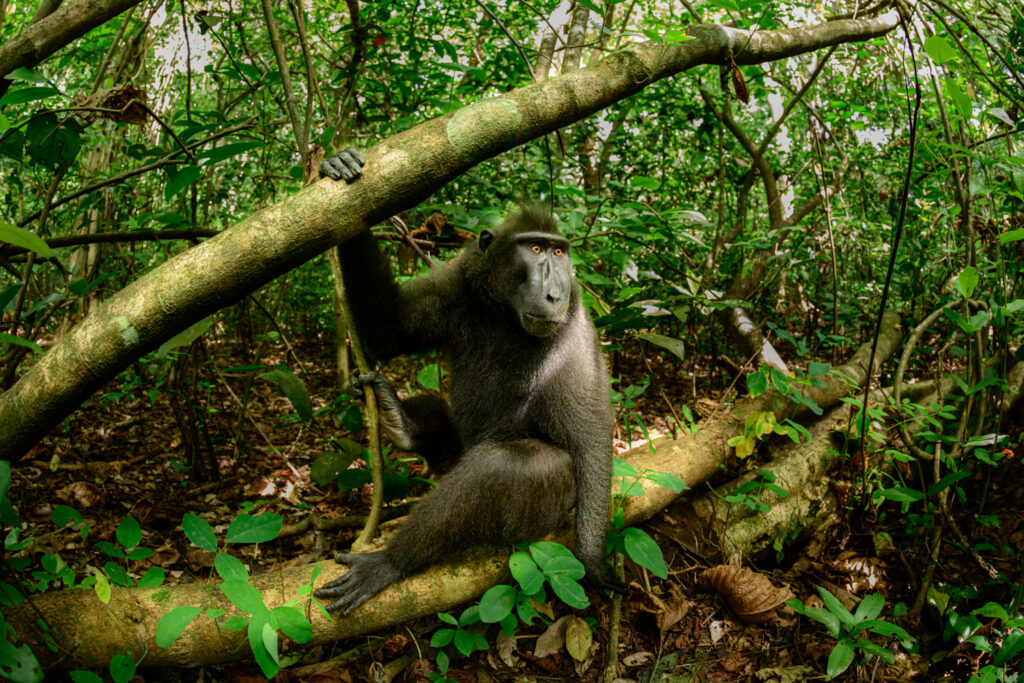
A large male Sulawesi black crested macaque rests on the forest floor © Nick Garbutt
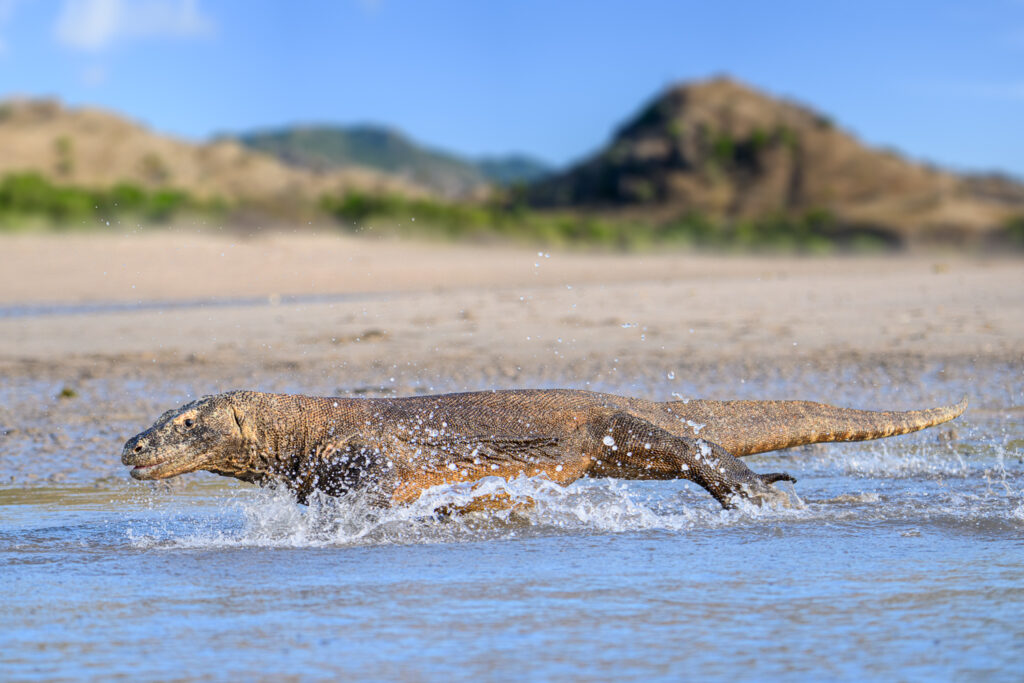
Like a scene from Jurassic Park: a male Komodo Dragon runs through the surf at low tide © Nick Garbutt
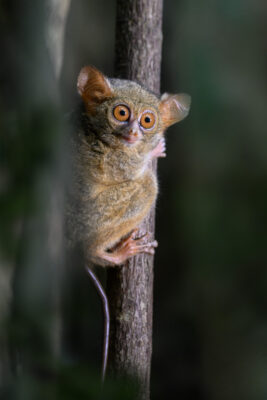
A spectral tarsier becomes active at dusk in Tangkoko National Park © Nick Garbutt
Tangkoko Batuangus Nature Reserve at the extreme north east tip of Sulawesi offers the best and most diverse introduction to the island’s wildlife. Located at the foot of Mount Dua Saudara, the area comprises rolling hills and valleys cloaked in rain forest that supports a variety of hardwood species and unusual plant life.
The endemic crested black macaque, known locally as the wolai or yaki, is the park’s most conspicuous mammal and is now restricted to the forests of North Sulawesi and some of the smaller surrounding islands. It is one of seven endemic monkey species: all are threatened due to the loss of their forest habitat and hunting, although the yaki is the most critically endangered of all.
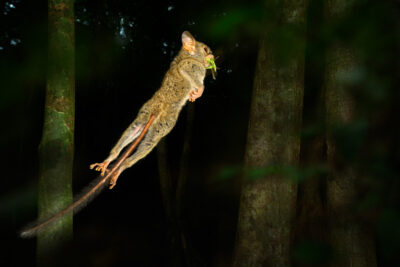
A spectral tarsier grabs a quick snack, a bush cricket © Nick Garbutt
Tangkoko is also renowned as a place to see another endemic primate, the spectral tarsier. Like all tarsiers these miniscule primates are primarily nocturnal and are able to leap great distances in pursuit of their prey, generally large insects like bush crickets and cockroaches.
We will obviously look for tarsiers during night walks (but they can be seen during daylight in certain places), where we also might see the unusual Sulawesi bear cuscus, a nocturnal marsupials that lives in the forest canopy. On night walks some of the islands’ unusual reptiles and amphibians might hopefully be seen, although success very much depends on rainfall (they are more visible when it is wet).
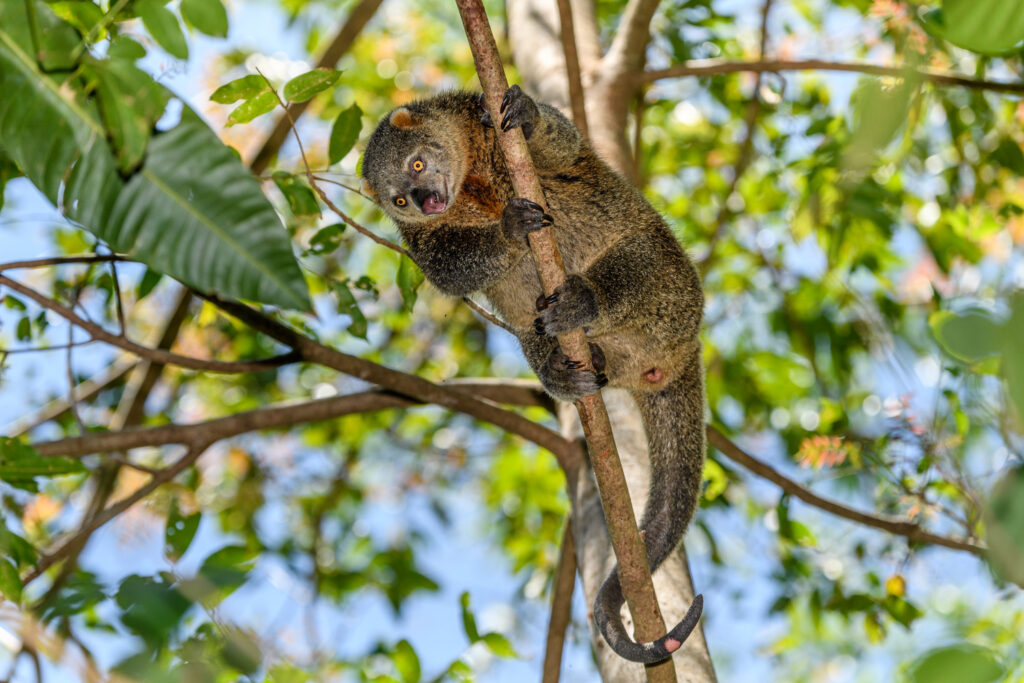
The Sulawesi bear cuscus is a Wallacea oddity sometimes seen in Tangkoko © Nick Garbutt
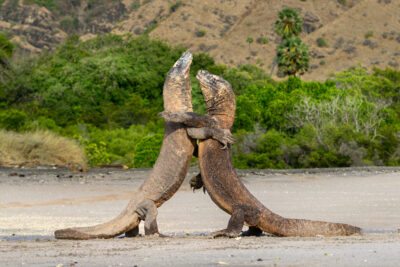
Two male Komodo dragons square up and battle © Nick Garbutt
The bird life of the park is diverse and extensive, with many of Sulawesi’s endemic species readily seen. During our forest walks we will hope to see the magnificent knobbed hornbill and a number of the ten species of kingfisher that have been recorded. Several of these are primarily forest birds, including the spectacular green-backed kingfisher and Sulawesi lilac kingfisher. Other birds to look out for include the Sulawesi scops owl and ochre-bellied boobook (hawk-owl).
Some 1325km (825 miles) to the south, and east of Wallace’s Line, is the island of Komodo, famed as the home of the eponymous dragon. Komodo dragons are in fact monitor lizards. Isolated islands are associated with the evolution of giant species: Komodo dragons are the world’s largest lizards, weighing up to 70kg.
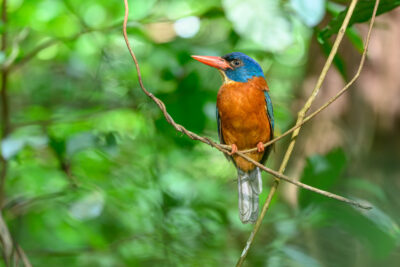
A male green-backed kingfisher in forest understorey in Tangkoko © Nick Garbutt
Today the dragons are masters of their domain, the apex predator in the island ecosystem they dominate. While they eat a variety of prey including invertebrates when they are small and birds and mammals, very large dragons are capable of bringing down deer and even buffalo. They also scavenge carrion.
Komodo National Park comprises the three main islands of Komodo, Rinca and Padar, plus numerous smaller islands. Komodo and Rinca support the main populations of dragons and have been developed for tourism. The climate is hot and dry and the islands are characterised by savannah grasslands consequently biodiversity on the islands is poor.
During our time visiting the national park we will be based on our live aboard boat and visit both Komodo and Rinca to hopefully maximise our opportunities to see and photograph the dragons when the light is good, early morning and late afternoon. During the middle portion of the day we will explore other off shore areas and have opportunities to snorkel over coral reefs and perhaps even swim with giant manta rays.
 Photography Equipment
Photography Equipment
In Tangkoko, both wideangle and telephoto, e.g. 16-35mm, 24-120mm and 100-400mm for primates and birds. Flash useful in Tangkoko. In Komodo, mainly 70-200mm and 100 - 400mm, but wideangle may be an option. A tripod is useful.
Click: contact Wildlife Worldwide to book this tour
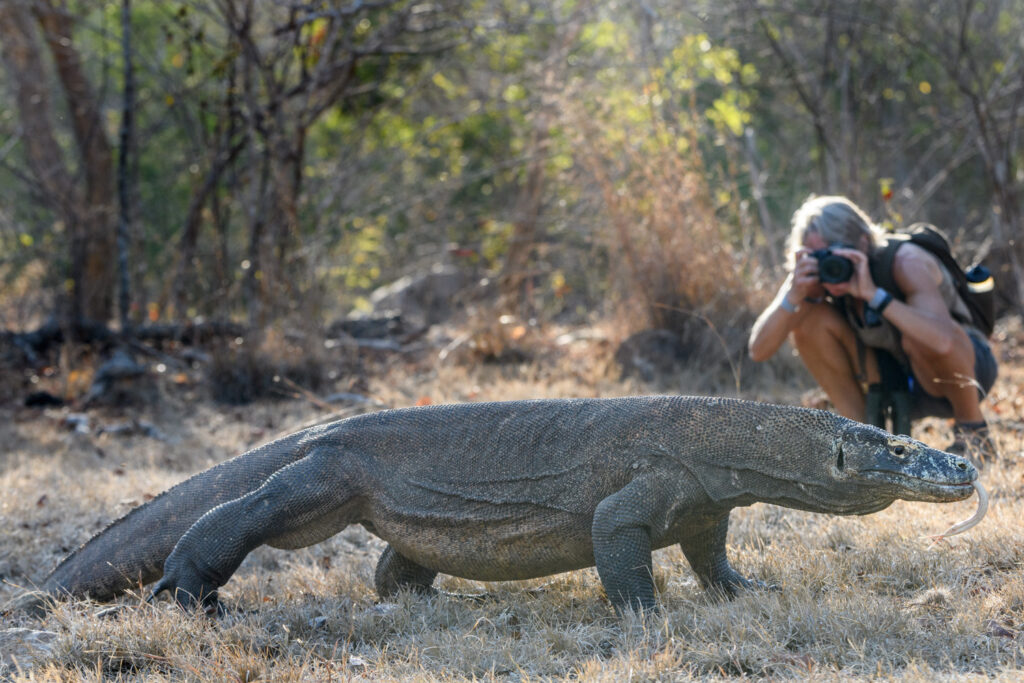
A large male Komodo dragon being photogrphed at close quarters © Nick Garbutt
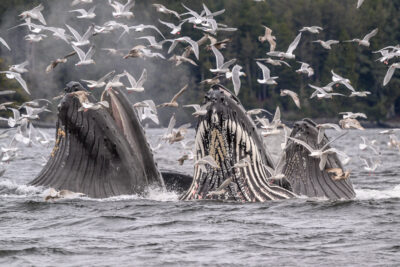
Humpbacks can feed for over 20 hours in a day and consume two tonnes of fish, in this case Pacific herring. They also provide feeding opportunities for hundreds of glaucous-winged gulls. © Nick Garbutt
Dates: TBC
Price: £TBC (Twin-share: Flights inclusive)
Price: £TBC (Twin-share: Land Only)
Single Supplement: £TBC
Maximum Group 6
Current Availability:
Click for further details
 GRADING: Easy. This trip is entirely boat-based. In-shore waters are generally fairly calm and sheltered areas are always sought, but stormy weather and lumpy seas are sometimes encountered.
GRADING: Easy. This trip is entirely boat-based. In-shore waters are generally fairly calm and sheltered areas are always sought, but stormy weather and lumpy seas are sometimes encountered.

An adult sea otter feeding near an offshore island. © Nick Garbutt
Compile a short list of top wildlife spectacles to photograph and chances are, mass Humpback Whale bubble net feeding will feature. There can be few more pulse racing sights than a group of ten or more whales simultaneously erupting through the surface of the ocean, mouths a gape with throat grooves bulging and water cascading through baleen while thousands of fish tumble this way and that in the roiling sea, while above hundreds of sea birds gather to pick off the debris.
The waters off the Pacific north west of British Columbia and Alaska are renowned locations where this behaviour may be witnessed, but pinpointing time and place specifically can be challenging.
However, certain bodies of water surrounding islands in the Alaskan Panhandle, attract particularly vast schools of migrating and spawning Pacific Herring in spring and sub-populations of Humpbacks have learned to time their own migration to take advantage of this.
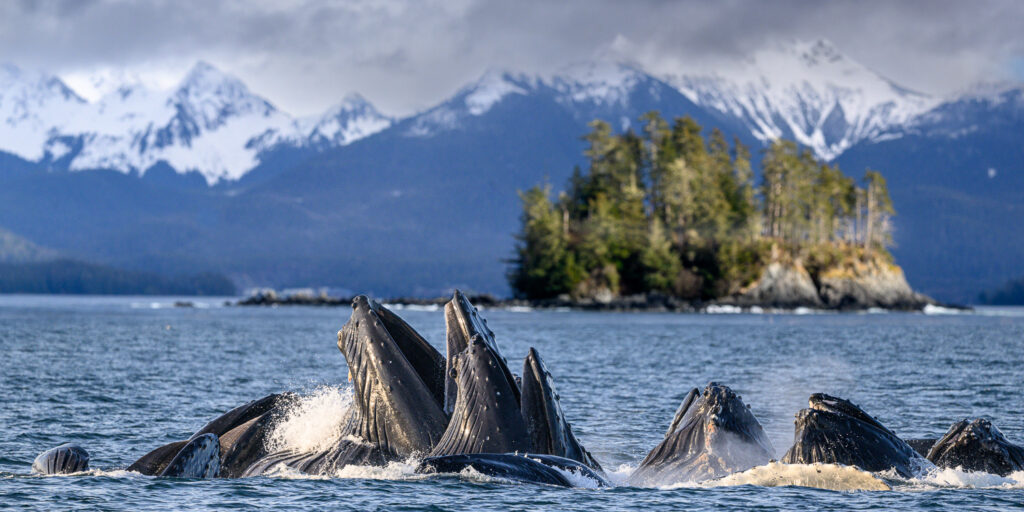
Sitka Sound provides a spectacular backdrop for watching Humpback Whales bubble net feeding at close quarters. © Nick Garbutt
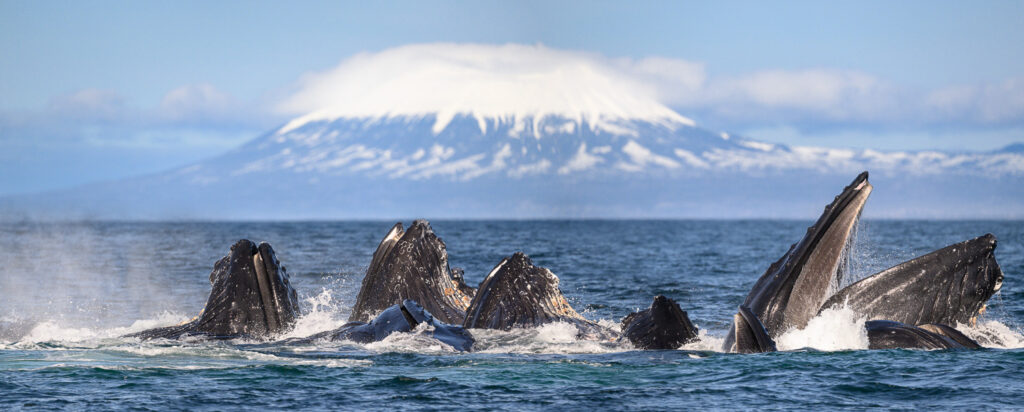
With Mount Edgecumbe as a backdrop, a pod of Humpback Whales erupt at the surface. When Pacific herring are plentiful and conditions are right, groups of up to 20 whales may feed like this 60 to 100 times per day. © Nick Garbutt
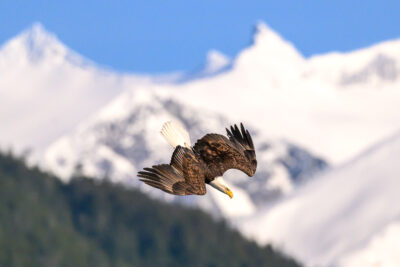
A bald eagle in mid stoop © Nick Garbutt
Having given birth to their calves in the warm waters off Hawaii, some Humpbacks specifically migrate to the waters around Baranoff Island and especially Sitka Sound, a renowned location for colossal schools of Herring gathering between mid-March and early April. Having not fed for months, the Humpbacks gorge themselves on the annually predicable feast: pods of 10 to 20 whales spend the entire day bubble net feeding and we will be there at the prime time to witness these tumultuous events. It is regular to witness between 30 and 50 and sometimes as many as 100 bubble net feeding events per day!
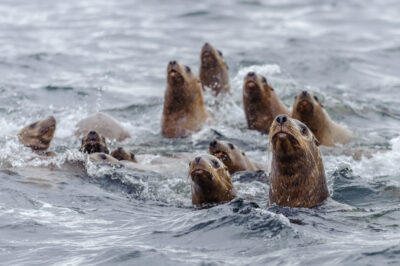
Stellar's Sea Lions, the largest of all sea lions, are relatively common in the waters of Sitka Sound. © Nick Garbutt
In addition the waters around Baranoff Island are home to other migrating and resident cetaceans including Pacific Grey Whales, Bigg’s (Transient) Orcas, Harbour Porpoise, Pacific White-sided Dolphins and other mammals like Stellar’s Sea Lions, Harbour Seals and Sea Otters.
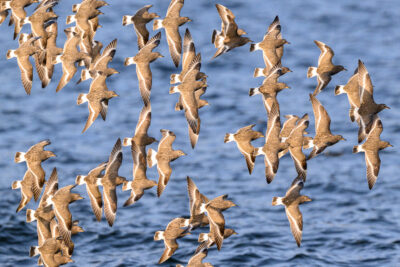
A flock of surfbirds close to the shoreline © Nick Garbutt
The bird life is also prolific and includes hundreds of Bald Eagles, which can often be seen scavenging around the fleet of fishing boats that frequent the area during the herring run. There are also several species of gulls, Common and Hooded Mergansers, numerous waterfowl like Buffleheads, Barrows and Common Golden Eyes, Harlequin Ducks and Surf Scoters, and shore birds like Blue Herons, Belted Kingfishers, Surfbirds and Black Oyster Catchers.
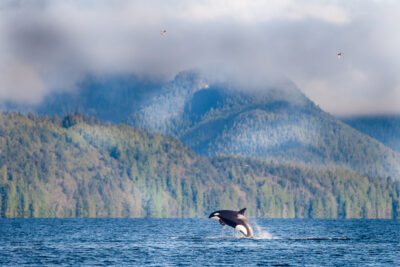
Although not common in Sitka Sound, Bigg's (Transient) Orcas are seen from time to time. © Nick Garbutt
We have chartered a purpose-built small whale-watching vessel, with a highly experienced crew who specialise in whale and wildlife photography tours and will spend seven full days exploring the waters of Sitka Sound and the surrounds to maximise our interactions with and viewings of Humpback Whales and their bubble-net feeding antics and the other wildlife of the area.
 Photography Equipment
Photography Equipment
Mainly telephoto: a telephoto zoom e.g. 100-400mm will serve for most situations with whales. A 500mm is useful for eagles and other birds. Shorter wideangle-telephotos e.g. 24-120mm can be useful. Waterproof protection for camera gear is advisable.
Click: contact Wildlife Worldwide to book this tour

Bald Eagles are adept at picking off dead fish that fall from the nets of fishing boats: this is a composite of nine consecutive frames, showing the precision and skill of a fishing bald eagle © Nick Garbutt
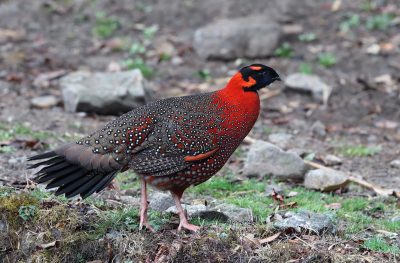
A stunning satyr tragopan ©Tom Kogut Photography
Dates: TBC
Price: £TBC (Twin-share: Flights inclusive)
Price: £TBC (Twin-share: Land Only)
Maximum Group 8
Current Availability: Please enquire
There can be few animals that the adjectives ‘cute’, 'adorable' and ‘endearing’ are more applicable to than the red panda. Yet the opportunities for seeing these delightful mammals in the wild have, until very recently, been scarce. One of the reasons for this, is that their limited range in the foothills of the Eastern Himalayas has been very difficult and time consuming to access. They are restricted to dense temperate mid-elevation mountain forests where bamboo - the core constituent of their diet - flourishes.
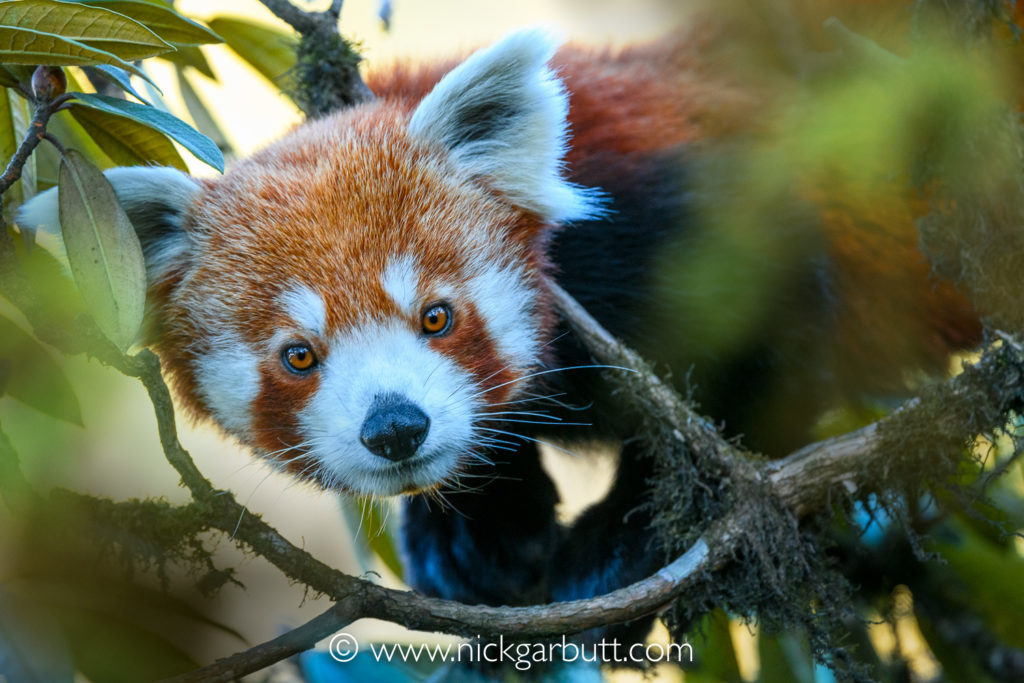
Possibly the cutest animal on the planet? An inquisitive adult red panda in the forest canopy
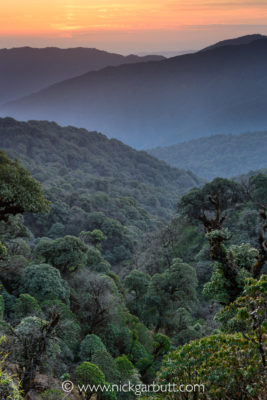
The temperate broad-leaf forest covering the sleep slopes of Singalila provides a home for a wealth of unusual species
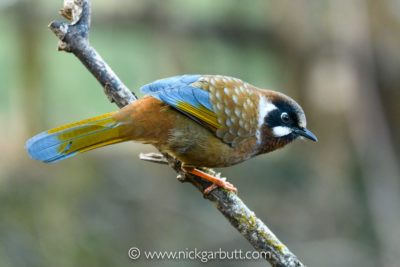
The black-faced laughingthrush is often seen close to the lodge
Singalila National Park in the Darjeeling area, on the border of India and Nepal, lies on a ridge at elevations above 2150m (7000ft) and up to 3600m (11,800ft) and is dominated by temperate broad-leaf and coniferous forest, with bamboo, oak and rhododendron species to the fore. The broad-leaf forest is ideal red panda habitat and in recent years the park has become an increasingly reliable location for seeing the 'forgotten panda'.
The park is also home to a wonderful array of birds - over 120 species have been recorded, including many rare and normally difficult-to-see species that are restricted the the Himalayan foothills and forest habitats. These include several species of laughing thrush, yellow-billed blue magpie, the spectacular satyr tragopan, kalij pheasant and brown and fulvous parrotbills.
All wildlife watching and photography in Singilila is on foot and red pandas and numerous bird species are often seen within relatively short distances of our lodge. Clearly the red pandas will be our primary focus of this tour, but the birdlife of the area is sure to also provide plenty of photographic inspiration.
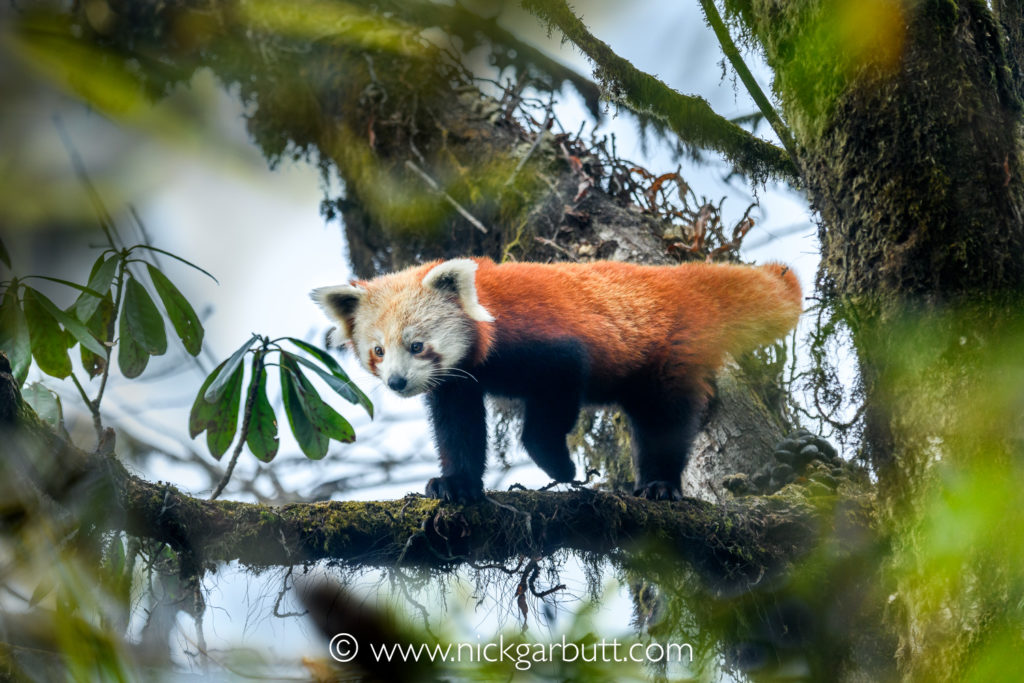
Although they sleep for prolonged periods, with patience it is also possible to see red pandas active in the forest canopy
This tour combines a long stay in Singalila with an extended visit to Kanha National Park, one of the most picturesque and biologically diverse Central Indian tiger reserves.
Kanha's tiger population is robust with probably over 100 spread across the entire park. We will be based at the southern side of the park, with our game drives predominantly in the Mukki zone, where tiger sighting are generally reliable and there is also the potential to see leopards, sloth bears and of course a variety of ungulates like chital (spotted deer), sambar, barasingha (swamp deer) and wild boar.
In both parks, we will stay at comfortable lodges that are ideally placed to allow us to access the reserves and surrounding areas for the best photographic opportunities.

A male tiger strolls through sal forest
Click: contact Wildlife Worldwide to book this tour
With thanks to Tom Kogut Photography for the use of his photos.
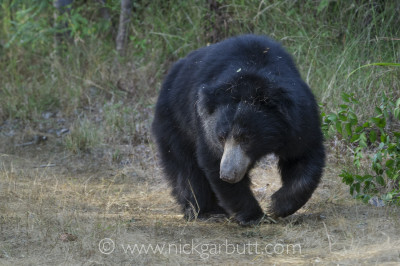
A sloth bear foraging in Bandhavgarh
Dates: TBC
Price: £TBC (Twin-share: Flights inclusive)
Price: £TBC (Twin-share: Land Only)
Single Supplement: Please Enquire
Maximum Group 8
Current Availability:
Click for further details
Nowhere is quite like India. Be it sights, sounds or smells the Subcontinent serves up a continuous and compelling assault on the senses. Few places are more evocative or magical than one of its ancient forests. Shrouded in morning mists with shafts of light spearing through the canopy spangled in a palette of gold, ochre, oranges and greens, there is intense charged excitement when the alarm calls of monkeys and deer break the silence. On velvet paws, a tiger takes its first steps of the day. No other animal plucks awareness and sets the pulse racing quite like a tiger: even an inkling that there may be one in proximity - concealed, lurking, silent - sets the nerve-ends jangling.
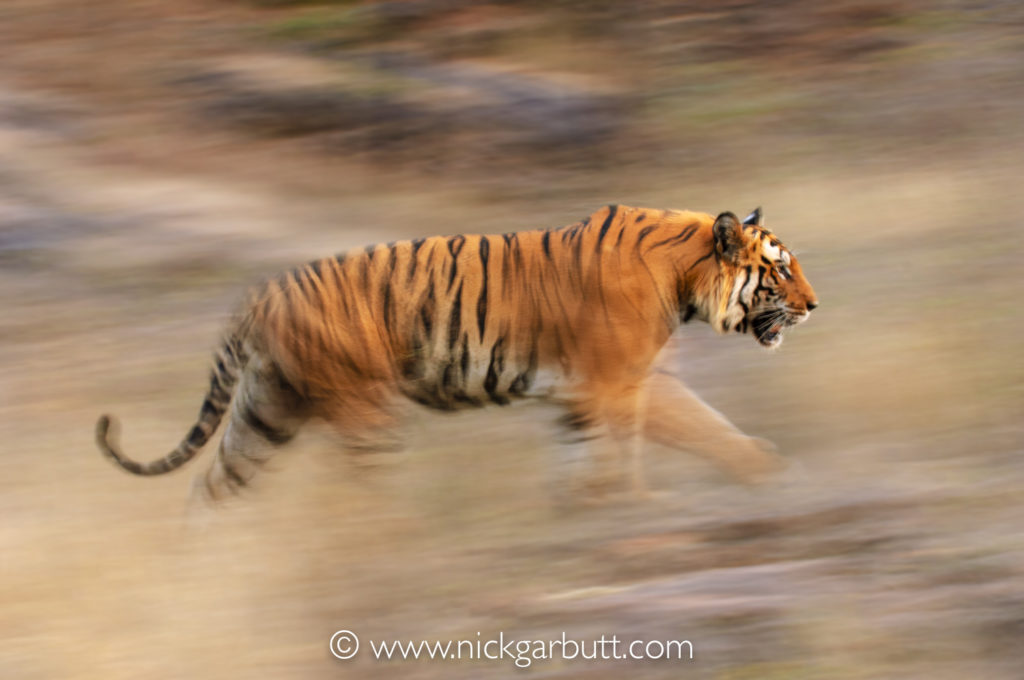
Male tiger patrolling territory, Bandhavgarh National Park.
With the specific focus on photographing tigers, this tour visits two of Central India’s premier reserves. Bandhavgarh is a small reserve famed for its tiger viewing. It is a former hunting preserve of the Maharajas of Rewa and became a protected area in 1972. A mixture of low-lying meadows, mixed forest and bamboo spreading into rocky hills, the park provides plenty of habitat variety creating excellent predator country. The park is administered in three tourism zones, each of which have different habitats and characteristics and tigers are regularly seen in each of these.
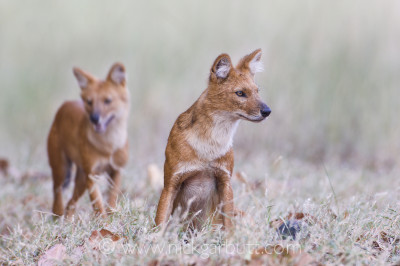
Both Kanha and Bandhavgarh support populations of dhole or Indian wild dogs
While some of India's tiger reserves suffer from tourist overcrowding, resulting in unrewarding wildlife experiences, others have brought in regulations with significant benefits. One of these is Kanha National Park, where strictly enforced speed limits have improved the tiger watching experience immeasurably. Kanha is a mosaic of hilly terrain covered in deciduous sal forest and bamboo, and low-lying open meadows that form focal areas for wildlife. Kanha, is situated in the Maikal hills, in the Satpura range, and provides a quintessential Central India experience. Many believe its forests provided the inspiration for Kipling’s ‘Jungle Book’. It is without doubt one of Central India’s most diverse reserves and has been a Project Tiger reserve since 1974.
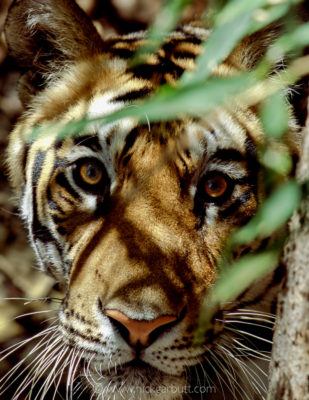
The intense stare of a tiger is incomparable
However in India it is all too easy to become preoccupied with one animal - the tiger - and judge the success of a tour solely around the number and quality of sightings. Yet the parks, reserves, forests and remaining wild places of the subcontinent support a wealth of other charismatic species that are also exciting to see and photograph. Both Bandhavgarh and Kanha support a broad diversity of other wildlife and especially large mammals, including leopards, sloth bears, dhole (wild dogs), gaur (Indian bison), sambar and chital (spotted deer). These too will feature strongly and hopefully provide plenty of photographic opportunies.
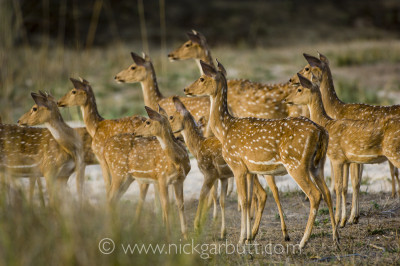
These spotted deer or chital are alert to a prowling predator
The time of year for this tour is also import. Many choose to visit India in the spring months (March - May) when air temperatures are higher, vegetation is drying out and it starts to get dusty. This trip is specifically timed for the latter part of winter, when the environments tend to be more atmospheric. Early mornings are cool (and can be cold) and mists often hang over the damper meadows creating conditions with more evocative photographic potential and prolonged quality light.
By concentrating on these two renowned parks, this tours aims to maximise the very best tiger photography opportunities, as well as plenty of potential to photograph other species.
Click: contact Wildlife Worldwide to book this tour
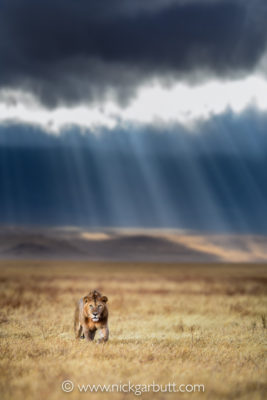
The Ngorongoro Crater often provides dramatic conditions and light.
Dates: TBC
Price: £TBC (Twin-share: Flights inclusive)
Price: £TBC (Twin-share: Land Only)
Single Supplement: Please Enquire
Maximum Group 8
Current Availability: provisional names being taken
Click for further details
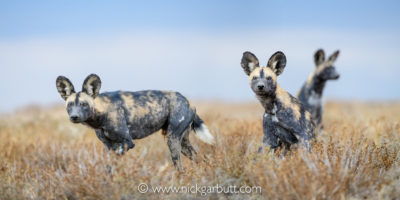
African painted dogs are gradually making a comeback in the Serengeti
The annual migration of wildebeest, zebra and other ungulates around the Serengeti-Masai Mara ecosystem is one of the world's greatest wildlife wonders and one that provides endless excitement and photographic opportunities. The spectacle is an ongoing event with the herds constantly on the move in search of the best grazing. Their movements are governed by the cycle of rains, which dictates that the animals follow a predictable annual circuit around the vast ecosystem.
Between July and October rains fall in the northern Serengeti and across the border in Kenya's Masai Mara and over three million animals gather to feed on the fresh grasses. The Mara River flows through this region from north east to south west and presents a barrier that the animals must cross in both directions on a regular basis. River crossings take place at numerous known locations and in the northern Serengeti several are used frequently in proximity to the mobile camp we use as our base.
Witnessing these crossings is a spectacular and compelling experience and also often provides fantastic and varied photographic possibilities, featuring not only the wildebeest and zebra that are crossing the river but also predators, like crocodiles, hyenas and lions that take advantage of the sometimes easy hunting.
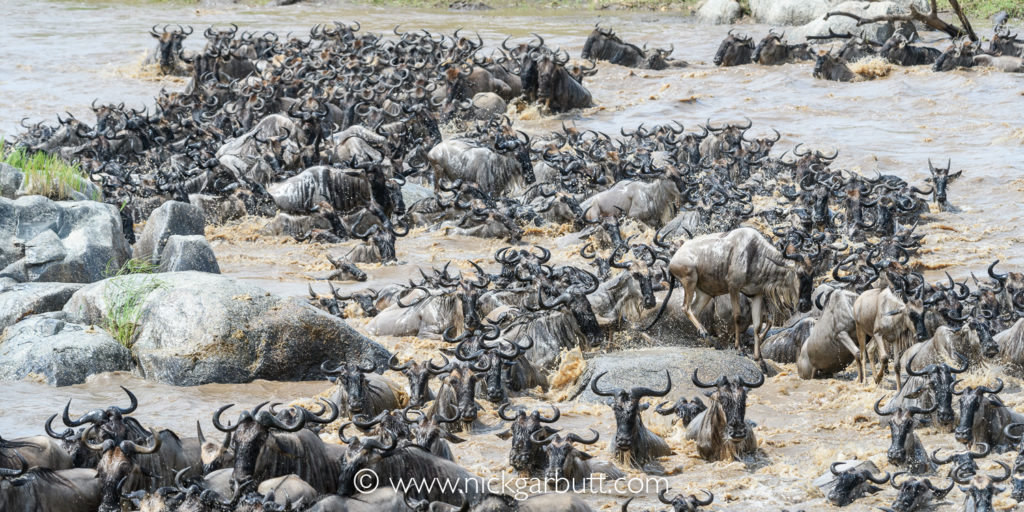
A herd of frenzied wildebeest crosses the swollen Mara River in the northern Serengeti.
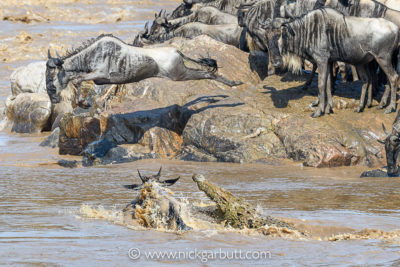
A huge Nile crocodile attacks a hapless wildebeest as it crosses the Mara River
This tour begins in the Ngorongoro Crater: no trip to northern Tanzania would be complete without visiting this natural wonder. It is East Africa in microcosm: an exceptional place where tolerant and varied wildlife can be viewed in close proximity. The Crater is one of the best location to see majestic bull elephants, many still sporting impressive tusks and also black rhino (although they are more challenging to find in the dry season). There are several prides of lions and their constantly changing dynamic often means there is a chance of seeing interesting behaviour and interaction. The early morning and late afternoon light in the Crater is often dramatic, with the awe-inspiring backdrop creating scenes of compelling grandeur.
In addition we also visit the Ndutu area at the boundary of the Serengeti National Park and Ngorongoro Conservation Area which is one of the finest photographic locations in East Africa, not only because of the diverse and abundant wildlife but also because of the capability to drive off-road and manoeuvre into optimal positions. Here the vast open plains are broken by extensive areas of acacia woodland with lakes and marshes that are always home to prides of lions, cheetahs and leopards. Also in recent years there have been increasing sightings of painted dogs in the area, that are gradually making a come back and returning to the Serengeti. In August and September the region is normally dry, but nonetheless always offers excellent wildlife viewing and photography.
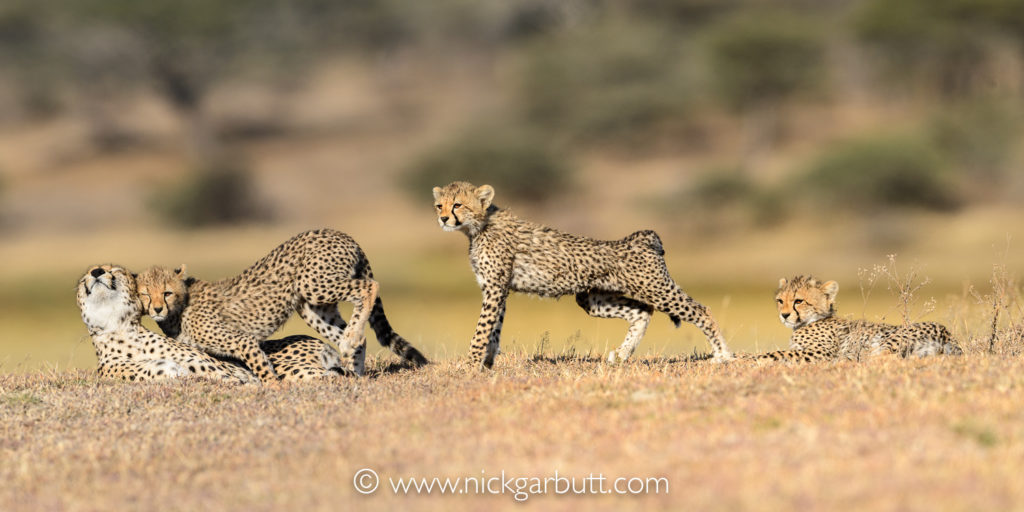
The Ndutu area is one of the Serengeti's prime hot spots. Even in the dry season it is an excellent place to view wildlife and is arguably one of the very best locations to see and photograph cheetahs.
Photography on Tour
Our time in the northern Serengeti very much concentrates on maximising photographic opportunities at river crossings. These are unpredictable events and it is often necessary to wait for considerable periods (several hours) at potential crossing locations, while numbers of wildebeest build up before they decide to cross. Other opportunities tend to focus on looking for cats (particularly leopards and lions) around rocky outcrops (kopjes) early in the morning.
In addition, river crossings can be dramatic, sometimes rather harrowing events to witness. Wildebeest may be taken in plain view by crocodiles, others become distressed and drown and some that successfully cross the river, then scramble up the bank and emerge with a broken leg. This really is nature red in tooth and claw.
There is a broader breadth of 'more typical' East Africa photographic opportunities around Ndudu, hence our extended stay in this area and the visit to the Ngorongoro Crater.
Bearing this in mind, this tour is perhaps better suited to those who have already been to East Africa at least once previously, and who want to concentrate on photographing more specialised events and behaviours.
Click: contact Wildlife Worldwide to book this tour
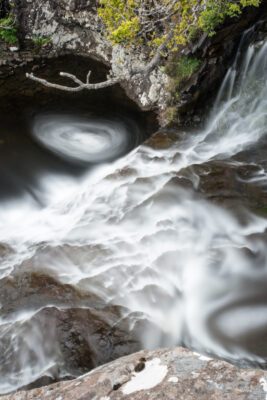
Using a very long exposure (5 minutes) to create something different at Eas Fors waterfall © Nick Garbutt
Dates: TBC
Price: £TBC (Twin-share)
Maximum Group 12
Current Availability: Please Enquire
LEADERS: Nick Garbutt & Alex Hyde
 GRADING: Easy. Short to moderate walks up to 1km (longer walks optional) and boat trips. Short, steep incline and uneven terrain and cliff edges on one coastal path. You must be able to carry your photography equipment on walks.
GRADING: Easy. Short to moderate walks up to 1km (longer walks optional) and boat trips. Short, steep incline and uneven terrain and cliff edges on one coastal path. You must be able to carry your photography equipment on walks.
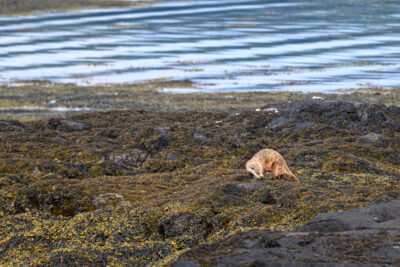
There is a good chance of seeing otters along the shoreline, but getting good photos can be a challenge © Nick Garbutt
For several years, Alex Hyde and myself (along with friend Chris Mattison) ran successful photography workshops to Mull. We were reluctantly forced to stopped because of changes in circumstances beyond our control that impacted on the quality of the trip. In conjunction with Wildlife Worldwide, we have now found solutions, so we are now able to offer these trips again, with significant improvements to the way they are run.
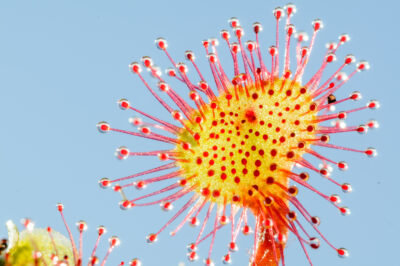
Close-up study of a round-leaf sundew © Nick Garbutt
The Isle of Mull offers some of the finest wildlife watching and photography options in the UK. From the comfort of Knock House, on the Benmore Estate, we will experience the many facets of this beautiful island. Over the course of our week-long stay we will explore Mull, on foot, by vehicle and by boat and have the opportunity to try out and practice a variety of photographic techniques. With luck we should be able to capture images of a diverse range of birds, flowers, plants, habitats and, with luck, perhaps mammals.
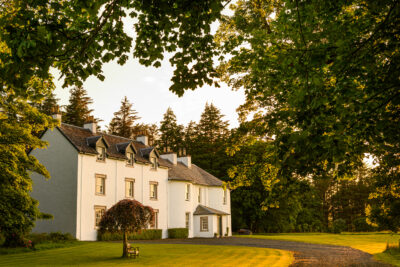
A beautiful house in a stunning location: our base, Knock House on the Benmore Estate © Nick Garbutt
A boat trip to the neighbouring Treshnish Isles will take in the Isle of Staffa and Fingal’s Cave before moving onto the Isle of Lunga where there will be opportunity to spend time with and photograph at close quarters one of the UK’s most charismatic seabirds, the puffin, together with huge numbers of guillemots, razorbills, shags and fulmars. Lunga offers a ‘Galapagos” type experience, where tolerant endearing birds can surround you on all sides. We have arranged an extended stay on Lunga to maximize opportunities, if the weather is kind. During the voyage out to and back from the isles, there is a chance of also seeing basking sharks and possibly cetaceans like dolphins and minke whales.
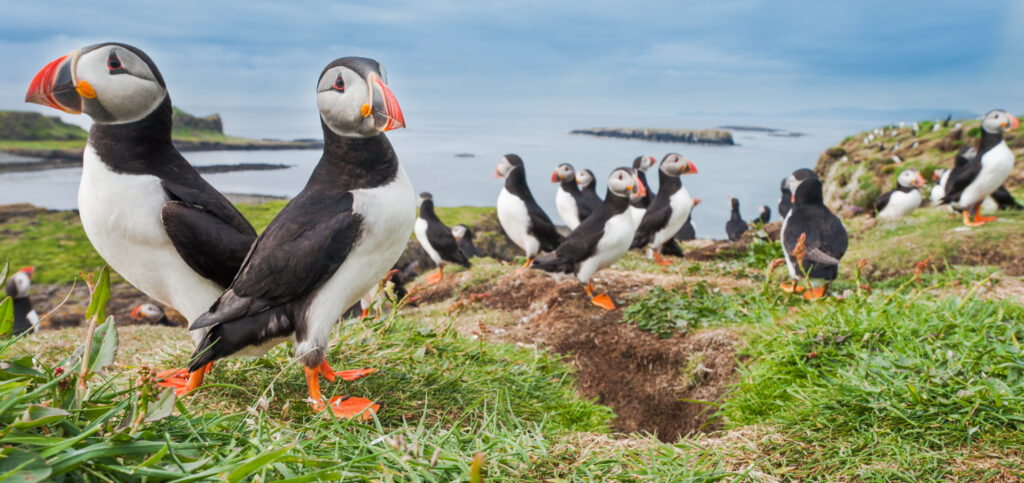
Lunga, one of the Treshnish Isles is home to some spectacular and accessible sea bird colonies: here puffins congregate on the cliff top © Nick Garbutt
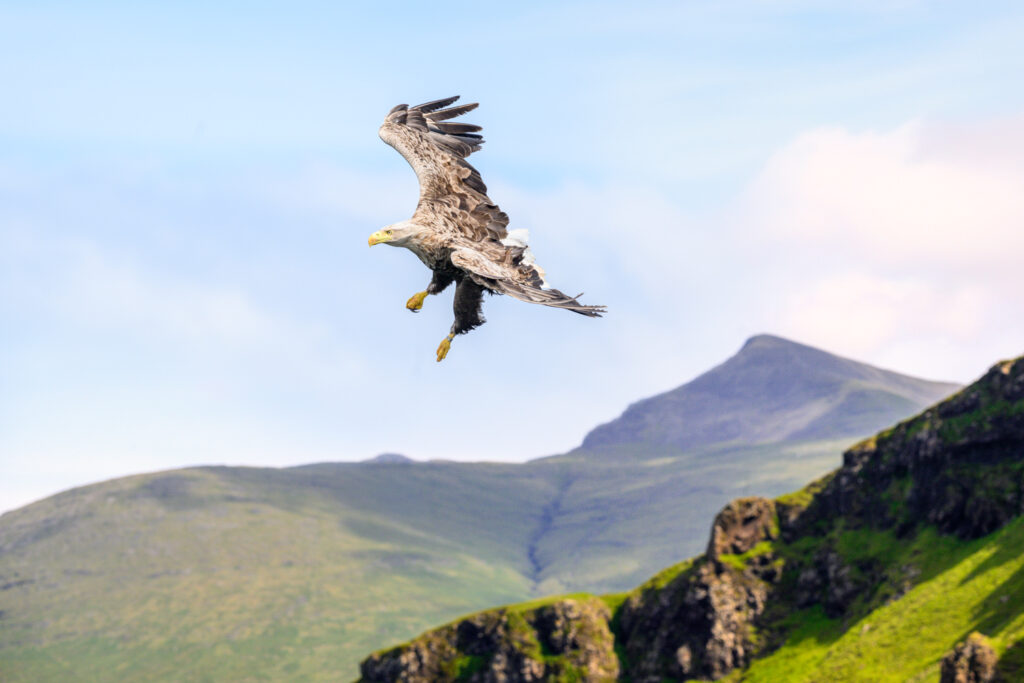
A white-tailed eagle with Ben More in the background © Nick Garbutt
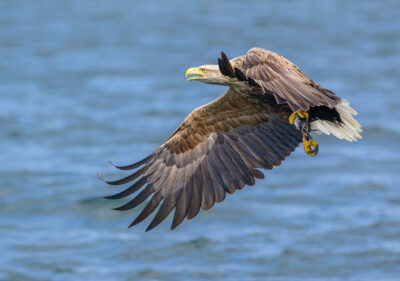
Seeing white-tailed eagles at close quarters is one of the trip highlights and provides some wonderful action photo opportunies © Nick Garbutt
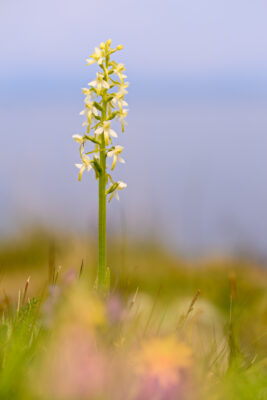
A lesser butterfly orchid on a cliff top © Nick Garbutt
A separate half day exclusive boat charter will provide opportunities to photograph spectacular white-tailed eagles, as well as perhaps both harbor and grey seals. This excursion around the in-shore waters of Loch Na Keal, often also reveals huge aggregations of moon jellyfish, which can provide some unexpected photo opportunities. We will also visit the charming Isle of Ulva, a haven for seals, otters and a variety of other wildlife. The island also offers plenty of macro photography opportunities with over 500 species of plant recorded including several rare orchids alongside some stunning sea-shore life.
With exclusive use of Knock House and access to the entire Benmore Estate, including some remote glens rarely visited by the general public, this trip to Scotland’s 'Eagle Island' offers a wealth of experiences and the opportunity to advance your photographic skills and repertoire.
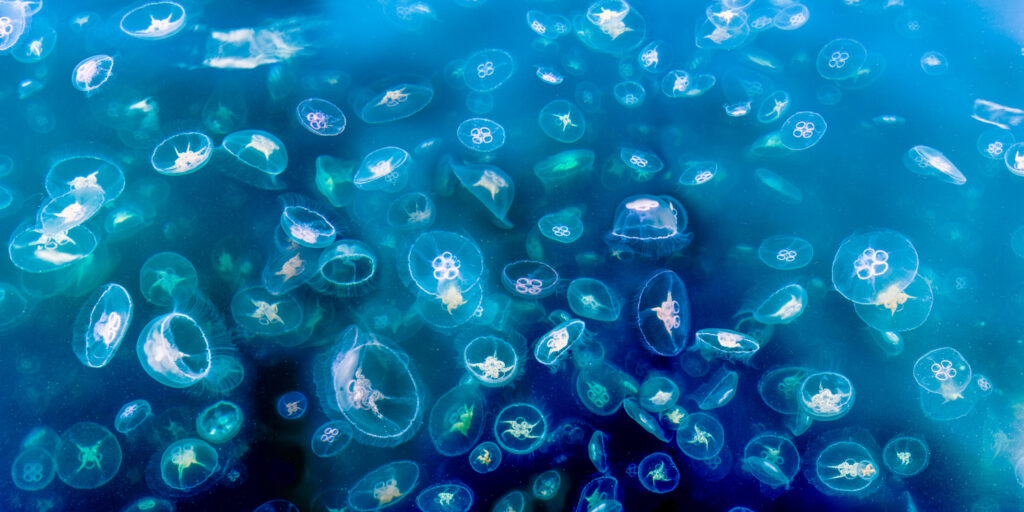
Summer sometimes brings huge swarms of moon jellyfish into Loch Na Keal. In calm conditions they can be photographed through surface © Nick Garbutt
 Photography Equipment
Photography Equipment
Mainly macro and wideangle, with some telephoto. A standard macro lens e.g. 105mm and close-focus wideangle are required for sea shore, plants and invertebrates. Also a telephoto zoom e.g. 100-400mm or 500mm for white-tailed eagles, sea birds and some flowers. A tripod is recommended.
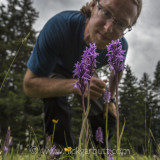
Alex Hyde and Broad-leaf Marsh Orchid
Alex Hyde
I am delighted to be joined by good friend Alex Hyde on this trip. Alex is one of the UK's finest exponents of macro photography, combining the best of art and science into his exquisite images. He is a master of the technical aspects of digital photography and in the field or indoor workshop environment has the enviable skill of being able to convey challenging topics and ideas, concisely, simply and in a way that makes them understandable. To see more of Alex's stunning work click here
Click: contact Wildlife Worldwide to book this tour
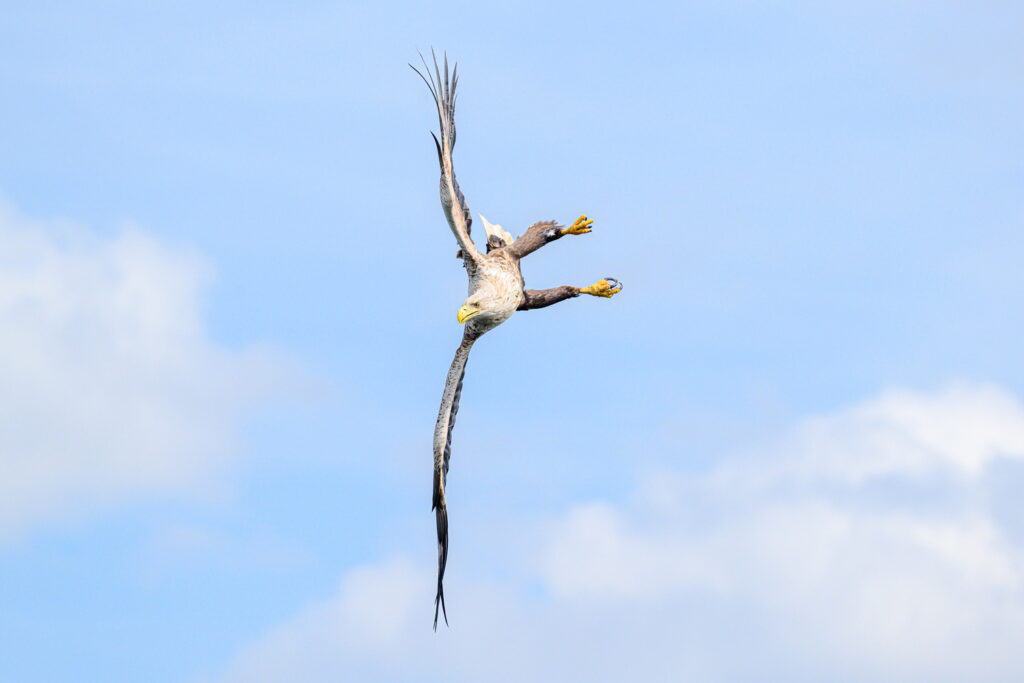
The agility and acrobatic capabilities of a white-tailed eagle on full display © Nick Garbutt
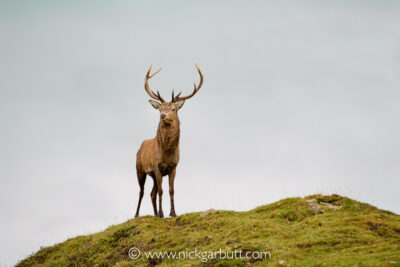
Male red deer. Exmoor in early November is a prime time to see these magnificent animals in full rut.
Dates: TBC
Price: £TBC (Twin-share): SRS: £TBC
Maximum Group 6
Current Availability: Please Enquire
LEADERS: Nick Garbutt with Daphne Brace
Located on the north coast of Somerset and Devon, Exmoor is a unique landscape shaped by both nature and humans over thousands of years. It is one of southern Britain’s finest ‘wilderness’ areas, with large tracts of open moorland, spectacular coasts with precipitous cliffs and deep valleys cloaked in ancient woodlands. All combine to form a rich and distinctive mosaic and landscape. These diverse habitats provide a home for an impressive array of wildlife, including majestic red deer, roe deer, rare raptors, a wealth of bird life, elusive otters and some of the UK’s rarest butterflies and bats.
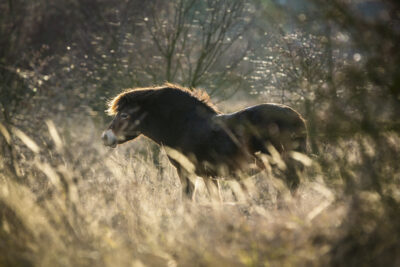
Feral Exmoor ponies are an ancient rare breed
Equally iconic are Exmoor ponies, one of a number of British native rare breeds. They are semi-feral, with herds free to roam over the moor, but all are owned and managed. There are around twenty different herds on the various commons of Exmoor.
Of course, Exmoor is not a true ‘wilderness’, rather it is a living and working landscape with several small towns, numerous picturesque villages and isolated hamlets and farmsteads. Many of these settlements have their origins in the Bronze Age and some even date back to Neolithic and Mesolithic times.
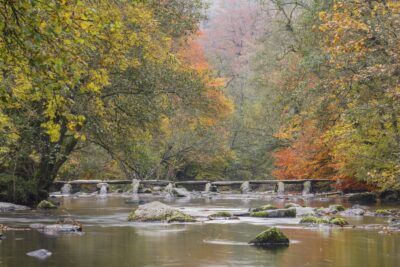
Tarr Steps, a historic 'clapper bridge' over the River Barle
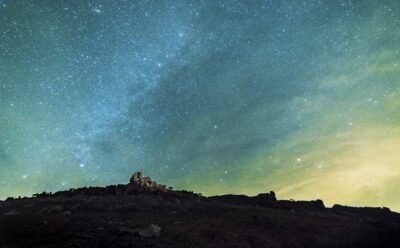
Starry Skies over Exmoor
These photo workshops have been timed to coincide with the red deer rut and we will have exclusive off-road access to some National Trust sites that offer some of the best potential viewing and photographic opportunities.
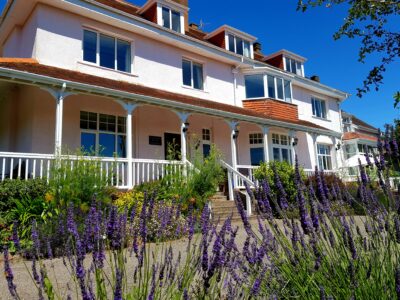
Dunkery Beacon Country House
This is also a time when the autumn colours across the various habitats of the moor are often at their best. Over the course of the workshop, we will hope to photograph majestic red deer stags and hinds, perhaps in both woodland and moorland settings. We will undoubtedly be able to photograph the hardy eponymous ponies and magnificent highland cattle and explore areas of ancient woodland where there will be plenty of options for captivating macro photography and impressionistic waterscapes.
Experiencing little light pollution, Exmoor is the best place in southern Britain for night sky viewing and, clear skies permitting, we hope to capitalise on this with some sessions of night and star photography.
The workshop will be hosted at the delightful Dunkery Beacon Country House Hotel, near Dunster.
Click: contact Wildlife Worldwide to book this tour
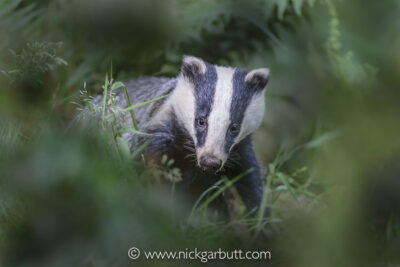
European Badger in woodland
Dates: TBC
Price: £TBC (Twin-share or single)
Maximum Group 12
Current Availability: Please enquire
LEADERS: Nick Garbutt and Alex Hyde
The rugged beauty of the Scottish Highlands offers the ultimate backdrop for a UK-based photographic workshop, with the Aigas Field Centre near Inverness, providing the perfect base. I have again teamed up with friend and renowned macro expert Alex Hyde.
Aigas is renowned for celebrating and conserving Scotland’s wildlife. The estate boasts a variety of habitats – ancient pine forests, secluded woodlands, tranquil lochs - and is home to numerous iconic species and within easy reach are other locations and landscapes like Glen Affric and the Beauly Firth and Moray Firth, that offer further wildlife diversity. Surrounded by early summer new growth and vibrance, this is an ideal time to visit. Above crags on open hillside golden eagles soar and peregrines stoop. In quieter corners, numerous hides offer opportunities to photograph many resident species including red squirrels, pine martins, badgers and crested tits.
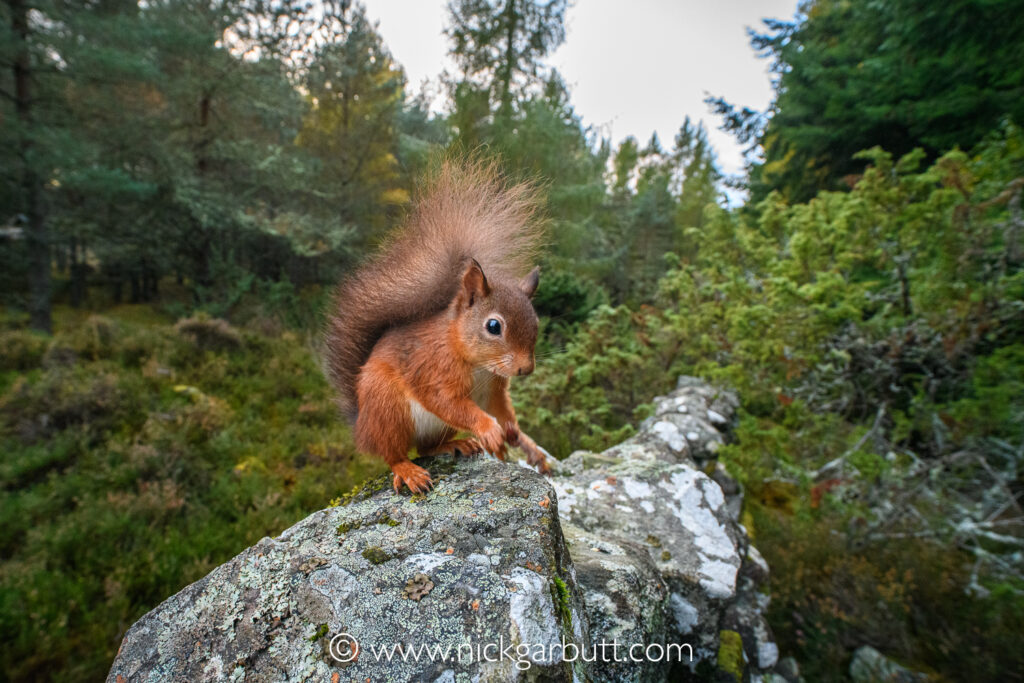
Adult red squirrel foraging on dry stone wall. Aigas Field Centre
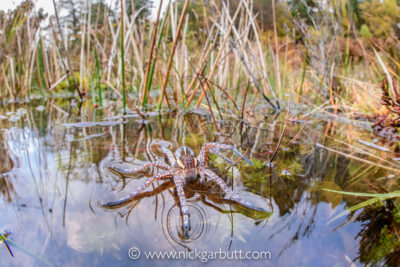
Female raft spider on small moorland pond. Glen Strathfarrar.
Whether a beginner or a more proficient photographer you will receive expert guidance thoughout and with group size limited to 12, the aim is to maximise your tuition time.
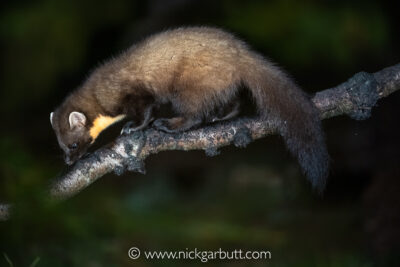
European pine marten. Aigas Field Centre.
To augment the photographic expertise, you will also be accompanied by estate naturalists who will provide expert knowledge on the local wildlife and fascinating history of Aigas. Education and conservation are pivotal features of the Aigas philosophy, with their team centrally involved in Eurasian beaver re-introductions (including on the estate) and captive-breeding of critically endangered Scottish wild cats, which will hopefully begin being reintroduced back to the wild in 2022. There will be ample opportunity to learn about the many challenges these projects face in order to achieve success.

Alex Hyde
I am delighted to be joined by good friend Alex Hyde on this trip. Alex is one of the UK's finest exponents of macro photography, combining the best of art and science into his exquisite images. He is a master of the technical aspects of digital photography and in the field or indoor workshop environment has the enviable skill of being able to convey challenging topics and ideas, concisely, simply and in a way that makes them understandable. To see more of Alex's stunning work click here
Click: contact Wildlife Worldwide to book this tour
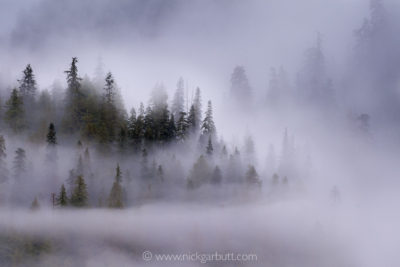
Early morning mist hanging over Pacific coastal forest
 Dates: TBC
Dates: TBC
Price: £TBC (Twin-share: Flights inclusive)
Price: £TBC (Twin-share: Land Only)
Single Supplement: NA
Maximum Group Size: 12
Current Availability: Provisional names being taken
Few places in the world are as evocative, ethereal and scenically spectacular as the central coastal region of British Columbia. This mosaic of forests, islands, fjords and mountains is intricately entwined in the history and culture of the native First Nation peoples and its protection has led to the region becoming known as the ‘Great Bear Rainforest’.
The region's lush, temperate coastal forests are dominated by western hemlock, sitka spruce and red cedar, and these forests in turn support a wealth of wildlife. Renowned for its healthy populations of grizzly bears, black bears and locally endemic spirit bears, this area is also home to a diversity of other terrestrial and marine species – five types of salmon, wolves, mountain lions, numerous species of whales, sea lions, seals and various types of deer.

At a couple of locations we will look for 'spirit' bears, a locally endemic form of the black bear.

A humpback whale dives in deep water channel
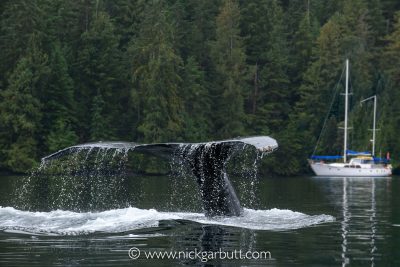
A humpback dives close to our yacht
Being such a remote and rugged area, the logistics of travel in the Great Bear Rainforest can be involved and time-consuming. Hence, the most practical and enjoyable way to explore the region is from the comfort of a live-aboard boat.
Aboard our chartered motor yacht ‘Island Roamer’, we will be able to cruise the sheltered waterways accompanied by an expert local naturalist guide. This will give us maximum flexibility to investigate different locations and linger in those places that prove most productive.
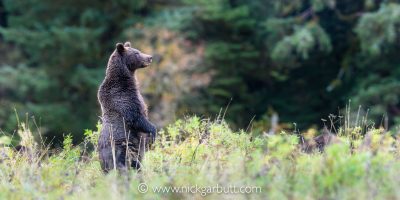
An inquisitive female grizzly in Mussel Inlet
As we journey between favoured spots, there will be ample opportunity to watch for wildlife, both in the sea and along the shorelines and estuaries. Daily shore excursions using zodiac’s, and shore and forest walks will allow us to fully experience the unrivalled richness of this part of Canada’s Pacific Coast.
In addition, to maximise bear photography opportunities, will spend time at a remote floating lodge at the southern edge of the Great Bear Rainforest, where a number of close and accessible sites that offer excellent grizzly and black bear viewing. A number of strategic platforms and hides provide excellent photographic opportunities at prime bear locations where a considerable intimacy and variety of shots is achievable.
Click: contact Wildlife Worldwide to book this tour
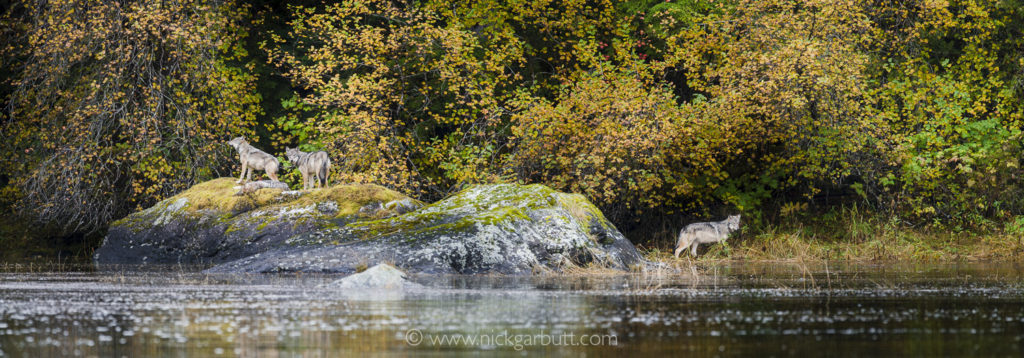
Coastal timber wolves resting on the shoreline
Testimonials
"We've been traveling with Nick for sixteen years, and have been lucky enough to have had some of the most wonderful animal encounters in awe inspiring locations, from Orang-utans and Proboscis Monkeys in Borneo, Jaguars in the Pantanal and the Wildebeest migration in Tanzania to the tiny things like pygmy chameleons and Giraffe-necked Weevils in Madagascar. No matter how big or small the subject, Nick will encourage and give advice on how to photograph it with unending patience and good humour.
Not a moment of any day is wasted often starting before dawn to perhaps admire the sunrise on Mount Kinabalu in Borneo and ending well after dusk maybe staking out an Aye-aye nest in Madagascar. And then there's the photo editing tuition if wanted in between. Every day is a new adventure and we can't wait for the next trip."
Jan and Nick, Madagascar 1998 & 2014, Tanzania 2000 & 2006, Borneo 2008, Pantanal 2011 etc.
"We did want to sing Nick's praises in respect of our Serengeti trip. It is perfectly possible to go on a NG Wildlife Photography trip when you don't know anything at all about photography!! He is patience personified and he set about explaining what we needed to do to draw maximum benefit from the trip. I don't know whether or not it is his custom to organise tutorials during any free time, but this he offers very willingly and we simply could not have had a better teacher.
On the wildlife side of things, he is just awesome, so knowledgeable that you have faith in him right from the outset, and he never appears to tire of questions even after 14 days!
Our whole trip was also significantly complemented by Jombi and Faizal who could not have tried harder to present for us the best viewing spot, who were extremely knowledgeable in their own right and who were frankly an absolute joy to be with."
Jan and Paul, Tanzania 2014
"A fantastic trip, and we would repeat it in a heartbeat if only we could! This was our first trip with Nick, but won't be the last. Nick is great trip leader, and a thoroughly nice person to boot. He works tirelessly to get the most out of the trip for everyone and, where possible, to tailor content to the wishes of individuals.
Early mornings and late nights are mainstays of this experience, but the great thing is you can do as much or as little as you choose - be warned though; the wildlife is compulsive! We'd hoped for wild orang-utan and tarsier; we were incredibly fortunate to see both. And what magical encounters too, so much more than just 'a tick'. Add in frequent night walks that reveal an entirely new perspective, and you've a top drawer trip. Nick knows the areas extremely well, and uses excellent local guides. Food and accommodation is fine throughout, culminating in the wonderful Borneo Rainforest Lodge in Danum Valley - a wildlife traveller's heaven!"
Anne and Steve, Borneo 2014
"What a wonderful exciting and memorable trip to the Pantanal, with brilliant views of jaguars during the day and night, giant otters, caiman, capybara. birds & frogs - the list is endless !! Part of the trip included a visit to Iguassu Falls a definite must do.
Nick is an outstanding guide with incredible enthusiasm, patience and knowledge. He makes every effort to ensure that everyone has a close encounter of the wildlife kind which is unique and personal. Careful consideration is given to the welfare of the animals and minimising disturbance to the environment. Locations are carefully selected to give the best opportunities for intimate and rewarding wildlife experiences. The lodges were eco-friendly with lovely staff and enthusiastic guides. Photographic sessions were tailored to everyone's ability and were fun and informative.
A top quality trip!"
Barbara, Pantanal Tour 2012
"This was not an easy trip, and the word 'holiday' may not apply - BUT the reward was fully worth the effort! On our adventure we stayed in all manner of accommodation, from western-style with modern comforts, to remote and basic bush camps in the forest. Food was mixed too, but included the best chocolate mousse ever.
But there is no such variation when it comes to the quality of wildlife viewing! We saw things, special things - and very special things. From the astonishing diversity of geckos and chameleons, through numerous kinds of lemurs, to the most remarkable aye-aye encounter, that will remain with us for life.
Nick is a brilliant trip leader, as is his local guide Hery - they are a winning combination. Expect long days, long drives and aching muscles, coupled with stunning scenery, exceptional encounters and magical memories. Be prepared for an assault on your senses. The culture and people add an extra dimension to this trip too, especially in the more remote areas visited. There are many reasons why Nick is a terrific leader - his expertise and patience (notably before and during the trip), his enthusiasm and tireless commitment, and his sense of humour. Not insignificant, either, is his taste in restaurants and patisseries!"
Anne and Steve, Madagascar 2014
"Wonderful trip which lived up to expectations. Nick catered for our different photographic levels and interests and each of us came back having learnt new things an keen to learn more. The wildlife was abundant and there was a good variety of photographic opportunities. The guides Jombi and Faizal were terrific and their knowledge and enthusiasm really made the trip memorable. The combination of Nick and the guides and of course the wildlife made it a great trip"
Kathy & Brian, Serengeti Migration Tour 2014
"As a professional wildlife biologist, a very novice photographer and someone with little experience of organised tours, I was somewhat apprehensive about joining Nick's trip to Madagascar. I certainly needn't have worried. Nick's comprehensive knowledge of the island, its wildlife and his local contacts meant we were often well off the main tourist routes and had wonderful opportunities to see some of the rarer lemur species.
Our small group size allowed us to have some very intimate wildlife encounters. Whilst always conscious of animal welfare, we never felt rushed and were able to observe fascinating natural behaviours. I'll never forget the aye-aye tapping a tree trunk to find food.
Nick went the extra mile getting us up and dawn and out again after dark to maximise chances of finding wildlife and optimise conditions for photography. He took time to ensure everyone had a chance to take photos and was always happy to help where necessary - which was often in my case.
I have some fabulous memories, pretty good photos and I'm already planning my next trip!"
Jane, Madagascar, 2014
"Our tour with Nick was fantastic and we had so many incredible tiger sightings: even I got some great photos. Tigers, leopards, rhinos, wild dogs, bears, jackals and wild elephants are just a few of the animals we saw. We loved the whole trip."
Penny & Richard, India 2014
"We had a very good Tanzania trip with Nick Garbutt who was an excellent group leader, very helpful for those needing photographic assistance - he was always patient, kind and prepared to go the extra mile for us. We also had two first class guides, Jombi and Faizal whose experience, driving skills and knowledge of the wildlife provided us with the best chances of good photographs. I will say that following my first Wildlife Worldwide holiday I will not hesitate to travel with the company again. Well done."
Gloria, Tanzania 2014
"The whole trip was absolutely wonderful. The two Nicks (Mackman and Garbutt) were great, so patient and always there when we needed help. What an experience and a privilege to be supported by them, both at the top of their profession. I have not stopped talking about the trip since returning home."
Louise
"Thank you so much for the tour and all the photography and lightroom tips. You have a wonderful personality, enthusiasm and professionalism for leading the tours and obviously a lot of patience for all levels of experience"
Chris
"You are an exceptional teacher. It was a joy listening to you."
Jean
All Zambia Photo & Art Safari 2015
"My trip was organised by Wildlife Worldwide, and led by the brilliant Nick Garbutt, whose knowledge of the natural history of Borneo is second to none, and whose wildlife and photography skills led to some great images (although don’t mention Atlas Moth!). All in all a brilliant trip, and I can’t wait to return!"
Adrian, Borneo 2015
“The trip was outstanding and we felt privileged to be in such an unspoilt an area and it was such a thrill to see snow leopards. The guides were amazing in their ability to find the cats and to help us to follow them. As always ,Nick was the perfect tour leader, helping everyone with their photography and always considerate. How glad we are that even at our age, we were able to get there. Thank you to everyone who organised the trip.”
Felicity & Roger, Ladakh Snow Leopard Tour 2017
“Nick was fantastic thoughout. The guides at Singinawa were outstanding and the accommodation excellent. We really enjoyed our time at Godwad and had great experiences both with the leopards and also cultural.”
Jenny and Graham, India Wild Cats 2017
“I had an absolutely incredible trip to India. The wildlife, people, cultural experience and food were just perfect. A special mention to the guides at Kanha who were world-class and the managers at Godwad for going out of their way to making us feel welcome. Nick was a fabulous host. I always felt like I was in safe hands and this was very much appreciated. I will definitely be back!”
Jashika, India Wild Cats 2017
"Alex and Nick are always a pleasure to travel with and go above and beyond what is required to ensure the best possible experience."
Tim, Austria Photo Workshop 2018
"The tour leaders, Alex Hyde and Nick Garbutt were outstanding both in their knowledge and expertise in the subject of wildlife photography and in their ability to communicate their knowledge. Their easy going demeanour also added much to the holiday experience. The accommodation was also excellent, friendly and comfortable"
Richard, Austria Photo Workshop 2018
